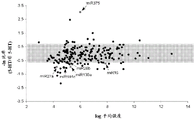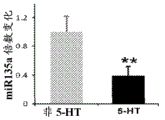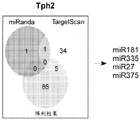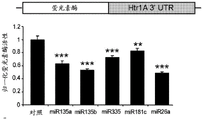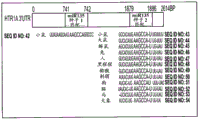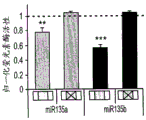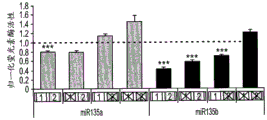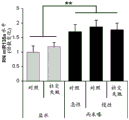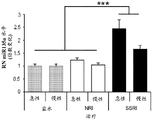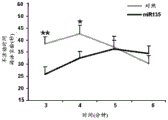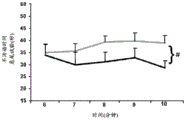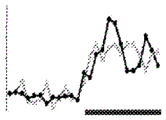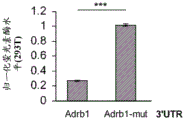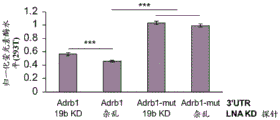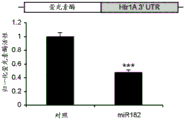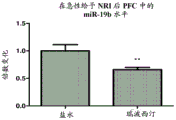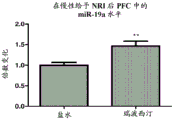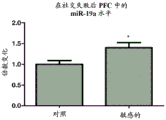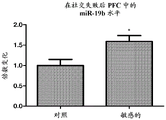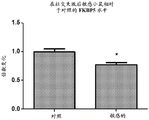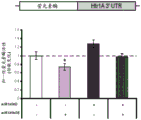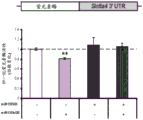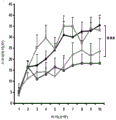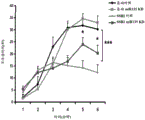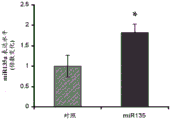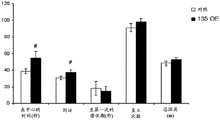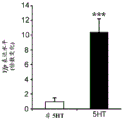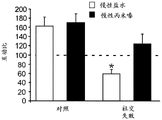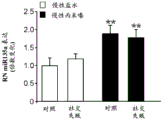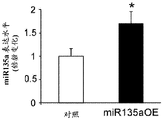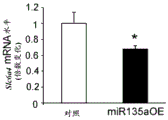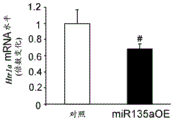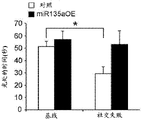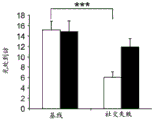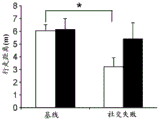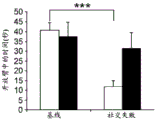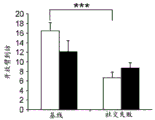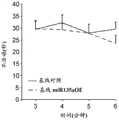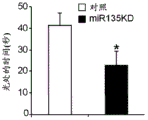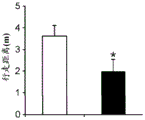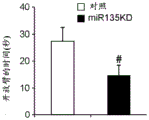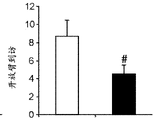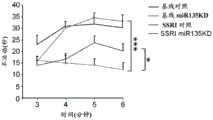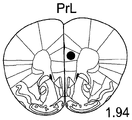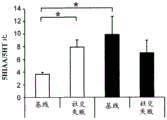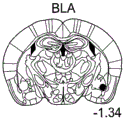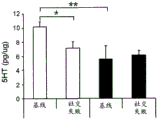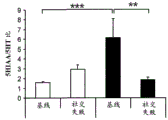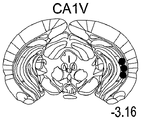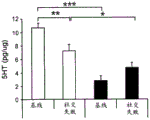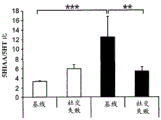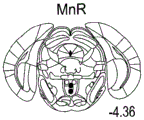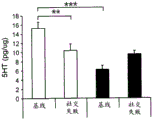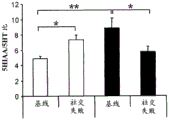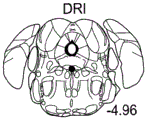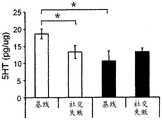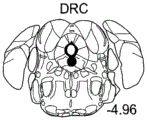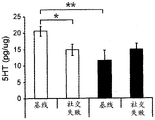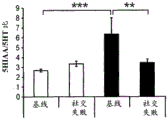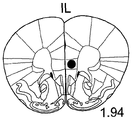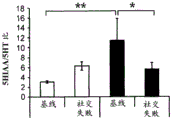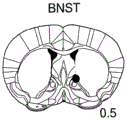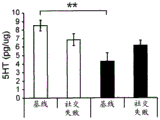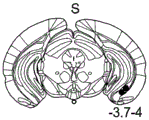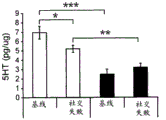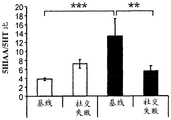CN106715695B - micro-RNAs for therapy and diagnosis and compositions comprising same - Google Patents
micro-RNAs for therapy and diagnosis and compositions comprising same Download PDFInfo
- Publication number
- CN106715695B CN106715695B CN201580018229.0A CN201580018229A CN106715695B CN 106715695 B CN106715695 B CN 106715695B CN 201580018229 A CN201580018229 A CN 201580018229A CN 106715695 B CN106715695 B CN 106715695B
- Authority
- CN
- China
- Prior art keywords
- mir
- seq
- expression
- protein
- antibody
- Prior art date
- Legal status (The legal status is an assumption and is not a legal conclusion. Google has not performed a legal analysis and makes no representation as to the accuracy of the status listed.)
- Active
Links
Images
Classifications
-
- A—HUMAN NECESSITIES
- A61—MEDICAL OR VETERINARY SCIENCE; HYGIENE
- A61P—SPECIFIC THERAPEUTIC ACTIVITY OF CHEMICAL COMPOUNDS OR MEDICINAL PREPARATIONS
- A61P25/00—Drugs for disorders of the nervous system
- A61P25/18—Antipsychotics, i.e. neuroleptics; Drugs for mania or schizophrenia
-
- A—HUMAN NECESSITIES
- A61—MEDICAL OR VETERINARY SCIENCE; HYGIENE
- A61P—SPECIFIC THERAPEUTIC ACTIVITY OF CHEMICAL COMPOUNDS OR MEDICINAL PREPARATIONS
- A61P15/00—Drugs for genital or sexual disorders; Contraceptives
- A61P15/10—Drugs for genital or sexual disorders; Contraceptives for impotence
-
- A—HUMAN NECESSITIES
- A61—MEDICAL OR VETERINARY SCIENCE; HYGIENE
- A61P—SPECIFIC THERAPEUTIC ACTIVITY OF CHEMICAL COMPOUNDS OR MEDICINAL PREPARATIONS
- A61P25/00—Drugs for disorders of the nervous system
- A61P25/20—Hypnotics; Sedatives
-
- A—HUMAN NECESSITIES
- A61—MEDICAL OR VETERINARY SCIENCE; HYGIENE
- A61P—SPECIFIC THERAPEUTIC ACTIVITY OF CHEMICAL COMPOUNDS OR MEDICINAL PREPARATIONS
- A61P25/00—Drugs for disorders of the nervous system
- A61P25/22—Anxiolytics
-
- A—HUMAN NECESSITIES
- A61—MEDICAL OR VETERINARY SCIENCE; HYGIENE
- A61P—SPECIFIC THERAPEUTIC ACTIVITY OF CHEMICAL COMPOUNDS OR MEDICINAL PREPARATIONS
- A61P25/00—Drugs for disorders of the nervous system
- A61P25/24—Antidepressants
-
- A—HUMAN NECESSITIES
- A61—MEDICAL OR VETERINARY SCIENCE; HYGIENE
- A61P—SPECIFIC THERAPEUTIC ACTIVITY OF CHEMICAL COMPOUNDS OR MEDICINAL PREPARATIONS
- A61P25/00—Drugs for disorders of the nervous system
- A61P25/28—Drugs for disorders of the nervous system for treating neurodegenerative disorders of the central nervous system, e.g. nootropic agents, cognition enhancers, drugs for treating Alzheimer's disease or other forms of dementia
-
- A—HUMAN NECESSITIES
- A61—MEDICAL OR VETERINARY SCIENCE; HYGIENE
- A61P—SPECIFIC THERAPEUTIC ACTIVITY OF CHEMICAL COMPOUNDS OR MEDICINAL PREPARATIONS
- A61P25/00—Drugs for disorders of the nervous system
- A61P25/30—Drugs for disorders of the nervous system for treating abuse or dependence
-
- A—HUMAN NECESSITIES
- A61—MEDICAL OR VETERINARY SCIENCE; HYGIENE
- A61P—SPECIFIC THERAPEUTIC ACTIVITY OF CHEMICAL COMPOUNDS OR MEDICINAL PREPARATIONS
- A61P43/00—Drugs for specific purposes, not provided for in groups A61P1/00-A61P41/00
-
- C—CHEMISTRY; METALLURGY
- C12—BIOCHEMISTRY; BEER; SPIRITS; WINE; VINEGAR; MICROBIOLOGY; ENZYMOLOGY; MUTATION OR GENETIC ENGINEERING
- C12N—MICROORGANISMS OR ENZYMES; COMPOSITIONS THEREOF; PROPAGATING, PRESERVING, OR MAINTAINING MICROORGANISMS; MUTATION OR GENETIC ENGINEERING; CULTURE MEDIA
- C12N15/00—Mutation or genetic engineering; DNA or RNA concerning genetic engineering, vectors, e.g. plasmids, or their isolation, preparation or purification; Use of hosts therefor
- C12N15/09—Recombinant DNA-technology
- C12N15/11—DNA or RNA fragments; Modified forms thereof; Non-coding nucleic acids having a biological activity
- C12N15/111—General methods applicable to biologically active non-coding nucleic acids
-
- C—CHEMISTRY; METALLURGY
- C12—BIOCHEMISTRY; BEER; SPIRITS; WINE; VINEGAR; MICROBIOLOGY; ENZYMOLOGY; MUTATION OR GENETIC ENGINEERING
- C12N—MICROORGANISMS OR ENZYMES; COMPOSITIONS THEREOF; PROPAGATING, PRESERVING, OR MAINTAINING MICROORGANISMS; MUTATION OR GENETIC ENGINEERING; CULTURE MEDIA
- C12N15/00—Mutation or genetic engineering; DNA or RNA concerning genetic engineering, vectors, e.g. plasmids, or their isolation, preparation or purification; Use of hosts therefor
- C12N15/09—Recombinant DNA-technology
- C12N15/11—DNA or RNA fragments; Modified forms thereof; Non-coding nucleic acids having a biological activity
- C12N15/113—Non-coding nucleic acids modulating the expression of genes, e.g. antisense oligonucleotides; Antisense DNA or RNA; Triplex- forming oligonucleotides; Catalytic nucleic acids, e.g. ribozymes; Nucleic acids used in co-suppression or gene silencing
-
- C—CHEMISTRY; METALLURGY
- C12—BIOCHEMISTRY; BEER; SPIRITS; WINE; VINEGAR; MICROBIOLOGY; ENZYMOLOGY; MUTATION OR GENETIC ENGINEERING
- C12Q—MEASURING OR TESTING PROCESSES INVOLVING ENZYMES, NUCLEIC ACIDS OR MICROORGANISMS; COMPOSITIONS OR TEST PAPERS THEREFOR; PROCESSES OF PREPARING SUCH COMPOSITIONS; CONDITION-RESPONSIVE CONTROL IN MICROBIOLOGICAL OR ENZYMOLOGICAL PROCESSES
- C12Q1/00—Measuring or testing processes involving enzymes, nucleic acids or microorganisms; Compositions therefor; Processes of preparing such compositions
- C12Q1/68—Measuring or testing processes involving enzymes, nucleic acids or microorganisms; Compositions therefor; Processes of preparing such compositions involving nucleic acids
- C12Q1/6876—Nucleic acid products used in the analysis of nucleic acids, e.g. primers or probes
- C12Q1/6883—Nucleic acid products used in the analysis of nucleic acids, e.g. primers or probes for diseases caused by alterations of genetic material
-
- C—CHEMISTRY; METALLURGY
- C12—BIOCHEMISTRY; BEER; SPIRITS; WINE; VINEGAR; MICROBIOLOGY; ENZYMOLOGY; MUTATION OR GENETIC ENGINEERING
- C12N—MICROORGANISMS OR ENZYMES; COMPOSITIONS THEREOF; PROPAGATING, PRESERVING, OR MAINTAINING MICROORGANISMS; MUTATION OR GENETIC ENGINEERING; CULTURE MEDIA
- C12N2310/00—Structure or type of the nucleic acid
- C12N2310/10—Type of nucleic acid
- C12N2310/14—Type of nucleic acid interfering N.A.
- C12N2310/141—MicroRNAs, miRNAs
-
- C—CHEMISTRY; METALLURGY
- C12—BIOCHEMISTRY; BEER; SPIRITS; WINE; VINEGAR; MICROBIOLOGY; ENZYMOLOGY; MUTATION OR GENETIC ENGINEERING
- C12N—MICROORGANISMS OR ENZYMES; COMPOSITIONS THEREOF; PROPAGATING, PRESERVING, OR MAINTAINING MICROORGANISMS; MUTATION OR GENETIC ENGINEERING; CULTURE MEDIA
- C12N2320/00—Applications; Uses
- C12N2320/30—Special therapeutic applications
-
- C—CHEMISTRY; METALLURGY
- C12—BIOCHEMISTRY; BEER; SPIRITS; WINE; VINEGAR; MICROBIOLOGY; ENZYMOLOGY; MUTATION OR GENETIC ENGINEERING
- C12Q—MEASURING OR TESTING PROCESSES INVOLVING ENZYMES, NUCLEIC ACIDS OR MICROORGANISMS; COMPOSITIONS OR TEST PAPERS THEREFOR; PROCESSES OF PREPARING SUCH COMPOSITIONS; CONDITION-RESPONSIVE CONTROL IN MICROBIOLOGICAL OR ENZYMOLOGICAL PROCESSES
- C12Q2600/00—Oligonucleotides characterized by their use
- C12Q2600/158—Expression markers
-
- C—CHEMISTRY; METALLURGY
- C12—BIOCHEMISTRY; BEER; SPIRITS; WINE; VINEGAR; MICROBIOLOGY; ENZYMOLOGY; MUTATION OR GENETIC ENGINEERING
- C12Q—MEASURING OR TESTING PROCESSES INVOLVING ENZYMES, NUCLEIC ACIDS OR MICROORGANISMS; COMPOSITIONS OR TEST PAPERS THEREFOR; PROCESSES OF PREPARING SUCH COMPOSITIONS; CONDITION-RESPONSIVE CONTROL IN MICROBIOLOGICAL OR ENZYMOLOGICAL PROCESSES
- C12Q2600/00—Oligonucleotides characterized by their use
- C12Q2600/178—Oligonucleotides characterized by their use miRNA, siRNA or ncRNA
Abstract
Methods of treating bipolar disorder in a subject in need thereof are disclosed. The methods comprise administering to the subject a therapeutically effective amount of a miR-135, a precursor thereof or a nucleic acid molecule encoding said miR-135 or said precursor thereof, thereby treating the bipolar disorder. Also disclosed are methods of diagnosing a mood disorder and monitoring treatment with an antidepressant or a medicament for treating a mood disorder in a human subject.
Description
Field and background of the invention
The present invention, in some embodiments thereof, relates to micrornas, and more particularly, but not exclusively, to the use of such micrornas for disease diagnosis, treatment and monitoring of treatment.
Mood disorders, such as major depressive and anxiety disorders, represent some of the most common and rapidly growing health problems worldwide affecting about 10% of the population. Despite decades of research, the mechanisms behind depressive episodes, susceptibility and available therapies are only partially understood. Currently only about one third of patients respond to available treatments and therefore, there is a strong need to better understand the pathology.
The current view on the etiology of depression is a complex interaction between environmental factors and genetic predisposition, suggesting a mechanistic role for the epigenetic process.
5-hydroxytryptamine (5HT) is a monoamine neurotransmitter produced in the brain by the nucleus Raphanus (RN) and is widely emitted throughout the brain to regulate various cognitive, emotional, and physiological functions. The link between deregulation of 5-hydroxytryptamine activity and depression has been well documented [ Michelsen KA et al, Brain Res Rev (2007) 55(2):329-42 ]. The level of 5HT, as well as the genetic circuits responsible for its production, secretion, reuptake and failure, are dysregulated in depression. Furthermore, most currently available antidepressant drugs target the function of 5HT system-associated proteins, resulting in elevated levels of 5HT in the synapses [ Krishnan V and NestlerEJ, Nature (2008) 455: 894-902]. Remission is observed after long-term administration of available therapy.
Micrornas (micrornas, mirs) are a class of endogenous, non-coding small (about 22 nucleotides) RNA molecules that inhibit gene expression post-transcriptionally. mirs are transcribed as primary miR molecules, which are processed in the nucleus into precursor mirs with stem-loop structures, which are exported into the cytoplasm, where they are further processed into active, mature mirs. The mature miR is then incorporated into the RNA-induced silencing complex, acting primarily through binding to the 3 'untranslated region (3' UTR) of a particular mRNA molecule. Binding is generated by a seed sequence (a 6-8 nucleotide sequence at the 5 'end of the miR) that pairs with a complementary seed match (seed match) sequence of the 3' UTR of the target mRNA. Binding of the miR results in direct mRNA destabilization or translational inhibition, ultimately leading to a decrease in protein levels of the target gene.
There are a large number of mirs in the nervous system, and initial studies have focused primarily on neurons in the context of development, cancer, and neurodegenerative disorders and normal processes (e.g., plasticity) [ Kosik KS. Nat Rev Neurosci (2006) 7:911-20 ]. Several miR screening studies report that miR levels in brain structures of different adult rodents or humans are affected by various behavioral and pharmacological manipulations [ O' Connor r. m. et al, Mol Psychiatry (2012) 17: 359-. In addition, mirs have been shown to play a role in psychiatric disorders such as schizophrenia, autism, and also depression and anxiety in both human and mouse models [ Miller BH and Wahlestedt C, Brain Res (2010) 1338: 89-99 ]. Several studies have recently shown that miR is involved in the regulation of 5 HT-associated genes [ Millan MJ. Curr Opin Pharmacol (2011) 11(1):11-22], suggesting an emerging role for miR in 5HT system regulation and its possible relationship to depression-associated disorders.
U.S. patent application No. 20100222413 (Stoffel m. et al) discloses chemically modified oligonucleotides for modulating microrna expression. U.S. 20100222413 further discloses methods for silencing micrornas (e.g., miR-122, miR-16, miR-192, and miR-194) for treatment of central nervous system diseases.
Summary of The Invention
According to an aspect of some embodiments of the invention, there is provided a method of treating a bipolar disorder in a subject in need thereof, the method comprising administering to the subject a therapeutically effective amount of a miR-135, a precursor thereof or a nucleic acid molecule encoding a miR-135 or a precursor thereof, thereby treating the bipolar disorder.
According to an aspect of some embodiments of the invention there is provided a use of a therapeutically effective amount of a miR-135, a precursor thereof or a nucleic acid molecule encoding a miR-135 or a precursor thereof for the manufacture of a medicament identified for treating a bipolar disease in a subject in need thereof.
According to an aspect of some embodiments of the invention there is provided an article of manufacture comprising a packaging material packaging an agent selected from a miR-135, a precursor thereof and a nucleic acid molecule encoding a miR-135 or a precursor thereof and a medicament for the treatment of bipolar disorder.
According to an aspect of some embodiments of the present invention there is provided a method of monitoring treatment of an antidepressant drug or a drug for the treatment of a mood disorder, the method comprising: (a) treating a human subject in need thereof with an antidepressant drug or a drug for the treatment of a mood disorder; and (b) measuring the expression level of miR-135 in the biological sample of the human subject before and after treatment, wherein a higher expression level of miR-135 after treatment with an antidepressant drug or drug for the treatment of a mood disorder as compared to the expression level of miR-135 before treatment with an antidepressant drug or drug for the treatment of a mood disorder indicates effective treatment.
According to an aspect of some embodiments of the invention there is provided a method of diagnosing a mood disorder in a human subject in need thereof, the method comprising measuring the expression level of miR-135 in a biological sample of the human subject, wherein a lower expression level of miR-135 as compared to that in a biological sample of a healthy human subject is indicative of the mood disorder.
According to an aspect of some embodiments of the invention, there is provided an isolated polynucleotide comprising miR-135, wherein miR-135 comprises a modification selected from the group consisting of a locked nucleic acid (L NA) and a 2' -Fluoroarabinooligonucleotide (FANA).
According to an aspect of some embodiments of the invention, there is provided an isolated polynucleotide comprising a modified miR135 selected from the group consisting of: 194, 195, 196, 197, 198, 199, 200, 201, 202, 203, 204, 205, 206, 207, 208 and 209 SEQ ID NO.
According to an aspect of some embodiments of the invention there is provided an isolated polynucleotide comprising a microrna selected from miR-335, miR-181, miR-182, miR-26, miR-27, miR-15 and miR-19, wherein the microrna comprises a modification selected from locked nucleic acid (L NA) and 2' -Fluoroarabinooligonucleotide (FANA).
According to an aspect of some embodiments of the invention there is provided a pharmaceutical composition comprising an isolated polynucleotide of some embodiments of the invention and a pharmaceutically acceptable carrier.
According to aspects of some embodiments of the invention, there are provided methods of upregulating glial cell expression selected from adenylate cyclase activating polypeptide 1(Adcyap or PACAP), adenylate cyclase activating polypeptide 1 receptor 1(Adcyap1 r), adrenergic receptor 2a (Adra 2), ankyrin 3 (ANK), activity modulating cytoskeleton-related protein (Arc), Rho GTPase activating protein 6 (Arhgap), activating transcription factor 3 (Atf), site APP cleaving enzyme 1 (Bace), type-dependent voltage calcium channel 01D subunit (Cacna 1), cell adhesion molecule 3 (Cadm), renaline 1 (Cplx), renaline 2 (Cplx), CUB and Sushi multiple domain 1 (Csmd), casein kinase 1 gamma 1 (Cnk 1G), bipierein protein (DcK), protein kinase, protein.
According to aspects of some embodiments of the invention, there are provided methods of down-regulating expression of a gene selected from the group consisting of adenylate cyclase activating polypeptide 1(Adcyap or PACAP), adenylate cyclase activating polypeptide 1 receptor 1(Adcyap1 r), adrenergic receptor 2a (Adra 2), ankyrin 3 (ANK), activity modulating cytoskeleton-related protein (Arc), Rho GTPase activating protein 6 (Arhgap), activating transcription factor 3 (Atf), site APP cleaving enzyme 1 (Bace), type-dependent voltage calcium channel 01D subunit (Cacna 1), cell adhesion molecule 3 (Cadm), renalin 1 (Cplx), renalin 2 (Cplx), CUB and Sushi multiple domain 1 (Csmd), casein kinase 1 gamma 1 (Cnk 1G), bipierein (Dcx x), DIRAS family-binding to the protein 2 (dics), protein kinase receptor kinase 5, protein kinase, protein receptor kinase, protein kinase receptor protein kinase, protein.
According to aspects of some embodiments of the invention, methods are provided for treating medical conditions in which an increase in 5-hydroxytryptamine levels is therapeutically beneficial in a subject in need thereof, the methods comprising administering to the subject an agent capable of down-regulating the activity or expression of a miR-135 target selected from the group consisting of adenylate cyclase-activating polypeptide 1(Adcyap or PACAP), adenylate cyclase-activating polypeptide 1 receptor 1(Adcyap1 r), adrenergic receptor 2a (Adra 2), ankyrin 3 (ANK), activity-regulating cytoskeleton-associated protein (Arc), Rho GTPase activating protein 6 (Arhgap), activating transcription factor 3 (Atf), site APP cleaving enzyme 1 (Bace), type-dependent calcium channel 01D subunit (Cacna 1), cell adhesion molecule 3 (Cadm), renain protein 1 (GABA x), renaline protein 2 (Calmetin-receptor kinase), protein kinase-kinase receptor kinase-related protein kinase, protein 1, protein 1, protein.
According to some embodiments of the invention, the medical condition is selected from the group consisting of bipolar disorder, depression, major depression, anxiety, stress, fatigue, impaired cognitive function, panic attack, obsessive compulsive behavior, addiction, social phobia, schizophrenia, sleep disorders, eating disorders, growth disorders, and reproduction disorders.
According to some embodiments of the invention, miR-135 is selected from miR-135a and miR-135 b.
According to some embodiments of the invention, miR-135 is represented by SEQ ID NO 58-62.
According to some embodiments of the invention, the miR-135 comprises the miR-135 shown in SEQ ID NO 192-193.
According to some embodiments of the invention, miR-135 comprises a modification selected from the group consisting of a modified sugar-phosphate backbone and a modified base.
According to some embodiments of the invention, miR-135 comprises a modification in both sugar and internucleoside linkages.
According to some embodiments of the invention, the modification is selected from the group consisting of phosphorothioate (phosphothioate), chiral phosphorothioate, phosphorodithioate, phosphotriester, aminoalkyl phosphotriester, methylphosphonate, alkylphosphonate, chiral phosphonate, phosphinate, phosphoramidate, aminoalkyl phosphoramidate, thionophosphoramidate, thionophosphonate, thionophosphoric triester, boronophosphorate (boranophosphate), phosphodiester, 2 '-O-methoxyethyl, 2' -O-methyl, 2 '-fluoro, locked nucleic acid (L NA), Peptide Nucleic Acid (PNA), and 2' -Fluoroarabinosucleotide (FANA).
According to some embodiments of the invention, miR-135 is shown in SEQ ID NO: 194-209.
According to some embodiments of the invention, the bipolar disorder is selected from the group consisting of bipolar I, bipolar II, rapid-cycling bipolar disorder, cyclothymia, and unclassified bipolar disorder (BD-NOS).
According to some embodiments of the invention, miR-135 is selected from the group consisting of SEQ ID NO 58, SEQ ID NO 59, SEQ ID NO 60, SEQ ID NO 61, and SEQ ID NO 62.
According to some embodiments of the invention, the miR-135 comprises miR-135 selected from the group consisting of SEQ ID NO: 192 and SEQ ID NO: 193.
According to some embodiments of the invention, miR-135 is selected from the group consisting of SEQ ID NO: 194, SEQ ID NO: 195, SEQ ID NO: 196, SEQ ID NO: 197, SEQ ID NO:198, SEQ ID NO: 199, SEQ ID NO: 200, SEQ ID NO: 201, SEQ ID NO: 202, SEQ ID NO:203, SEQ ID NO: 204, SEQ ID NO: 205, SEQ ID NO: 206, SEQ ID NO: 207, SEQ ID NO:208, and SEQ ID NO: 209.
According to some embodiments of the invention, the drug for the treatment of bipolar disorder is selected from the group consisting of lithium, antipsychotic drugs and mood stabilising drugs.
According to some embodiments of the invention, the method further comprises (c) treating the human subject when a higher miR-135 expression level is observed in step (b).
According to some embodiments of the invention, the method further comprises obtaining a biological sample from the human subject prior to the treatment.
According to some embodiments of the invention, the mood disorder comprises a bipolar disorder.
According to some embodiments of the invention, the antidepressant drug is selected from the group consisting of a selective 5-hydroxytryptamine reuptake inhibitor (SSRI), a tricyclic antidepressant, and a Norepinephrine Reuptake Inhibitor (NRI).
According to some embodiments of the invention, the medicament for treating mood disorders is selected from the group consisting of lithium, antipsychotic drugs, and mood stabilising drugs.
According to some embodiments of the invention, the biological sample is selected from the group consisting of whole blood, serum, plasma, and white blood cells.
According to some embodiments of the invention, the mood disorder is selected from the group consisting of bipolar disorder, depression, major depression, anxiety, stress, fatigue, impaired cognitive function, panic attack, obsessive compulsive behavior, addiction, social phobia, schizophrenia, sleep disorder and eating disorder.
According to some embodiments of the invention, miR-135 is selected from miR-135a or miR-135 b.
According to some embodiments of the invention, the subject is a human subject.
Unless defined otherwise, all technical and/or scientific terms used herein have the same meaning as commonly understood by one of ordinary skill in the art to which this invention belongs. Although methods and materials similar or equivalent to those described herein can be used in the practice or testing of embodiments of the present invention, exemplary methods and/or materials are described below. In case of conflict, the patent specification, including definitions, will control. In addition, the materials, methods, and examples are illustrative only and not intended to be necessarily limiting.
Brief Description of Drawings
Some embodiments of the invention are described herein, by way of example only, with reference to the accompanying drawings. Referring now in particular to the details of the drawings, it is emphasized that the details shown are by way of example and for purposes of illustrative discussion of embodiments of the invention. In this regard, the description taken with the drawings make apparent to those skilled in the art how the embodiments of the invention may be practiced.
In the drawings:
FIGS. 1A-I show microRNA expression in 5-hydroxytryptamine (5HT) neurons, FIG. 1A is a graph of differentially expressed miRNAs in 5HT neurons, L owess normalization is described as ln2 fold change in spot intensity plotted against mean log intensity (MA graph), FIG. 1B is a validation of array results in miR real-time PCR showing increased miR-375 levels in 5HT neurons compared to controls, N = 55 HT cells, N =4 non-5 HT. line shows mean ± s.e.m. P =0.0071, FIG. 1C is a validation of array results in miR real-time PCR showing decreased miR-135a levels in 5HT neurons compared to controls, N = 55 HT cells, N =4 non-5 HT, P =0.0075, FIG. 1D is a graph showing results using 5HT arrays and miR 6a4 predicted information for miR-targeting miR-RT arrays (FIG. 12) expressed in vitro using a-Ser-5 HT arrays and FIG. 1D is a graphical representation of predicted results using miR-T-luciferase cross-gene prediction information reported for miR-T arrays 27 and FIG. miR-T-RT assays using map 27, FIG. 1 and miR-T-Ser-1-5-HT arrays, FIG. 12 is a graphical representation of in vitro assay, and miR cross-miR-Mi map showing predicted results for in vitro assay results for miR-T-RT assays, and miR-RT assays using a, and miR-RT assays, and miR-RT assays, which are reported in vitro assay results, in vitro, in.
FIGS. 2A-H show microRNA targeting of the Slc6a 43 'UTR (SEQ ID NO: 25) and of the Htr1a 3' UTR (SEQ ID NO: 27). FIG. 2A is a schematic representation of miR-135a and miR-135b (SEQ ID NOS: 24 and 26, respectively) targeting of the Slc6a 43' UTR; FIG. 2B is a schematic representation of miR-135a and miR-135B (SEQ ID NOS: 24 and 26, respectively) targeting of the 3' UTR of Htr1a 3; FIG. 2C is a graph illustrating the results of luciferase reporter assays demonstrating that miR-135a and miR-135b can target the Slc6a 43' UTR. Luciferase assay data represent renilla luciferase (renilla luciferase) activity normalized to the activity of a co-transfected firefly luciferase reporter gene in HEK293 cells transfected with the 3' UTR of the above gene and either an empty vector or a vector overexpressing a particular miR. Lines represent mean ± s.e.m. P = 0.014, P = 0.0002 for miR-16 # P <0.0535, for miR-27 # P = 0.0967; FIG. 2D is a graph illustrating the results of luciferase reporter gene assays, demonstrating that miR-135a, miR-135b, miR-335, miR-181C and miR-26a can target the 3' UTR of Htr1a 3. P <0.0001, P = 0.0029; FIG. 2E is a graphical representation of miR-135 seed-matched slc6a 43' UTR conservation (SEQ ID NOS: 27-41); FIG. 2F is a graphical representation of the seed match (SEQ ID NOS: 42-54) of the Htr1a 3'UTR of miR-135, indicating that seed 1 is present only in the mouse 3' UTR and that seed 2 is highly conserved; FIG. 2G is a graph illustrating that miR-135 seed-matched mutations in the slc6a 43' UTR block the repressor action of miR-135a and miR-135 b. P <0.0001, P = 0.0032; and fig. 2H is a graph illustrating miR-135 seed matching in Htr1a 3' UTR alone and together with two mutations, showing that miR-135b targets Htr1a through two seed matching, while miR-135a targets Htr1a through seed 2 only. P < 0.0001.
FIGS. 3A-F show miR-135a and miR-135b levels under different conditions. FIG. 3A is a graph illustrating miR-135a level downregulation in RN following acute stress. Lines represent mean ± s.e.m. (n =8 in group 0, n =10 in 90-minute group, n =9 in 24-hour group,) P <0.0001,. P = 0.0357; FIG. 3B is a graph illustrating miR-135B level downregulation in RN following acute stress. P <0.0001, P = 0.0055; fig. 3C is a graph illustrating miR-135a level up-regulation in RN after acute and chronic imipramine administration independent of whether mice were exposed to social failure. (n =8 in control chronic saline and control chronic imipramine, acute imipramine n =7, social failure chronic saline n =11, social failure chronic imipramine n =9),% P = 0.003; fig. 3D is a graph illustrating miR-135b level up-regulation in RN after acute and chronic imipramine administration independent of whether mice were exposed to social failure. P = 0.0093; figure 3E is a graph illustrating elevated miR-135a levels in RN following acute or chronic administration of SSRI, rather than NRI or saline. (n =8 per group except acute saline n = 7) × P < 0.0001; FIG. 3F is a graph illustrating that miR-135b levels do not change in RN following acute or chronic administration of SSRI or NRI.
FIGS. 4A-H show miR-135b overexpression in vivo. FIG. 4A is a schematic of a lentivirus for overexpression of miR-135 b; FIG. 4B is a bar graph illustrating the results of real-time PCR demonstrating miR-135B overexpression in the Dorsal Raphe Nucleus (DRN) of adult mice. Lines represent mean ± s.e.m. (n =5 GFP injection, n =3 miR-135 OE), P = 0.0032; fig. 4C-D are graphical representations of DRN injection sites by showing GFP staining of injection sites. (using a cross-sectional view of Paxinos); FIG. 4E is a bar graph illustrating the reduction in time of inactivity in a forced swim trial in mice overexpressing miR-135b in RN compared to control mice. (n =9 control, n =9 miR-135), 3 min P = 0.0088, 4 min P = 0.00330; FIG. 4F is a graph illustrating the reduction in the time of inactivity in a tail overhang assay for mice overexpressing miR-135b in RN compared to control mice. P = 0.07351; FIGS. 4G-H are histograms illustrating that mice overexpressing miR-135b in RN compared to control do not differ in foster cage movement.
FIG. 5 shows the ADRb 13' UTR cloned after the luciferase gene. Schematic representation of the complete (top) ADRb 13 'UTR with 4 miR-19 binding sites and a mutant (bottom) version of the ADRb 13' UTR lacking all 4 miR-19 binding sites cloned downstream of the luciferase gene in the Psicheck2 plasmid.
FIGS. 6A-E show that miR-19b targets the ADRb 13 'UTR through seed matching on its 3' UTR; FIGS. 6A-B are histograms illustrating normalized luciferase levels measured in HT22 cells expressing low levels of endogenous miR-19 following transfection with (FIG. 6A) GFP plasmid or (FIG. 6B) pre-miR-19B Overexpression (OE) plasmid; FIGS. 6C-E are histograms illustrating normalized luciferase levels measured in HEK293T cells expressing high levels of endogenous miR-19. Control plasmids (FIG. 6C), miR-19b Knockdown (KD) or promiscuous probes (scarbambed probes) (FIG. 6D) were used as control transfections, and miR-19b MiArrest or control MiArrest plasmids (FIG. 6E) were used as control transfections. P < 0.005. Renilla luciferase activity was normalized by firefly luciferase expression levels and expressed as the ratio of activity achieved by a mutant form of Adrb1-3' UTR (Adrb1-mut) in the presence of control treatment.
FIGS. 7A-D show the differential expression of miRNA in amygdale (amygdale). FIGS. 7A-B are graphs illustrating the differential expression of miRNA in amygdala 90 minutes after acute stress. FIG. 7A illustrates the agilent array results. Fig. 7b illustrates affymetrix array results. Normalized values are described as log2 ratio of spot intensity (stress vs. control) plotted against the mean intensity across conditions (N =2, 2). The intensity of each miRNA was calculated as the average normalized intensity between each biological replicate. miR-15a and miR-15b are represented in red. miR-124, a well-documented neuronal marker unaffected by the stress regime, is represented in white; FIG. 7C illustrates that miR-15a and miR-15b have a semi-conserved seed match [ CRHR1, adapted from targetscan (dot) org ] on the corticotropin-releasing hormone type 1 receptor 3' UTR; FIG. 7D is a bar graph illustrating luciferase activity measured in HEK293T cells co-transfected with a miR-15b-EGFP overexpression plasmid or a GFP expression plasmid and a luciferase reporter plasmid controlled by a CRFR1-3' UTR. Renilla luciferase activity was normalized by firefly luciferase expression levels.
FIG. 8 is a bar graph illustrating the results of luciferase reporter gene assays, indicating that miR-182 may target the 3' UTR of Htr1a 3. Luciferase assay data represent renilla luciferase activity normalized to firefly luciferase reporter activity co-transfected in HEK293 cells transfected with the 3' UTR of the above gene and either an empty vector or a vector overexpressing a particular miR.
FIG. 9 is a bar graph illustrating real-time PCR results for miR-182 expression levels in adult mouse DRNs, showing a trend in decreased expression following chronic social failure. Data represent mean ± SEM, n =7 controls, 18 mice in the social failure group, # = p = 0.1.
Figure 10 is a venn diagram representing a computer bioinformatics prediction of miR-182 targeting in 2 algorithms and a list of potential target genes that appeared in the prediction to be highly correlated to normal and pathological neuronal function.
FIGS. 11A-C show overexpression or knockdown of miR-182. FIG. 11A is a schematic of lentiviruses used for miR-182 overexpression; FIG. 11B is a graph illustrating the real-time PCR results demonstrating miR-182 overexpression in vitro in the N2A cell line; FIG. 11C is a schematic of lentiviruses used for miR-182 knockdown.
FIGS. 12A-D show miR-19 levels in PFC after NRI administration. NRI reboxetine was given either acutely (once) or chronically (for 18 days). Notably, miR-19a and miR-19B levels decreased in PFC following acute NRI administration (fig. 12A and 12B, respectively), but increased following chronic NRI administration (fig. 12C and 12D, respectively).
FIGS. 13A-D show the levels of miR-19 in PFC and amygdala of mice experiencing social failure. miR-19a and miR-19b levels are measured in samples taken from amygdala from mice that have suffered from the social failure paradigm. Notably, miR-19a and miR-19B levels in PFCs were elevated in mice classified as "sensitive" to social failure compared to control mice (fig. 13A and 13B, respectively). miR-19 levels were also elevated in mouse amygdala classified as "sensitive" to social failure compared to control mice (fig. 13C and 13D, respectively).
FIG. 14 shows miRNA-19b targeting the CB 13' UTR. Transfection of HT-22 cells with CB 13' UTR and plasmids overexpressing miR-19b or GFP controls resulted in a 50% reduction in normalized luciferase levels.
FIGS. 15A-B are schematic representations of the coronal aspect of the mouse Brain FIG. 15A shows several nuclei in the Brain, including B L A (mouse Brain adapted from Paxinos and Franklin), FIG. 15B shows the CB1 distribution in the Brain (adapted from Allen Brain atlas in wwwdotm dotbarain-mapdotorg /), it is noted that this distribution in B L A is evident in the enrichment of CB 1.
Figure 16 is a schematic of the proposed mechanism of memory consolidation in the basolateral amygdala (B L a) Corticosterone (CORT) binds to the uncharacterized membrane-bound glucocorticoid receptor (mbGR) which activates the Gs-cAMP/PKA pathway to induce the synthesis of endocannabinoids (eCB) endocannabinoids (mbGR) are released into the synapse where they bind to the CB1 receptor at the end of γ -aminobutyric acid, inhibiting GABA release this inhibition of GABA release relieves the inhibition of Noradrenaline (NE) release and increases NE activation of the postsynaptic β -adrenoceptors, enhancing consolidation of adverse emotional memory.
FIGS. 17A-B illustrate Ago2 in a RISC complex. Fig. 17A is a schematic of Ago2 in a RISC complex that mediates the interaction between miRNA and mRNA; fig. 17B illustrates western blot analysis with anti-Ago 2 antibody. This IP was specific for Ago2 protein, as seen when comparing whole brain samples precipitated once with Ago2 antibody and once with IgG1 control. Notably, Ago2 protein was not detected in samples precipitated against IgG1 control.
FIGS. 18A-D show social avoidance experiments. Mice were habituated by placing them alone in the maze for 3 minutes (fig. 18A and 18B), and their movements were recorded and plotted. After 3 minutes, new ICR mice were placed in the chamber next to the test mice (fig. 18C and 18D), and the movements of the test mice were again recorded and plotted.
Figure 19A shows a hotspot plot of selected mirnas upregulated in the array.
Figure 19B shows a hotspot plot of selected mirnas down-regulated in the array.
FIGS. 20A-B show log2 expression of miR-15a (FIG. 20A) and FKBP5 (FIG. 20B) from microarray results, each red dot refers to one replicate of the array, there are 4 replicates in the control group (CNT), 3 replicates in the "sensitive" group (SUSC), 3 replicates in the "adaptable" group (RESI L), and the black line represents the mean of the replicates in each group.
Fig. 20C shows the 3' UTR sequence (obtained from targetscan. org) of mouse FKBP 5.
FIGS. 21A-B show the levels of amygdala miR-15a (FIG. 21A) and FKBP5 (FIG. 21B) in "sensitive" mice compared to control mice after social failure. Notably, miR-15a levels were elevated in the amygdala of mice that suffered from social failure and were termed "sensitive" (fig. 21A). Levels of FKBP5 were reduced in the amygdala of mice that suffered social failure and were termed "susceptible" (fig. 21B).
FIG. 22 is a schematic representation of the 3' UTR of Stx1a, Sgk1, and Adrb2, each with a single miRNA-15 binding site.
Figure 23 shows amygdala miR-181 levels in mice suffering from social failure compared to control mice. Notably, miR-181 levels were elevated in amygdala in mice suffering from social failure.
FIG. 24 shows a Venturi plot representing the cross-bioinformatic prediction of miR-181 and glutamate receptors.
FIG. 25 is a schematic of the complete 3' UTR of 6 potential targets of miR-181.
Fig. 26 shows the expression level of miR182 in the nucleus medialis after stress. Notably, acute 30 min brake stress resulted in decreased expression levels of miR182 in RN when tested 24 hours post-stress, as measured by real-time PCR. -P < 0.01; n =8 in each group.
Fig. 27-29 show the results of luciferase reporter assays, indicating that miR182 targets DSCAM, L1 CAM and TSNAX 3' UTR fig. 27 illustrates data from luciferase assays describing renilla luciferase activity normalized to the activity of firefly luciferase reporter co-transfected in N2a cells transfected with 3' UTR of the above genes and either empty vector or vector overexpressing a particular miR L1 CAM (fig. 28) and miR182 seed-matched mutations in TSNAX (fig. 29) 3' UTR block the inhibitory effect of miR182 (resyric effect). bars indicate mean ± s.e.m.. P <0.05,. P <0.01,. P < 0.001.
FIGS. 30A-E show the validation of miR135KD in vitro and in vivo. FIGS. 30A-B illustrate the results of luciferase reporter gene assays, indicating that miR135 targeting of Htr1a (FIG. 30A) and slc6a4 (FIG. 30B) is blocked by miR135B KD construct; FIG. 30C is a schematic of miR135bKD and a control viral vector; FIGS. 30D-E are graphical representations of DRN injection sites (FIG. 30D, using Paxinos), and FIG. 30E is GFP staining of DRN infected with miR135KD lentivirus.
Figures 31A-G show increased anxiety-like behavior and decreased response to SSRI in miR135KD mice. Figure 31A illustrates that miR135KD mice behaved similarly to control mice in the open field assay; figure 31B illustrates increased anxiety-like behavior in miR135KD mice compared to control mice in the elevated plus maze (elevewedpulse maze); figure 31C illustrates that miR135KD mice spent more time in the light room under basal stress conditions but not after acute stress than control mice in the bright-dark transition test; figure 31D illustrates that miR135KD mice visited the light room more times under basal stress conditions but not after acute stress, compared to control mice; figure 31E illustrates that miR135KD mice walked a smaller distance in the light compartment under basal stress conditions but not after acute stress as compared to control mice; fig. 31F illustrates that there was no difference between miR135KD mice and control mice in the tail suspension test in both basal conditions and after SSRI administration, however a reduction in the time of inactivity was observed following SSRI treatment compared to the basal conditions of both groups (fig. 31F-G). Inactivity time was reduced by SSRI in both groups, however the reduction in miR135KD mice slowed compared to controls in the last 2 minutes of the experiment. -p <0.1 = p < 0.05;. p = 0.01; p < 0.001. N =10-11 in each group.
Figure 32 is a schematic of miR135 mouse inducible overexpression system. Transgenic mice expressing stop flanked by prefluox sites before the sequence of miR135a and the GFP reporter were expressed. Mutant transgenic mice express miR135a only in 5-HT ePot positive cells.
FIGS. 33A-C show validation of mouse lines overexpressing miR135 in 5-HT neurons. Figure 33A illustrates miR135 overexpression in RN of miR135OE mice compared to control mice. Fig. 33B-C illustrate that miR135 target gene mRNA, both Slc6a4 (fig. 33B) and Htr1a (fig. 33C), were down-regulated in miR135OE mouse RN. # = p <0.1 = p <0.05; n =4 groups.
Figures 34A-E show a reduction in anxiety and depressive-like behavior in miR135OE mice after social failure. Figure 34A shows a reduction in anxiety-like behavior of miR135OE mice in the open field assay; figure 34B shows anxiety-like behavior in the bright-dark transition test compared to that of miR135OE mice; figure 34C shows decreased anxiety-like behavior in the elevated plus maze by miR135OE mice compared to controls; figure 34D shows the propensity of miR135OE mice to decrease in inactivity time compared to controls in tail suspension experiments; figure 34E shows the time of inactivity of miR135OE mice in the forced swim test compared to controls. # = p <0.1, = p <0.05, = p <0.01, n =7-11 in each group.
FIGS. 35A-D illustrate microRNA "fingerprinting" of 5HT neurons. (FIG. 35A) schematic representation of the experimental design for the determination of 5HT neuronal microRNA "fingerprinting". The post-embryonic brains of the ePot-EYFP mice were excised and FACS sorted into 5HT-YFP positive and YFP negative cells. Comparing miR expression from 2 populations using an Agilent microrna microarray; (fig. 35B-35D) validation of cell phenotype by real-time PCR, indicating that YFP (fig. 35B) and TPH2 (fig. 35C) were significantly enriched in 5HT and GAD67 (a gabaergic marker) was significantly higher in non-5 HT cells (fig. 35D) compared to non-5 HT cells. Lines represent mean ± s.e.m. P < 0.001.
FIGS. 36A-C illustrate evolutionary conservation of miR-135 variants. (FIGS. 36A-C) miR-135a-1 (FIG. 36A), miR-135a-2 (FIG. 36B) and miR-135B (FIG. 36C) are highly conserved throughout evolution, whereas the mature miR sequences highlighted in color are almost completely conserved. Data was modified from UCSC genome browser (Kent WJ, 2002).
FIGS. 37A-G illustrate miR-135 upregulation in adult mouse RN following antidepressant drug treatment. (FIG. 37A) comparison between mature miR-135a and miR-135b indicates a1 nucleotide difference; (FIG. 37B) expression levels of miR-135a and miR-135B in mouse RN; (FIG. 37C) expression profiles of several miRs in adult mouse RN indicate that the richness of miR-135a is about 1/5 of miR-124, which is 1/2.5 of miR-16. Lines represent mean ± s.e.m; (FIG. 37D) mice exposed to social failure showed increased social avoidance unless treated with chronic imipramine. The interaction ratio was calculated as the time spent in the near stranger mouse zone divided by the time spent in the same zone during habituation times 100. Lines represent mean ± s.e.m. P <0.05; (fig. 37E and 37F) miR-135a levels were upregulated in RN after chronic (fig. 37E) or acute (fig. 37F) promimizine dosing and did not change after exposure to a chronic social failure regimen. Lines represent mean ± s.e.m. P < 0.01; (figure 37G) SSRI, but not NRI or saline, caused a significant increase in miR-135a levels in RN after acute or chronic administration. Lines represent mean ± s.e.m. P < 0.001.
The specific overexpression of miR-135 in 5HT neurons, the schematic of the miR-135 conditional overexpression mouse model, the transgenic mice that add loxP sites on both sides of the transcribed STOP sequence upstream of miR-135a and GFP sequences, were crossed with the ePet-Cre recombinase mice, the transgenic mice that harbor miR-135a only and did not harbor the ePet-Cre transgene, the littermate mice were used as controls, (fig. 38B) the miR-135 Overexpression (OE) mice had increased miR-135a expression level up to about 2-fold in comparison to the control, the miR-135C 6a expression level in RN, the 12C and 38D) the miR-135-C6 a (12 a) showed no significant shift in the social networking test, the negative shift in the negative shift of the social networking test, the negative shift of the negative expression of the negative gene, the negative expression of miR-135. no miR-135. p.135. the negative expression of.
FIGS. 39A-N show that miR-135 knockdown in adult mouse RN causes increased anxiety-like behavior and reduced response to antidepressants (FIG. 39A) a schematic of "miR-135 Capture" structure, (FIG. 39B) a schematic of miR-135KD and a control viral vector, (FIG. 39C) miR-135KD lentiviral infection increases Htr1a and Slc6a4 mRNA expression levels in RN46a cells that endogenously express these genes and miR-135, (FIG. 39D) shows a cross-sectional view of the injection site, and the miR-135 mice spend less time in the light-compartment # s (FIG. 39E), less time in the open-field # S (FIG. 39F), less time in the parallel miR-135KD movement test (FIG. 39G), and less time in the parallel movement test (FIG. 39G), and show a more significant decrease in the total movement time in the open-field S movement test (FIG. 39H-135) when the miR-135K movement test is performed in the open-field P135. MiR + 35 cells that the genes and miR-135A slow virus expression levels in RN46 cells that endogenously express these genes and miR-135A < miR-135 < miR-A; mice, (FIG. 39E) and miR-135K show a less significant increase in the total movement test when the open-7K in the open field movement test (FIG. 39H) and the open-7 + 7H + 7.
Figures 40A-O illustrate that overexpression of miR-135 in 5HT neurons alters 5HT levels in the brain and blocks social failure-induced 5HT reduction (figures 40A, 40D, 40G, 40J, 40M) a schematic representation of miR-135OE5HT and microscopic cleavage sites in the control mouse brain under basal conditions or after chronic social failure Pr L-prepigmatic cortices, B L a-basolateral amygdala, CA 1V-ventral hippocampal CA1, DRV-mediastinal ventral nucleus, MnR-mediastinal nucleus, a profile taken from (Paxinos, 1997), (figures 40B, 40E, 40H, 40K, 40N) under basal stress conditions, 5HT levels at different brain sites measured by L C show a reduction in 5HT levels of miR-135 HT compared to control OE mice compared to baseline stress conditions, 5H levels in mice exposed to baseline stress conditions, 5a reduction ratio of miR-135 OE-135 to 5HT in mice exposed to baseline stress conditions, 5a reduction ratio of miR-135 to 5 oh, calculated from baseline stress regulation in mice under baseline stress conditions, 5a 5H, 40K, 40N, 5OE, 5 aa, 5-75G, 5H, 5OE, 5H, a reduction ratio of 5OE, 5H, 0, 75G, 0, 5H, 0, 5H, 0, 5H, 0, 5H, 5.
FIGS. 41A-E illustrate lower miR-135 levels in the blood of human depressed patients. (FIG. 41A) miR-135a levels in whole blood of human depressed patients are steadily decreased compared to healthy controls; (FIG. 41B) miR-16 blood levels did not differ significantly between groups. Lines represent mean ± s.e.m. P < 0.001; (fig. 41C) depressed patients treated with Cognitive Behavioral Therapy (CBT) for 3 months showed a significant increase in whole blood miR-135a levels; (FIG. 41D) miR-16 levels were similar in all patient groups. Lines represent mean ± s.e.m. P <0.05; (FIG. 41E) is a graphical representation of proposed models for the involvement of miR-135 in the modulation of 5-hydroxytryptamine synaptic components under normal conditions (top panel), depression (middle panel), and administration of antidepressants (bottom panel).
42A-L show 5HT levels in RN constructs of miR-135OE mice under "basal" conditions and after chronic stress conditions (FIGS. 42A, 42D, 42G, 42J) a graphical representation of RN microdissection sites from miR-135OE5HT and control mouse brain under basal conditions or after chronic social failure DRD-dorsal aspect of the nucleus, DRI-dorsal aspect of the nucleus, DRV L-lateral part of the dorsal nucleus, V L PAG-lateral part of the grey matter around aqueducts, DRC-dorsal flank of the nucleus, using a profile from (Paxinos G., 1997); FIGS. 42B, 42E, 42H, 42K) under basal stress conditions, in comparison to control, the 5HT 5 levels in all brain regions except DRV L are reduced in miR-135OE mice in comparison to basal stress conditions, in comparison to control, the 5HT 5 levels in social mice except for the DRV L are reduced in comparison to basal conditions, the 5HT 5 AA, the miR-135OE 5OE is calculated as a mean reduction in the social stress of miR-135OE 5OE construct, and the miR-135OE 5OE construct is calculated as a log 0.01 < HT 0.7. in chronic stress conditions, and a log 7. the chronic stress conditions.
FIGS. 43A-L show the 5HT levels in brain structures of miR-135OE mice under "basal" conditions and after chronic stress conditions (FIGS. 43A, 43D, 43G, 43J) under basal conditions or after chronic social failure, schematic representation of sites of microdissection from miR-135OE5HT and control mouse brain I L-lower peripheral cortex (infracortical cortices), BNST-terminal bed nucleus, CeA-central amygdala, S-subtotal.A. profile from (Paxinos G., 1997); FIGS. 43B, 43E, 43H, 43K) under basal stress conditions, the 5HT levels of all brain regions in miR-135 HT mice are reduced compared to control, additionally, the 5HT levels in control mice exposed to social failure are reduced compared to basal conditions, the effects in mice 135-135 OE 32 are lost, FIG. 43C, 43F, 43I, 43F, 43E, 43H, 43K) under basal stress conditions, the same ratio of 5HT levels in mice exposed to basal stress, the 5HT regions, and the score of the 5HT levels in mice is calculated as 0.01 < 5HT, and the mean value of the metabolic rate of miR-5 HT of the miR-135OE5 < 5H < 5 < 7 > AA < 7 > in a test.
FIG. 44 illustrates modification of miR-135 oligonucleotides. 5' Ph indicates 5' phosphorylation, while bold underlining indicates 2' O-methylation.
Description of specific embodiments of the invention
In some embodiments thereof, the present invention relates to micrornas, and more particularly, but not exclusively, to the use of such micrornas for disease, diagnosis, monitoring and treatment.
The principles and operation of the present invention may be better understood with reference to the drawings and the accompanying description.
Before explaining at least one embodiment of the invention in detail, it is to be understood that the invention is not limited in its application to the details described in the following description or exemplified in the examples. The invention is capable of other embodiments or of being practiced or carried out in various ways. Also, it is to be understood that the phraseology and terminology employed herein is for the purpose of description and should not be regarded as limiting.
The relationship between disturbances of 5-hydroxytryptamine activity and psychiatric disorders (e.g., anxiety and depression) has been previously demonstrated, but the molecular mechanisms underlying these pathologies are not fully understood. Micrornas (mirs) are a class of small RNA molecules that regulate post-transcriptional gene expression and are extremely abundant in the brain.
While reducing the present invention to practice, the present inventors have discovered that specific micrornas (mirs) are involved in the regulation of 5-hydroxytryptamine (5HT) glial-related genes, and thus in the regulation of medical conditions associated with abnormal 5-hydroxytryptamine levels, such as psychiatric disorders.
As shown below and in the accompanying examples section, the inventors determined miR expression patterns in 5HT neurons of the mesonuclear (RN) obtained from 5HT reporter mice (ePET-YFP) using miR microarrays (see table 2A-B in the accompanying examples section). bioinformatics analysis of miR expression profiles unique to 5-hydroxytryptamine neurons obtained from the arrays was performed to identify miR: 5-hydroxytryptamine transporters (Slc6A4, fig. 1D), 5-hydroxytryptamine autoreceptors (Htr1A, fig. 1E), tryptophan hydroxylase 2 (Tph2, fig. 1F) and monoamine hydroxylase (MaoA, fig. 1G). further testing miRNA 3' UTR targeting of these genes in vitro as a specific antagonist of miR-135 (see fig. 1H-135I) and monoamine hydroxylase (miR-1G) after in vivo inhibition of the activity of miR-19, miR-19, as a direct inhibition of the neuro receptor activity of miR-19, miR-19 inhibition of the acute stress-mediated by miR-2 miR-7-miR-7-miR-7-miR-7-miR-5-miR-7-5-miR-5-miR-7-5-miR-5-miR-related genes, miR-5-his or its-his map 35, his-his map 2-his map 35, his-his map 11-his.
While the inventors have further reduced the present invention to practice, the inventors have discovered that miR135 can be used as a potent therapeutic to treat bipolar disorder, affecting as much as 4% of people.
While the inventors have further reduced the present invention to practice, the inventors have found that miR-135 is significantly down-regulated in the blood of human depressed patients (compared to healthy controls), and up-regulated after the patient's psychiatric score improves. In fact, miR-135 was found to be the essential regulatory component responsible for maintaining the intact 5-hydroxytryptamine-competent state (serotonergicene) under normal conditions and necessary for the brain to respond to antidepressants (see the graphical model in fig. 41E).
Elevated levels of miR-135 were found to inhibit both Slc6a4 and presynaptic Htr1a levels, resulting in an increase in 5HT in the synaptic cleft, which was associated with decreased depressive symptoms. Further bioinformatic analysis by the inventors predicted novel targets for miR135 associated with neuropsychiatric disorders (including bipolar disorder) or lithium action. These targets are therefore useful as therapeutic interventions targeting neuropsychiatric disorders.
The assays of the invention further provide non-invasive tests for both screening patients for psychotic conditions and monitoring treatment. Taken together, these results classify miR-135 as a key tool for the diagnosis and management of psychotic states (e.g., mood disorders) where continuous monitoring of patient mental balance is critical.
Thus, according to one aspect of the present invention there is provided a method of treating a medical condition in which an elevated level of 5-hydroxytryptamine is therapeutically beneficial in a subject in need thereof, the method comprising administering to or expressing in a cell of the subject an exogenous polynucleotide encoding at least one microrna or a precursor thereof.
According to particular embodiments, the microRNA comprises miR-135, miR-335, miR-26 and miR-182 for treating a medical condition in which elevated levels of 5-hydroxytryptamine are therapeutically beneficial.
According to one aspect of the present invention, there is provided a method of treating a bipolar disorder in a subject in need thereof, the method comprising administering to the subject a therapeutically effective amount of a miR-135, a precursor thereof or a nucleic acid molecule encoding a miR-135 or a precursor thereof, thereby treating the bipolar disorder.
According to another aspect of the present invention, there is provided a method of treating a medical condition in which a low adrenaline or noradrenaline level is therapeutically beneficial in a subject in need thereof, the method comprising administering to or expressing in a cell of the subject an exogenous polynucleotide encoding a microrna or a precursor thereof.
According to a specific embodiment, the microRNA comprises miR-19 for the treatment of a medical condition in which a low adrenaline or noradrenaline level is therapeutically beneficial.
According to another aspect of the present invention there is provided a method of treating a medical condition in which a low corticotropin-releasing hormone (CRH) level is therapeutically beneficial in a subject in need thereof, the method comprising administering to or expressing in a cell of the subject an exogenous polynucleotide encoding a microrna or a precursor thereof.
According to a specific embodiment, the microrna comprises miR-15 for the treatment of medical conditions in which low corticotropin-releasing hormone (CRH) levels are therapeutically beneficial.
According to another aspect of the present invention there is provided a method of treating a medical condition in which a low glutamate receptor level is therapeutically beneficial in a subject in need thereof, said method comprising administering to or expressing in a cell of the subject an exogenous polynucleotide encoding a microrna or a precursor thereof.
According to a specific embodiment, the microrna comprises miR-181 for the treatment of medical conditions in which low glutamate receptor levels are therapeutically beneficial.
The term "treating" refers to inhibiting or arresting the development of a disease, disorder or condition and/or causing the disease, disorder or condition to be alleviated, alleviated or resolved or preventing the development of a disease, disorder or medical condition in a subject who may be at risk for the disease, disorder or condition but has not yet been diagnosed as having the disease, disorder or condition. One skilled in the art will appreciate that various methods and assays can be used to assess the development of a disease, disorder, or condition, and likewise, various methods and assays can be used to assess the remission, or regression of a disease, disorder, or condition.
The term "subject" or "subject in need thereof" as used herein includes mammals, such as humans, male or female of any age, suffering from or at risk of developing a pathology.
The phrase "medical condition in which elevated levels of 5-hydroxytryptamine are therapeutically beneficial" as used herein refers to a disease or disorder in which elevated levels of 5-hydroxytryptamine prevent the onset of a disease or medical symptoms associated therewith or terminate the progression of a disease or medical symptoms associated therewith (as described in further detail below).
The term "5-hydroxytryptamine" as used herein refers to monoamine neurotransmitters [ also known as 5-hydroxytryptamine (5-HT) ]. 5-hydroxytryptamine is given, for example, as CAS number 50-67-9.
According to one embodiment, there is provided a method of increasing the level of 5-hydroxytryptamine in a synaptic cleft, the method comprising administering to or expressing in a glial cell (e.g., a 5-hydroxytryptamine-competent neuron) of a subject an exogenous polynucleotide encoding at least one microrna or a precursor thereof.
The term "synaptic cleft" as used herein refers to the region between 2 neurons through which an electrical or chemical signaling channel passes.
By "glial cell" is meant a neuron or glial cell (e.g., oligodendrocyte or astrocyte).
The term "5-hydroxytryptamine neurons" as used herein refers to neurons that secrete 5-hydroxytryptamine or are capable of 5-hydroxytryptamine reuptake (i.e., via a 5-hydroxytryptamine transporter expressed on the cell surface thereof).
Medical conditions in which elevated levels of 5-hydroxytryptamine are therapeutically beneficial may include, for example, any mood disorder, including depression, major depression, anxiety, stress, fatigue, impaired cognitive function, panic attacks, compulsive behavior, addiction, social phobia, schizophrenia, sleep disorders, food-related disorders (e.g., eating disorders), growth disorders, and reproductive disorders. According to a particular embodiment, the medical condition in which elevated levels of 5-hydroxytryptamine are therapeutically beneficial comprises depression.
According to a particular embodiment, the medical condition in which elevated levels of 5-hydroxytryptamine are therapeutically beneficial comprises bipolar disorder.
The term "bipolar disorder", also known as bipolar disorder, manic-depressive disorder or manic-depressive disorder, as used herein, refers to a psychological condition classified as a mood disorder. Typically, individuals with bipolar disorder experience one or more episodes of abnormally high condition, clinically known as mania. Mania can occur at different levels of severity. At mild manic levels or "hypomania," an individual may appear energetic, excitable, and may be high yielding. As mania becomes more severe, individuals begin to behave erratically and impulsively, often making poor decisions due to unrealistic thoughts about the future, and may have difficulty falling asleep. At the most severe level, an individual may experience psychosis. Manic episodes usually alternate with episodes or symptoms of depression, or mixed episodes that exhibit characteristics of both mania and depression. The episodes are typically separated by periods of normal status. Manic and depressive episodes can last from days to months, but in some patients depression and mania can alternate rapidly, called rapid cycling.
According to some embodiments of the invention, bipolar disorder includes any type of bipolar disorder and any form and dependent form of bipolar disorder, including, but not limited to, mania, acute mania, severe mania, hypomania, depression, moderate depression, dysthymia, major depression, mania and/or episodes of depression, psychosis/psychotic symptoms (e.g., hallucinations, delusions), mixed bipolar states, bipolar I disorder, bipolar II disorder, rapid-cycling bipolar disorder, circulating gas phase, and/or unclassified bipolar disorder (BD-NOS).
According to one embodiment, treatment of bipolar disorder can be achieved by administering to the subject a therapeutically effective amount of a miR-135, a precursor thereof, or a nucleic acid molecule encoding miR-135 or a precursor thereof.
According to one embodiment, treating bipolar disorder can be accomplished by administering to a subject a medicament for treating bipolar disorder.
Exemplary drugs for the treatment of bipolar disorder that may be used in accordance with the teachings of the present invention include, but are not limited to, lithium, antipsychotic drugs, and mood stabilizing drugs, as described in further detail below.
According to one embodiment, there is provided the use of a therapeutically effective amount of a miR-135, a precursor thereof or a nucleic acid molecule encoding a miR-135 or a precursor thereof for the manufacture of a medicament identified for the treatment of a bipolar disease in a subject in need thereof.
Thus, according to one embodiment, when the medical condition is a mood disorder such as bipolar disease, depression or anxiety, the microrna is miR-135.
It will be appreciated that a mood disorder such as bipolar disease, depression or anxiety may not necessarily be associated with 5-hydroxytryptamine.
According to one embodiment, a method is provided for treating a medical condition in which an elevated level of 5-hydroxytryptamine is therapeutically beneficial in a subject in need thereof, the method comprising administering to the subject an agent capable of down-regulating the activity or expression of a target gene selected from miR-135, adenylate cyclase activating polypeptide 1(Adcyap or PACAP), adenylate cyclase activating polypeptide 1 receptor 1(Adcyap1 r), adrenergic receptor 2a (Adra 2), ankyrin 3 (ANK), activity-regulating cytoskeleton-related protein (Arc), RhoGTP enzyme activating protein 6 (Arhgap), activating transcription factor 3 (Atf), APP cleavage enzyme 1 (Bace), type-dependent voltage calcium channel 01D subunit (Cacnna 1), cell adhesion molecule 3 (Cadm), renain-protein 1 (RAlx), renaline 1 GABA protein 2, glycoprotein, phosphoprotein, or phosphoprotein kinase, protein receptor kinase, protein 1, protein.
According to a particular embodiment, the agent is not miR-135.
Agents that can be used in accordance with the teachings of the present invention (e.g., capable of down-regulating the activity or expression of a miR-135 target gene) are described in detail below.
The phrase "a medical condition in which a low adrenaline or noradrenaline level is therapeutically beneficial" as used herein refers to a disease or disorder in which a reduction in the expression or activity of adrenaline or noradrenaline prevents the occurrence of the disease or a medical condition associated therewith or terminates the progression of the disease or a medical condition associated therewith (as described in further detail below).
The term "epinephrine" as used herein refers to hormones and neurotransmitters (also known as epinephrine). Epinephrine is provided, for example, in CAS number 51-43-4.
The term "norepinephrine" as used herein refers to catecholamines (also known as norepinephrine) that function as hormones and neurotransmitters. Norepinephrine is provided, for example, as CAS numbers (l) 51-41-2 (l) and 138-65-8 (dl).
Medical conditions in which low adrenaline or noradrenaline levels are therapeutically beneficial may include, for example, stress-related disorders, anxiety disorders, memory impairment, cardiac conditions (e.g., palpitations, tachycardia and arrhythmia), headaches, tremors, hypertension and acute pulmonary edema.
The phrase "a medical condition in which a low level of Corticotropin Releasing Hormone (CRH) is therapeutically beneficial" as used herein refers to a disease or disorder in which decreasing the expression or activity of CRH prevents the onset of or terminates the progression of the disease or medical symptoms associated therewith (as described in further detail below).
The term "Corticotropin Releasing Hormone (CRH)" as used herein refers to polypeptide hormones and neurotransmitters (also known as corticotropin releasing hormone (CRF) or corticotropin releasing hormone). CRH is given, for example, in NP _ 000747.1.
Medical conditions in which low CRH levels are therapeutically beneficial may include, for example, stress, depression, anxiety, stress, fatigue, impaired cognitive function, panic attacks, compulsive behavior, addiction, social phobia, sleep disorders, food-related disorders, growth disorders, reproductive disorders, and obesity.
The phrase "a medical condition in which a low glutamate receptor level is therapeutically beneficial" as used herein refers to a disease or disorder in which decreasing the expression or activity of glutamate receptors prevents the onset of, or terminates the progression of, a disease or medical condition associated therewith (as described in further detail below).
The term "glutamate receptor" as used herein refers to synaptic receptors that are normally located on neuronal cell membranes (e.g., Grm1, Grik3, Grm5, Gria2, Grik2, and Grm 7). Glutamate receptors are exemplified by NP-000822.2 [ glutamate receptor ionone 3 (Grik3) ]; NP _000817.2, NP _001077088.1, NP _001077089.1 [ glutamate receptor ionotropic AMPA 2 (Gria2) ]; NP _001159719.1, NP _068775.1, NP _786944.1 [ glutamate receptor ionotropic kainic acid 2 (Grik2) ]; NP _000833.1, NP _001137303.1 [ metabotropic glutamate receptor 5 (Grm5) ]; NP _000835.1, NP _870989.1 [ metabotropic glutamate receptor 7 (Grm7) ]; NP-000829.2, NP-001107801.1 [ metabotropic glutamate receptor 1 (Grm1) ].
Medical conditions in which low glutamate receptor levels are therapeutically beneficial may include, for example, seizures (e.g., epilepsy), huntington's chorea, schizophrenia, fragile X syndrome, generalized anxiety disorder, and cancer (e.g., melanoma).
The term "microrna or precursor thereof" as used herein refers to a microrna (mirna) molecule that functions as a post-transcriptional regulator. Micrornas are typically processed from pre-mirs (pre-microrna precursors). Pre-miR is a class of precursor miRNA molecules that are transcribed by RNA polymerase III, e.g., efficiently processed into functional mirnas upon transfection into cultured cells. Pre-miR can be used to induce specific miRNA activity in cell types that do not normally express such mirnas, and therefore emphasize the function of its target by down-regulating its expression in "(miRNA) function acquisition (miRNA) experiments. There is a Pre-miR design of all known mirnas listed in the miRNA registry and can be readily designed for any study. The micrornas themselves or encoded by precursor molecules linked to the nucleic acid construct can be administered to the cells, as described further below. According to one embodiment, the term includes any type of microrna, including 5 prime (i.e. miR) or 3 prime (i.e. miR x) and precursors thereof.
The term "miR-135 or a precursor thereof" as used herein means any type including miR-135, including miR-135a and miR-135b 5 prime (i.e., miR-135) or 3 prime (i.e., miR-135 x) and precursors thereof. Exemplary precursor miR-135 includes, but is not limited to, accession numbers MI0000452, ENTREZGENE 406925 and miR-135a-1 shown in SEQ ID NO: 58; accession numbers MI0000453, ENTREZGENE: 406926 and miR-135a-2 shown in SEQ ID NO. 59 and accession numbers MI0000810, ENTREZGENE: 442891 and miR-135b shown in SEQ ID NO: 60. Exemplary mature miR-135 includes, but is not limited to, miR-135a under accession number MIMAT0000428 (SEQ ID NO: 61) and miR-135b under accession number MIMAT0000758(SEQ ID NO: 62). Exemplary mature miR-135 includes, but is not limited to, miR-135a shown by accession number MIMAT0004595(SEQ ID NO: 192) and miR-135b shown by accession number MIMAT0004698 (SEQ ID NO: 193).
It is recognized that microRNAs of the present teachings (e.g., miR-135) can bind to, link to, modulate, process, interfere with, augment, stabilize and/or destabilize any microRNA target such targets can be any molecule including, but not limited to, DNA molecules, RNA molecules and polypeptides such as, but not limited to, 5-hydroxytryptamine-related genes, e.g., 5-hydroxytryptamine transporter (i.e., SERT or Slc6a4), 5-hydroxytryptamine inhibitory receptor 1a (Htr1a), tryptophan hydroxylase 2 (Tph2) and monoamine hydroxylase (MaoA), adrenergic or norepinephrine receptors (adrenergic receptors such as Adr1), adenylate cyclase type 1(ADCY 1), CRH receptors such as Crh1R, or any other molecule such as FK506 binding protein 5 (FKBP 565631), cannabinoid receptor 1(1), Down syndrome cell adhesion molecule (Dscam), translocation associated protein X) and cell adhesion molecule L, including other neuropsychiatric stress-related disorders, e.g., Tsca 1, as stress related disorders, bipolar disorder (L).
Table 1: putative targets of miR-135 associated with stress-related neuropsychiatric disorders
Table 1 follows.
It will be appreciated that micrornas of the invention can be identified by various databases, including, for example, the microrna registry (wwwdotsgangeridocotuk/Software/Rfam/mirna/indexdothtml).
The methods of the invention can be accomplished by administering a microrna (e.g., miR-135) or an effector thereof to a subject or expressing an exogenous nucleic acid molecule (i.e., a polynucleotide) encoding a microrna (e.g., miR-135) or a precursor thereof in cells of a subject. The term "polynucleotide" refers to a single-or double-stranded oligomer or polymer of ribonucleic acid (RNA), deoxyribonucleic acid (DNA), or mimetics thereof. The term includes polynucleotides and/or oligonucleotides derived from naturally occurring nucleic acid molecules (e.g., RNA or DNA); synthetic polynucleotide and/or oligonucleotide molecules consisting of naturally occurring bases, sugars and covalent internucleoside linkages (e.g., backbones); and synthetic polynucleotides and/or oligonucleotides having non-naturally occurring portions that similarly function as corresponding naturally occurring portions. Such modified or substituted oligonucleotides may be preferred for the native form because of desirable properties such as increased cellular uptake, increased affinity for nucleic acid targets, and increased stability in the presence of nucleases.
The length of a polynucleotide of the invention is optionally 100 nucleotides or less, optionally 90 nucleotides or less, optionally 80 nucleotides or less, optionally 70 nucleotides or less, optionally 60 nucleotides or less, optionally 50 nucleotides or less, optionally 40 nucleotides or less, optionally 30 nucleotides or less, for example 29 nucleotides, 28 nucleotides, 27 nucleotides, 26 nucleotides, 25 nucleotides, 24 nucleotides, 23 nucleotides, 22 nucleotides, 21 nucleotides, 20 nucleotides, 19 nucleotides, 18 nucleotides, 17 nucleotides, 16 nucleotides, 15 nucleotides, optionally between 12 and 24 nucleotides, optionally between 5-15, optionally between 5-25, more preferably about 20-25 nucleotides.
Polynucleotides (including oligonucleotides) designed according to the teachings of the present invention may be produced according to any Oligonucleotide Synthesis method known in the art, including both enzymatic Synthesis and solid phase Synthesis the equipment and reagents for performing solid phase Synthesis are commercially available, for example, from Applied biosystems, and any other method for such Synthesis may also be employed, the actual Synthesis of oligonucleotides is within the capabilities of those skilled in the art, and is accomplished by established methods as detailed below, for example, Sambrook, J. and Russell, D.W. (2001), "Molecular Cloning: A L aboratoryManual"; Ausubel, R.M. et al, eds. (1994, 1989), "Current Protocols in Molecular biology," Vol.I-III, John Wiley & Sons, Baltimore, Maryland; B. "1988," A Practical Guide, "Molecular Cloning," Synthesis, and "purification by the automated methods of amino acids such as, for example, cyano 6332, and subsequent deprotection, and subsequent purification by the methods such as the amino acid Synthesis method, Molecular Cloning, and desalting (1984).
It will be appreciated that polynucleotides comprising RNA molecules can be produced biologically using expression vectors as described further below. Alternatively, polynucleotides comprising RNA molecules can be chemically synthesized using naturally occurring nucleotides or variously modified nucleotides as described below.
According to one embodiment, the polynucleotide of the invention is a modified polynucleotide. Polynucleotides can be modified using various methods known in the art.
Thus, the polynucleotides of the invention can be synthesized to include modifications that confer desired properties. For example, the modification can increase stability, thermodynamics of hybridization to a target nucleic acid, targeting of a particular tissue or cell type, or cell permeability, e.g., through endocytosis-dependent or independent mechanisms. Modifications can also increase sequence specificity, thus reducing off-target. Chemical modifications are described in more detail below.
According to one embodiment, the polynucleotide comprises a single modification. According to another embodiment, the polynucleotide comprises 2, 3,4, 5 or more modifications.
For example, an oligonucleotide or polynucleotide of the invention can comprise a heterocyclic nucleoside consisting of purine and pyrimidine bases bonded in a3 '-to-5' phosphodiester linkage.
Preferably, the oligonucleotides or polynucleotides used are those modified on the backbone (e.g., sugar-phosphate backbone), internucleoside linkages, or bases, as broadly described below.
Specific examples of preferred oligonucleotides or polynucleotides for use according to this aspect of the invention include oligonucleotides or polynucleotides comprising a modified backbone or non-natural internucleoside linkages. Oligonucleotides or polynucleotides having a modified backbone include those that retain a phosphorus atom in the backbone as disclosed below: U.S. Pat. nos. 4,469,863, 4,476,301, 5,023,243, 5,177,196, 5,188,897, 5,264,423, 5,276,019, 5,278,302, 5,286,717, 5,321,131, 5,399,676, 5,405,939, 5,453,496, 5,455,233, 5,466,677, 5,476,925, 5,519,126, 5,536,821, 5,541,306, 5,550,111, 5,563,253, 5,571,799, 5,587,361, 5,625,050 and 8,017,763 and U.S. patent application No. 20100222413, incorporated herein by reference.
According to one embodiment, the polynucleotide comprises a phosphorus-modified internucleotide linkage at the 5 'end or the 3' end of the nucleotide sequence.
Preferred modified oligonucleotide or polynucleotide backbones include, for example: a thiophosphate; a chiral phosphorothioate; a phosphorodithioate ester; a phosphoric acid triester; aminoalkyl phosphotriesters; methyl and other alkyl phosphonates including 3' -alkylene phosphonates and chiral phosphonates; a phosphinate; phosphoramidates including 3' -phosphoramidate and aminoalkyl phosphoramidates; a thionocarbamate; a thionoalkyl phosphonate; a thionoalkyl phosphate triester; boronophosphate esters having normal 3'-5' linkages, 2'-5' linked analogs of these and those in which the adjacent pair of nucleoside units are of inverted polarity of 3'-5' to 5'-3' or 2'-5' to 5'-2' linkages; and a borophosphonate ester. Various salts, mixed salts and free acid forms of the above modifications may also be used.
According to one embodiment, the modified polynucleotide comprises a phosphorothioate in the internucleotide linkage at the 5 'or 3' end of the nucleotide sequence.
According to one embodiment, the modified polynucleotide comprises a boronophosphate ester on an internucleotide linkage at the 5 'end or the 3' end of the nucleotide sequence.
According to one embodiment, the modified polynucleotide comprises methylphosphonate on an internucleotide linkage at the 5 'end or the 3' end of the nucleotide sequence.
According to one embodiment, the modified polynucleotide comprises a phosphodiester at the 5 'or 3' internucleotide linkage of the nucleotide sequence.
According to one embodiment, the polynucleotide comprises a sugar modification (e.g., a ribose modification).
According to one embodiment, the polynucleotide comprises a modification corresponding to position 2 of ribose.
According to one embodiment, the modified polynucleotide comprises at least one 2' -modified nucleotide, for example 2 '-deoxy, 2' -fluoro, 2 '-deoxy-2' -fluoro, 2 '-O-methyl, 2' -O-methoxyethyl (2'-O-MOE), 2' -O-aminopropyl (2'-O-AP), 2' -O-dimethylaminoethyl (2'-O-DMAOE), 2' -O-dimethylaminopropyl (2'-O-DMAP), 2' -O-dimethylaminoethyloxyethyl (2'-O-DMAEOE), 2' -fluoroarabino oligonucleotide (FANA) or 2 '-O-N-methylacetamido (2' -O-NMA).
According to one embodiment, the modified polynucleotide comprises at least one 2 '-O-methyl-modified nucleotide, and in some embodiments, all nucleotides of the modified polynucleotide comprise a 2' -O-methyl modification.
According to one embodiment, the modified polynucleotide comprises modified internucleotide linkages and sugar backbone modifications.
According to one embodiment, the modified polynucleotide comprises phosphorus-modified internucleotide linkages and sugar backbone modifications (e.g., 2' -modified nucleotides).
Exemplary modified miR-135 polynucleotides include, but are not limited to, SEQ ID NO: 194 and 209.
Alternatively, the modified oligonucleotide or polynucleotide backbone not including the phosphorus atom therein has a linkage through a short chain alkyl or cycloalkyl internucleoside linkage, a mixed heteroatom and an alkyl or cycloalkyl internucleoside linkage, or one or more short chain heteroatoms or heterocyclic nucleosidesThe skeleton formed by the bonds. These include those having morpholino linkages (formed in part from the sugar portion of the nucleoside); a siloxane backbone; sulfide, sulfoxide and sulfone backbones; formyl (formacetyl) and thiocarbonyl backbones; methylene formyl and thiocarbonyl backbones; a backbone comprising an olefin; a sulfamate backbone; methylene imino and methylene hydrazino backbones; sulfonate and sulfonamide backbones; amide backbone and hybrid N, O, S and CH having the structure disclosed in the following U.S. patent Nos2Other skeletons of the ingredients: 5,034,506, 5,166,315, 5,185,444, 5,214,134, 5,216,141, 5,235,033, 5,264,562, 5,264,564, 5,405,938, 5,434,257, 5,466,677, 5,470,967, 5,489,677, 5,541,307, 5,561,225, 5,596,086, 5,602,240, 5,610,289, 5,602,240, 5,608,046, 5,610,289, 5,618,704, 5,623,070, 5,663,312, 5,633,360, 5,677,437, and 5,677,439.
Other oligonucleotides or polynucleotides which can be used according to the invention are those which are modified in both the sugar and internucleoside linkages, i.e.the backbone of the nucleotide unit is replaced by a new group. The base unit remains complementary to the polynucleotide target. Examples of such oligonucleotide mimetics include Peptide Nucleic Acids (PNA). PNA oligonucleotides refer to oligonucleotides in which the sugar-backbone is replaced by an amide-containing backbone, in particular an aminoethylglycine backbone. The bases remain and are attached, directly or indirectly, to the aza-nitrogen atoms of the backbone amide moiety. U.S. patents teaching the preparation of PNA compounds include, but are not limited to, U.S. Pat. nos. 5,539,082, 5,714,331 and 5,719,262; each of which is incorporated herein by reference. Other backbone modifications useful in the present invention are disclosed in U.S. Pat. No. 6,303,374.
According to one embodiment, the polynucleotides of the invention may have chemical modifications at nucleotides in the inner (i.e. non-terminal) region that are not complementary to the target nucleic acid. For example, the modified nucleotides may be incorporated into the region where the bulge is formed in the miRNA. Modifications may include ligands linked to the miRNA, for example, by linkers. For example, the modification can result in an improvement in the pharmacokinetics or stability of the polynucleotide, or an improvement in the hybridization properties (e.g., hybridization thermodynamics) of the polynucleotide and the target nucleic acid.
In some embodiments, the bulge region of the incorporated polynucleotide or a modification or ligand attached thereto is oriented to occupy the vacant region of the bulge region. For example, modifications may include modified bases or sugars on the nucleic acid strand or ligands that function as intercalators. These are preferably located in the protruding areas. The intercalator may be aromatic, such as a polycyclic aromatic or heterocyclic aromatic compound. Polycyclic intercalators may have stacking capability and may include systems having 2, 3, or 4 fused rings. In some embodiments, the bulge region of the incorporated polynucleotide or a modification or ligand attached thereto is oriented to occupy the vacant region of the bulge region. This orientation may be advantageous for improved hybridization properties or other desired characteristics of the polynucleotide.
In one embodiment, the polynucleotide may include an aminoglycoside, which may provide the polynucleotide with improved hybridization properties or improved sequence specificity. Exemplary aminoglycosides include glycosylated polylysine; galactosylated polylysine; neomycin B; tobramycin; acridine conjugates of kanamycin A and aminoglycosides, such as Neo-N-acridine, Neo-S-acridine, Neo-C-acridine, Tobra-N-acridine and KanaA-N-acridine. The use of acridine analogs can increase sequence specificity. For example, neomycin B has a higher affinity for RNA than DNA, but has a low sequence specificity. In some embodiments, a guanidine analog of an aminoglycoside (guanidino glycoside) is linked to a polynucleotide agent (polynucleotide agent). In guanidino glycosides, the amino group of an amino acid is exchanged for a guanidino group. The linkage of the guanidine analogs can increase the cell permeability of the polynucleotide.
Polynucleotides can be designed and synthesized to include a region of non-complementarity (e.g., a region of 3,4, 5, or 6 nucleotides in length) flanked by regions of sufficient complementarity to form a duplex with a target RNA (e.g., a region of 7,8, 9, 10, or 11 nucleotides in length).
For nuclease resistance and/or increased binding affinity to a target, polynucleotides of the invention can include 2' -O-methyl, 2' -fluoro, 2' -O-methoxyethyl, 2' -O-aminopropyl, 2' -amino and/or phosphorothioate linkages.A locked nucleic acid (L NA) is added, e.g., a nucleic acid analog in which the ribose ring is "locked" by methylene bridges linking the 2' -O atom to the 4' -C atom, an Ethylene Nucleic Acid (ENA) such as a 2' -4' -ethylene-bridged nucleic acid, and certain nucleobase modifications such as 2-amino-A, 2-thiol (e.g., 2-thiol-U), G-clamp (G-clamp) modifications can also increase binding affinity to a target.
The polynucleotide may be further modified by including a 3' cationic group, or by inverting a nucleoside having a 3' -3' linkage at the terminus. In another alternative method, the 3 'end may be blocked with an aminoalkyl group (e.g., 3' C5-aminoalkyl dT). Other 3' conjugates can inhibit 3' -5' exonucleolytic cleavage. While not being bound by theory, 3 'conjugates (e.g., naproxen or ibuprofen) can inhibit exonucleolysis by sterically blocking exonuclease binding to the 3' end of the oligonucleotide. Even small alkyl chains, aryl or heterocyclic conjugates or modified sugars (D-ribose, deoxyribose, glucose, etc.) can block 3'-5' -exonucleases.
The 5 'end may be blocked with aminoalkyl groups (e.g., 5' -O-alkylamino substituents). Other 5' conjugates can inhibit 5' -3' exonucleolytic cleavage. While not being bound by theory, a 5 'conjugate (e.g., naproxen or ibuprofen) can inhibit exonucleolysis by sterically blocking exonuclease binding to the 5' end of the oligonucleotide. Even small alkyl chains, aryl or heterocyclic conjugates or modified sugars (D-ribose, deoxyribose, glucose, etc.) can block 3'-5' -exonucleases.
In one embodiment, the polynucleotide comprises modifications that improve targeting, such as the targeting modifications described herein. Examples of modifications that target single-stranded oligonucleotide agents to specific cell types include sugars such as galactose, N-acetylgalactosamine, mannose; vitamins such as folic acid; other ligands such as RGD and RGD mimetics; and small molecules including naproxen, ibuprofen, or other known protein binding molecules.
The polynucleotides of the invention can be constructed using chemical synthesis and/or enzymatic ligation reactions using methods known in the art. For example, polynucleotides can be chemically synthesized using naturally occurring nucleotides or variously modified nucleotides designed to enhance the biological stability of a molecule or to enhance the physical stability of a duplex formed between a polynucleotide and a target nucleic acid, e.g., phosphorothioate derivatives and acridine substituted nucleotides can be used.
The oligonucleotides or polynucleotides of the invention may also include base modifications or substitutions. As used herein, "unmodified" or "natural" bases include the purine bases adenine (A) and guanine (G) and the pyrimidine bases thymine (T), cytosine (C) and uracil (U). "modified" bases include, but are not limited to, other synthetic and natural bases such as: 5-methylcytosine (5-me-C); 5-hydroxymethylcytosine; xanthine; hypoxanthine; 2-aminoadenine; 6-methyl and other alkyl derivatives of adenine and guanine; 2-propyl and other alkyl derivatives of adenine and guanine; 2-mercaptouracil, 2-mercaptothymine, and 2-mercaptocytosine; 5-halouracils and cytosines; 5-propynyl uracils and cytosines; 6-azo-uracil, cytosine, and thymine; 5-uracil (pseudouracil); 4-mercaptouracil; 8-halo, 8-amino, 8-mercapto, 8-mercaptoalkyl, 8-hydroxy and other 8-substituted adenines and guanines; 5-halo, especially 5-bromo, 5-trifluoromethyl and other 5-substituted uracils and cytosines; 7-methylguanine and 7-methyladenine; 8-azaguanine and 8-azaadenine; 7-deazaguanine and 7-deazaadenine; and 3-deazaguanine and 3-deazaadenine. Other modified bases include those disclosed in: U.S. Pat. nos. 3,687,808; kroschwitz, J.I. editor (1990), "the sense Encyclopedia Of Polymer Science And Engineering," pp.858-859, John Wiley&Sons; englisch et al (1991), "Angewandte Chemie," International edition,30613, and Sanghvi, Y. S., "Antisense Research and Applications," Chapter 15, p.289-302, S.T. crook and B. L ebleu editors, CRC Press, 1993 such modified bases are particularly useful for increasing the binding affinity of the oligomeric compounds of the invention these include 5-substituted pyrimidines, 6-azapyrimidines and N-2, N-6 and O-6-substituted purines including 2-aminopropyladenine, 5-propynyluracil and 5-propynylcytosine.5-methylcytosine substitution has been shown to increase nucleic acid duplex stability by 0.6-1.2 ℃ (Sanghvi,y, S. et al (1993), "antisense research and Applications," pages 276 and 278, CRC Press, Boca Raton), and are the presently preferred base substitutions, even more particularly when combined with 2' -O-methoxyethyl sugar modifications.
According to one embodiment, the modified polynucleotide is further modified to bind a ligand selected to improve the stability, distribution or cellular uptake of the agent (e.g., cholesterol).
Thus, a polynucleotide may be modified to include a non-nucleotide moiety, such as a cholesterol moiety. The non-nucleotide moiety (e.g., cholesterol moiety) can be linked, for example, to the 3 'end or 5' end of the polynucleotide.
According to a specific embodiment, the miRNA polynucleotides of the invention have the nucleic acid sequence shown in SEQ ID NOS 58-94 (see Table 1A).
Table 1A: MiRN polynucleotide sequences
| miRNA | Sequence of |
| miR-15 | SEQ ID NO: 77-80 |
| miR-19 | SEQ ID NO: 72-76 |
| miR-26 | SEQ ID NO: 65-69 |
| miR-27 | SEQ ID NO: 81-84 |
| miR-135 | SEQ ID NO: 58-62 |
| miR-181 | SEQ ID NO: 85-94 |
| miR-182 | SEQ ID NO: 70-71 |
| miR-335 | SEQ ID NO: 63-64 |
As described above and shown in the accompanying examples section, micrornas are processing molecules derived from specific precursors (i.e., pre-mirnas), and specific miRNA precursor molecules can be used to achieve up-regulation of specific miRNA functions.
According to a particular embodiment, miR-135 comprises miR-135a or miR-135 b.
According to a specific embodiment, the precursor miR-135 polynucleotide of the invention has a nucleic acid sequence shown in SEQ ID NO. 58-60.
According to a specific embodiment, the mature miR-135 polynucleotide of the invention has a nucleic acid sequence shown in SEQ ID NOS: 61-62.
According to a specific embodiment, the mature miR-135 polynucleotides of the invention have the nucleic acid sequence shown in SEQ ID NO: 192-193.
Sequences homologous to mirnas and their precursors are also contemplated. The homology level should be relatively high for mature mirnas, but allows for higher degrees of freedom (e.g., at least 60%, 70%, 80%, 85%, 90%, 95%, or higher) at the precursor level, as long as the sequence changes are in the hairpin sequence, not in the nucleic acid segment corresponding to the mature miR.
The precursor polynucleotide agent is typically administered to a target cell (e.g., a glial cell or cardiac cell) as part of an expression construct. In this case, the polynucleotide agent is linked in the nucleic acid construct under the control of a cis-acting regulatory element (e.g., a promoter) capable of directing the expression of the microrna in a target cell (e.g., a glial cell or cardiac cell) in a constitutive or inducible manner.
Examples of microRNA polynucleotide agents of the invention include, but are not limited to, miR-15 (e.g., GenBank accession No. NR _029485), miR-19 (e.g., GenBank accession No. NR _029489.1), miR-26 (e.g., GenBank accession Nos. NR _029500 and NR _029499), miR-27 (e.g., GenBank accession No. NR _029501), miR-135 (e.g., GenBank accession Nos. NR _029677.1, NR _029678.1, NR _029893.1), miR-335 (e.g., GenBank accession No. NR _029899.1), miR-181 (e.g., GenBank accession No. NR _029611.1), and miR-182 (e.g., GenBank accession No. NR _ 029614).
The precursor polynucleotide agent is typically administered to a target cell (e.g., a glial cell, Choroid Plexus (CP) cell, stem cell, or differentiated stem cell) as part of an expression construct. In this case, the polynucleotide agent is linked to a nucleic acid construct under the control of a cis-acting regulatory element (e.g., a promoter) capable of directing the expression of the microrna in a target cell (e.g., a glial cell, CP cell, stem cell, or differentiated stem cell) in a constitutive or inducible manner.
Examples of neuronal cell specific promoters include, but are not limited to, neuronal specific enolase gene promoter, synapsin promoter, enhanced synapsin promoter, calmodulin promoter, and Thy1 promoter.
Exemplary glial cell-specific promoters include the Glial Fibrillary Acidic Protein (GFAP) promoter.
Examples of choroid plexus-specific promoters include, but are not limited to, the corticotropin releasing factor type 2 receptor promoter β splice variant (CRFR2 β), the G protein-coupled receptor 125 (GPR125) promoter, and the transthyretin promoter.
According to one embodiment, a promoter sequence (e.g., choroid plexus specific promoter) is placed 3' to a polynucleotide sequence (e.g., miR-135 polynucleotide sequence) on the nucleic acid construct such that its expression is constitutive, but tissue specific.
According to another embodiment, the choroid plexus specific promoter sequence is placed opposite a polynucleotide sequence (e.g., a miR-135 polynucleotide sequence) on a nucleic acid construct such that its expression is tissue specific, but can also be controlled in an exogenously regulatable manner.
To ensure that the target polynucleotide is specifically expressed both in choroid plexus cells and in an exogenously controllable manner, the nucleic acid construct may be designed such that it comprises a polynucleotide encoding a transactivator under the control of a choroid plexus specific promoter. The polynucleotide may be inserted into the nucleic acid construct or other constructs under the control of an inducible promoter. The transactivator in combination with an inducer acts to regulate expression from an inducible promoter.
Suitable response elements may be, for example, tetracycline response elements (e.g.described in Gossen and Bujard (Proc. Natl. Acad. Sci. USA 89:5547-551, 1992), ectone-inducible response elements (No D et al, Proc Natl Acad Sci U S A93: 3346-3351, 1996), metal ion response elements (e.g.described in Mayo et al (cell.29:99-108, 19822), Brinster et al (Nature 296:39-42, 1982) and Searle et al (mol. biol. 5:1480-1489, 1985), Heat shock response elements (e.g.described in Nouer et al (in: Heat shockResponse, edited Nouer, L., CRC, Raton, 167 a, 199167, 199220), and Nature response elements (e.g.11: 19811, 19832, 19811, 19832), preferably tetracycline response elements (Nature et al, Natl. Acad. Sci. No. 11: 2049, 1985), and Nature response elements (Nature) may be mentioned in Nature et al, Nature 103, Nature 639, 1985).
Examples of cardiac cell-specific promoters include, but are not limited to, the cardiac NCX1 promoter and the α -myosin heavy chain (α MHC) promoter.
The expression constructs of the invention may also include other sequences (e.g., shuttle vectors) that render them suitable for replication and integration in eukaryotes. Typical cloning vectors contain transcriptional and translational initiation sequences (e.g., promoters, enhancers) and transcriptional and translational terminators (e.g., polyadenylation signals). The expression constructs of the invention may further comprise enhancers which may be located adjacent to or remote from the promoter sequence and which may be upregulated in transcription therefrom.
Other enhancer/promoter combinations suitable for the present invention include those derived from polyoma or human or murine Cytomegalovirus (CMV) and long tandem repeats (L TR) from various retroviruses (e.g., murine leukemia virus, murine or rous sarcoma virus, and HIV), see Gluzman, Y. and Shenk, T. editor (1983), Enhancers and Eukarstic Gene expression, Cold Spring Harbor Press, Cold Spring Harbor, N.Y., which are incorporated herein by reference.
Polyadenylation sequences may also be added to the expression constructs of the invention to increase the efficiency of expression of the detectable moiety. Two different sequence elements are required for accurate and efficient polyadenylation: GU or U-rich sequences located downstream of the polyadenylation site and highly conserved sequences located 6 nucleotides upstream of the 11-30 nucleotides of the site, AAUAAA. Termination and polyadenylation signals suitable for the present invention include those derived from SV 40.
In addition to the embodiments already described, the expression constructs of the invention may generally contain other specialized elements intended to increase the expression level of the cloned nucleic acid or to facilitate the identification of cells carrying the recombinant DNA. For example, many animal viruses contain DNA sequences that facilitate the extrachromosomal replication of the viral genome in permissive cell types. Plasmids carrying these viral replicons are replicated in episomal form, provided that the genes carried by the plasmid or the host cell genome provide the appropriate factors.
The expression constructs of the invention may or may not comprise a eukaryotic replicon. If a eukaryotic replicon is present, the vector can be amplified in eukaryotic cells using a suitable selectable marker. If the construct does not comprise a eukaryotic replicon, episomal amplification is not possible. In contrast, recombinant DNA integrates into the genome of the engineered cell, where a promoter directs expression of the desired nucleic acid.
The nucleic acid construct may be introduced into a target cell of the invention (e.g., a glial cell or cardiac cell) using a suitable gene delivery vector/method (transfection, transduction, etc.) and a suitable expression system.
Examples of mammalian expression vectors include, but are not limited to, pcDNA3, pcDNA3.1(+/-), pG L3, pZeoSV2(+/-), pSecTag2, pDisplay, pEF/myc/cyto, pCMV/myc/cyto, pCR3.1, pSinRep5, DH26S, DHBB, pNMT1, pNMT41, and pNMT81, available from Invitrogen, pCI, available from Promega, pMbac, pPbac, pBK-RSV, and pBK-CMV, available from Strategene, pTRES, available from Clontech, and derivatives thereof.
Expression vectors containing regulatory elements from eukaryotic viruses (e.g., retroviruses) may also be used. SV40 vectors include, for example, pSVT7 and pMT 2. Vectors derived from bovine papilloma virus include pBV-1MTHA, and vectors derived from Epstein-Barr virus include pHEBO and p2O 5. Other exemplary vectors include pMSG, pAV009/A+、pMTO10/A+pMAMneo-5 and baculovirus pDSVE.
The expression construct may also be a virus. Examples of viral constructs include, but are not limited to, adenoviral vectors, retroviral vectors, vaccinia viral vectors, adeno-associated viral vectors, polyoma viral vectors, alphaviral vectors, rhabdoviral vectors, lentiviral vectors, and herpesvirus vectors.
Retroviral vectors represent a class of vectors particularly suitable for use in the present invention. Defective retroviruses are routinely used for gene transfer into mammalian cells (for a review see Miller, a.d. (1990)76, 271)). Recombinant retroviruses comprising a polynucleotide of the invention can be constructed using well-known molecular techniques. A portion of the retroviral genome can be removed to confer a defect in the retroviral replication machinery, and the replication-defective retrovirus can then be packaged into a virion, which can be used to infect a target cell using a helper virus, while standard techniques are employed. Protocols for the production of recombinant retroviruses in vitro or in vivo and for the infection of cells with viruses can be found, for example, in Ausubel et al (1994) Current Protocols in Molecular Biology (Greene publishing associates, Inc).&John Wiley&Sons, Inc.). Retroviruses have been used to introduce a variety of genes into many different cell types, including neuronal cells, epithelial cells, endothelial cells, lymphocytes, myoblasts, hepatocytes and bone marrow cells.
According to one embodiment, a lentiviral vector (one type of retroviral vector) is used in accordance with the teachings of the present invention. Lentiviral vectors are widely used as vectors due to their ability to integrate into the genome of non-dividing as well as dividing cells. When the virus enters the cell, the viral genome in the form of RNA is reverse transcribed to produce DNA, which is then inserted into the genome at random positions by the viral integrase. The vector (provirus) remains in the genome and, when the cell divides, passes to the cell progeny. For safety reasons, lentiviral vectors never carry the genes that are required for their replication. To generate lentiviruses, several plasmids are transfected into a so-called packaging cell line, usually HEK 293. One or more plasmids, collectively referred to as packaging plasmids, encode virion proteins, such as capsids and reverse transcriptase. Another plasmid contains genetic material delivered by a vector. It is transcribed to produce a single-stranded RNA viral genome and is marked by the presence of a ψ (psi) sequence. This sequence is used to package the genome into virions.
A specific example of a suitable lentiviral vector for introducing and expressing a polynucleotide sequence of the invention in a glial cell or cardiac cell is the lentiviral p L KO.1 vector.
Another suitable expression vector that may be used in accordance with this aspect of the invention is an adenoviral vector. Adenoviruses are widely studied and routinely used gene transfer vectors. The key advantages of adenoviral vectors include relatively high transduction efficiency of dividing and resting cells, natural tropism for various epithelial tissues, and ease of generating high titers (Russel, w.c. (2000) J GenVirol)81Adenovirus DNA is transported into the nucleus, but not integrated therein, thus minimizing the risk of mutagenesis by adenovirus vectors, while short term expression is particularly suitable for treating cancer cells adenovirus vectors for experimental cancer Therapy are described in Seth et al (1999), "Adenoviral vectors for cancer Gene Therapy," 103. p. Seth 120, edition, Adenoviruses: Basic Biologyto Gene Therapy, L ans, Austin TX).
Suitable viral expression vectors may also be chimeric adenovirus/retroviral vectors combining retroviral and adenoviral components for transduction of tumor cells, which may be more efficient than conventional expression vectors (Pan et al (2002)184,179-188))。
The nucleic acid constructs of the present invention can be introduced into mammalian cells using a variety of methods generally described in Sambrook et al, Molecular Cloning: A L organism Manual, Cold Springs Harbor L organism, New York (1989, 1992), Autosubel et al, Current Protocols in Molecular biology, John Wiley and Sons, Baltimore, Md. (1989), Chang et al, genetic therapy, CRC Press, Ann Arbor, Mich. (1995); Vega et al, Gene Targeting, CRCPres, Ann Arbor Mich. (1995); Vectors A. Survey of Molecular Cloning Vectors and therapeutics, Bursrews, Button Maston, 1988, and Bolboh et al, transfection of viruses A. sub. A. of Molecular Cloning Vectors and therapeutics, Bursworks, Boston et al, (1988) and Biotechnology et al, for example, for transient transfection, see for example, transfection with recombinant viruses, for transfection methods including electroporation, for example, for transfection for example, for lipid-12, 5, 995, 1986, 487, for transient transfection, for example, for transfection with a transient transfection for viruses, for example, for transfection for viruses.
When the expression constructs of the invention are introduced into target cells (e.g., glial cells or cardiac cells) by viral infection, the viral dose for infection is at least 103、104、105、106、107、108、109、1010、1011、1012、1013、1014、1015Or higher pfu or viral particles.
To overcome the blood brain barrier, the constructs of the invention can be administered directly to the brain (via the ventricles), olfactory bulb (via intranasal administration) via the spinal cord (e.g., via epidural catheter) or by expression in the choroid plexus as further described herein.
Alternatively, these constructs can be delivered to a target cell of the invention (e.g., a brain cell, such as a glial cell) using a lipid-based system.
Liposomes include any synthetic (i.e., non-naturally occurring) structure composed of a lipid bilayer that encapsulates a volume, liposomes include emulsions, foams, micelles, insoluble monolayers, liquid crystals, phospholipid dispersions, sheets, and the like liposomes can be prepared by any method known in the art [ Monkkonen, J. et al, 1994, J. Drug Target, 2: 299-308; Monkkonen, J. et al, 1993, Calcif. Tissue int, 53: 139-145; L asic D., L iosomesteChlorology Inc., Elsevier, 1993, 63-105, (Chapter 3); Winterhalter M, L asic D, Chem Phys L ipids, 9.1993; 64(1-3):35-43]. Liposomes can be positively charged, neutral, or negatively charged. For Mononuclear Phagocyte System (MPS) uptake, liposomes can be hydrophobic, as hydrophilic masking of the liposome membrane (e.g., by using polyethylene glycol-linked lipids and hydrophilic particles) may be less prone to MPS uptake. Optionally, the liposomes do not contain spatially masked lipids, e.g. ganglioside-GM1And phosphatidylinositol, as these lipids prevent MPS uptake.
Liposomes may be a single lipid layer or may be multilamellar. If the therapeutic agent is hydrophilic, delivery of the therapeutic agent can be further improved using large unilamellar liposomes due to their larger internal volume. Conversely, if the therapeutic agent is hydrophobic, multilamellar liposomes can be used to further improve its delivery. Alternatively, the therapeutic agent (e.g., oligonucleotide) is not able to penetrate the lipid bilayer and thus can remain adsorbed on the surface of the liposome. In this case, increasing the surface area of the liposomes can further improve the delivery of the therapeutic agent. Suitable liposomes of the invention are non-toxic liposomes, such as those prepared from phosphatidyl-choline phosphoglycerol and cholesterol. The liposomes used may range in diameter from 0.1 to 1.0 microns. However, other size ranges suitable for phagocytosis by phagocytic cells may also be used. For determining the size of liposomes, homogenization can be used, depending on the shear energy to fragment large liposomes into smaller liposomes. Homogenizers which may conveniently be used include microfluidizers (microfluidizers) produced by Microfluidics of Boston, MA. In a typical homogenization process, liposomes are recirculated through a standard emulsion homogenizer until the selected liposomes are observed. The particle size distribution can be monitored by conventional laser beam particle size identification. Extrusion of liposomes through small pore polycarbonate membranes or asymmetric ceramic membranes is an effective method for reducing liposome size to a relatively well-defined size distribution. Typically, the suspension is circulated through the membrane one or more times until the desired liposome size distribution is achieved. Liposomes can be successfully expressed from smaller pore membranes to achieve a gradual reduction in liposome size.
The microrna polynucleotide agent (miR-135 or a precursor thereof) can be incorporated into the liposomes using any method known in the art. For example, a microrna polynucleotide agent (miR-135 or a precursor thereof) can be encapsulated within a liposome. Alternatively, it may be adsorbed on the surface of the liposome. Other methods that can be used to incorporate agents into the liposomes of the present invention are those described in: alfonso et al [ The science and practice of pharmacy, Mack Publishing, Easton Pa, 19 th edition, (1995) ] and Kulkarni et al [ J. Microencapsu.1995, 12 (3) 229-46 ].
Liposomes for use in the methods of the invention can cross the blood barrier. Thus, according to one embodiment, the liposomes of the invention do not comprise a blood barrier targeting polysaccharide (e.g. mannose) in the membrane fraction thereof. Optionally, the liposomes of the invention do not comprise a peptide in the membrane portion thereof that targets the liposome to receptors on the blood barrier. Examples of such peptides include, but are not limited to, transferrin, insulin, IGF-1, IGF-2 anti-transferrin receptor antibodies, anti-insulin receptor antibodies, anti-IGF-1 receptor antibodies, and anti-IGF-2 receptor antibodies.
To identify liposomes particularly suitable for the present invention, screening assays can be performed, such as U.S. patent application No. 20040266734 and U.S. patent application No. 20040266734, and Danenberg et al, Journal of cardiovascular pharmacology 2003, 42: 671-9; circulation 2002, 106: 599-; circulation 2003, 108: 2798-.
Other non-lipid carriers that may be used in accordance with this aspect of the invention include, but are not limited to, polylysines, dendrimers, and Gagomers.
Regardless of the method or construct employed, as detailed above, isolated cells comprising a nucleic acid construct encoding a microrna are provided.
The term "isolated" as used herein means at least partially separated from the natural environment (e.g., the human body).
According to one embodiment, there is provided an isolated cell comprising a nucleic acid construct expressing at least one microRNA, or a precursor thereof, wherein the microRNA is selected from the group consisting of miR-135, miR-335, miR-15, miR-19, miR-26, miR-27, miR-181 and miR-182 under the transcriptional control of a cis-acting regulatory element.
According to a specific embodiment, there is provided an isolated glial cell comprising a nucleic acid construct expressing at least one microRNA or a precursor thereof, wherein the microRNA is selected from miR-135, miR-335, miR-26 and miR-182 under the transcriptional control of a cis-acting regulatory element.
According to a specific embodiment, there is provided an isolated cell comprising a nucleic acid construct expressing miR-19 or a precursor thereof under the transcriptional control of a cis-acting regulatory element.
According to a specific embodiment, there is provided an isolated cell comprising a nucleic acid construct expressing a miR-15 or a precursor thereof under the transcriptional control of a cis-acting regulatory element.
According to a particular embodiment, the cell is a glial cell or a cardiac cell.
According to a particular embodiment, the glial cell is a neuron such as a 5-hydroxytryptamine neuron.
The micrornas or precursors thereof are provided to the cells of the invention, i.e., target cells (e.g., glial cells or cardiac cells), in vivo (i.e., within an organism or subject) or ex vivo (e.g., in tissue culture). If the cells are treated ex vivo, the method preferably comprises the step of administering the cells back to the individual (ex vivo cell therapy).
For ex vivo therapy, cells (e.g., glial cells such as oligodendrocytes, CP cells, stem cells, and/or differentiated stem cells) are preferably treated with an agent of the invention (e.g., a microrna, e.g., miR-135 or a precursor thereof or a polynucleotide encoding a microrna, e.g., miR-135 or a precursor thereof) prior to administration to a subject in need thereof.
Administration of the ex vivo treated cells of the invention may be accomplished using any suitable route of introduction, such as intravenous, intraperitoneal, intrarenal, gastrointestinal, subcutaneous, transdermal, intramuscular, intradermal, intrathecal, epidural and rectal. According to a presently preferred embodiment, the ex vivo treated cells of the invention may be introduced into an individual using intravenous, intrarenal, gastrointestinal and/or intraperitoneal administration.
The cells of the invention (e.g., glial cells such as oligodendrocytes, CP cells, stem cells, differentiated stem cells, and/or cardiac cells) may be derived from autologous or allogeneic sources such as human cadavers or donors. Since non-autologous cells may elicit an immune response when administered to the body, several approaches have been developed to reduce the likelihood of rejection of non-autologous cells. These include suppression of the recipient immune system prior to transplantation or encapsulation of non-autologous cells in an immunoisolatory semi-permeable membrane.
Encapsulation techniques are generally classified as microencapsulation (including small spherical carriers) and macroencapsulation (macroencapsulation), including larger flat and hollow fiber membranes (Uludag, H. et al (2000). Technology of mammalian cell encapsulation. Adv drug delivery Rev42, 29-64)。
Methods for preparing microcapsules are known in the art and include, for example, those disclosed in L u, M.Z. et al (2000) Cell encapsulation with alginate and alpha-phenoxycinnamylene-acetylated poly (allylamine) (-encapsulation of cells with alginate and α -phenoxycinnamylene-acetylated poly (allylamine); Biotechnol Bioeng70479-483; chang, T.M. and Prakash, S. (2001) Procedures for microencapsulation of enzymes, cells and genetic engineering microorganisms MolBiotechnol17249-260, and L u, M, Z, et al (2000). A novel cell encapsulation method using photosensitive poly (allylamine alpha-cyanocinnamylidene acetate). JJ Microencapsulation17, 245-521。
For example, microcapsules are prepared using modified collagen complexed with a terpolymer shell of 2-hydroxyethyl methacrylate (HEMA), methacrylic acid (MAA) and Methyl Methacrylate (MMA), yielding capsules of 2-5 μm thickness. The microcapsules can be further encapsulated with an additional 2-5 μm terpolymer shell to impart a negatively charged smooth surface and minimize plasma protein absorption (Chia, s. m. et al (2002)capsules for cellularization (multilayer microcapsules for cell encapsulation)23, 849-856。
Other microcapsules are based on alginate, marine polysaccharides (Sambanis, a. (2003) encapsidated islets in Diabetes treatment. Diabetes Thechnol Ther5665-. Microcapsules can also be prepared, for example, by polyelectrolyte complexation between polyanionic sodium alginate and sodium cellulose sulfate and polycationic (methylene-guanidine) hydrochloride copolymer in the presence of calcium chloride.
It will be appreciated that cell encapsulation is improved when smaller capsules are used, therefore, when the capsule size is reduced from 1 mm to 400 μm, for example, the quality control, mechanical stability, diffusion properties and in vitro activity of the encapsulated cells are improved (Canaple, L et al (2002)13, 783-96. Furthermore, it was found that nanoporous biocapsules with tightly controlled pore size down to 7 nm, tailored surface chemistry and fine architecture successfully immunoisolat the microenvironment of the cells (see: Williams, D. (1999) Small is beautiful: microparticle and nanoparticle technology in medical devices. Med Device technology106-9; and Desai, t.a. (2002), microfabrication and pancreatic cell encapsulation, Expert Opin Biol Ther2, 633-646)。。
Examples of immunosuppressive agents that may be used in combination with ex vivo therapy include, but are not limited to, methotrexate, cyclophosphamide, cyclosporine, cyclosporin a, chloroquine, hydroxychloroquine, sulfasalazine, gold salts, D-penicillamine, leflunomide, azathioprine, anakinra, infliximab (remicade.r), etanercept, TNF α. blocking agents, biological agents that target inflammatory cytokines, and non-steroidal anti-inflammatory drugs (NSAIDs). examples of NSAIDs include, but are not limited to, acetylsalicylic acid, choline magnesium salicylate, diflunisal, magnesium salicylate, salsalate, sodium salicylate, diclofenac, etodolac, fenoprofen, flurbiprofen, indomethacin, ketoprofen, ketorolac, meclofenamic acid, naproxen, nabumetone, phenylbutazone, piroxicam, sulindac, tolmetin, acetaminophen, ibuprofen, Cox-2 inhibitors, and tramadol.
For in vivo therapy, an agent (e.g., a microrna, e.g., miR-135, a precursor thereof, or a polynucleotide encoding a microrna or a precursor thereof) is administered to a subject, either by itself or as part of a pharmaceutical composition. The composition is preferably formulated to allow passage through the Blood Brain Barrier (BBB).
Conventional methods for drug delivery to the Central Nervous System (CNS) include: neurosurgical strategies (e.g., intracerebral injection or intraventricular infusion); molecular manipulation of agents seeking to exploit one of the endogenous transport pathways of the BBB (e.g. production of chimeric fusion proteins comprising a transport peptide with affinity for endothelial cell surface molecules and an agent which is not capable of crossing the BBB itself); pharmaceutical strategies designed to improve the lipid solubility of the agent (e.g., conjugation of water-soluble agents to lipid or cholesterol carriers); and transient destruction of the BBB integrity by hypertonic disruption (resulting from infusion of mannitol solutions into the carotid artery or use of bioactive agents such as angiotensin peptides).
Methods for use after drug delivery to the BBB include intracerebral implantation (e.g., with needles) and convection-enhanced distribution (convection-enhanced distribution). Mannitol can be used to bypass the BBB. Likewise, mucosal (e.g., nasal) administration may be used to bypass the BBB.
The microrna polynucleotide agents of the present invention can be administered to an organism in a pharmaceutical composition in which they are mixed with a suitable carrier or excipient.
As used herein, "pharmaceutical composition" refers to a preparation of one or more of the active ingredients described herein with other chemical components, such as physiologically suitable carriers and excipients. The purpose of the pharmaceutical composition is to facilitate administration of the compound to the organism.
The term "active ingredient" herein refers to a peptide (e.g., a mirrorrna, e.g., miR-135, a precursor thereof, or a polynucleotide encoding a microrna or a precursor thereof) that can be responsible for a biological effect.
Hereinafter, the phrases "physiologically acceptable carrier" and "pharmaceutically acceptable carrier" used interchangeably refer to a carrier or diluent that does not cause significant irritation to an organism and does not impair the biological activity and properties of the administered compound. Adjuvants are included within these phrases.
The term "excipient" herein refers to an inert substance added to a pharmaceutical composition to further facilitate administration of the active ingredient. Examples of excipients include, without limitation, calcium carbonate, calcium phosphate, various sugars and starch types, cellulose derivatives, gelatin, vegetable oils, and polyethylene glycols.
Formulation and administration techniques for drugs are described in Remington's Pharmaceutical Sciences, MackPublishing Co., Easton, Pa., latest edition, which is incorporated herein by reference.
Suitable routes of administration may include, for example, oral, rectal, transmucosal (especially nasal, intestinal) or parenteral delivery, including intramuscular, subcutaneous and intramedullary injections as well as intrathecal, direct intracerebroventricular, intravenous, intraperitoneal, intranasal or intraocular injections.
Alternatively, the pharmaceutical composition may be administered in a local rather than systemic manner, for example by injecting the pharmaceutical composition directly into a tissue region of the patient's body.
The pharmaceutical compositions of the present invention may be prepared by methods well known in the art, for example, by conventional mixing, dissolving, granulating, dragee-making, levigating, emulsifying, encapsulating, entrapping or lyophilizing processes.
Pharmaceutical compositions for use in the present invention may thus be formulated in conventional manner using one or more physiologically acceptable carriers comprising excipients and auxiliaries which facilitate processing of the active ingredients into preparations which can be used pharmaceutically. The appropriate dosage form depends on the chosen route of administration.
For injection, the active ingredients of the invention can be formulated in aqueous solutions, preferably in physiologically compatible buffers, such as Hank's solution, Ringer's solution or physiological salt buffer. For transmucosal administration, penetrants appropriate to the barrier to be permeated are used in the dosage form. Such penetrants are generally known in the art.
For oral administration, pharmaceutical compositions can be readily prepared by mixing the active compound with pharmaceutically acceptable carriers well known in the art. Such carriers enable the pharmaceutical compositions to be formulated as tablets, pills, dragees, capsules, liquids, gels, syrups, slurries, suspensions and the like, for oral ingestion by a patient. Pharmaceutical preparations for oral use can be prepared using solid excipients, optionally grinding the resulting mixture, and processing the mixture of granules, if desired after addition of suitable auxiliaries, to give tablets or dragee cores. Suitable excipients are in particular fillers, for example sugars, including lactose, sucrose, mannitol or sorbitol; cellulose preparations, such as corn starch, wheat starch, rice starch, potato starch, gelatin, gum tragacanth, methyl cellulose, hydroxypropylmethyl-cellulose, and sodium carboxymethylcellulose; and/or physiologically acceptable polymers, such as polyvinylpyrrolidone (PVP). If desired, disintegrating agents may be added, such as cross-linked polyvinylpyrrolidone, agar or alginic acid or a salt thereof, such as sodium alginate.
The lozenge cores are provided with a suitable coating material. For this purpose, concentrated sugar solutions may be used, which may optionally contain gum arabic, talc, polyvinyl pyrrolidone, carbopol gum, polyethylene glycol, titanium dioxide, varnish solutions (lacquersolution) and suitable organic solvents or solvent mixtures. Dyes or pigments may also be added to the tablet or lozenge coating material to distinguish or identify different combinations of active compound doses.
Pharmaceutical compositions that can be used orally include two-part capsules (push-fitcaps) made of gelatin, as well as soft, sealed capsules made of gelatin and a plasticizer (e.g., glycerol or sorbitol). The two-part capsule may contain the active ingredient in admixture with: fillers, such as lactose; binders, such as starches; lubricants, such as talc or magnesium stearate; and optionally a stabilizer. In soft capsules, the active ingredient may be dissolved or suspended in suitable liquids, such as fatty oils, liquid paraffin, or liquid polyethylene glycols. In addition, stabilizers may be added. All dosage forms for oral administration should be in dosages suitable for the chosen route of administration.
For buccal administration, the compositions may be in the form of tablets or lozenges formulated in conventional manner.
For administration by nasal inhalation, the active ingredients for use in the present invention are suitably delivered in the form of an aerosol spray presentation from pressurized packs or a nebuliser, using a suitable propellant, for example dichlorodifluoromethane, trichlorofluoromethane, dichlorotetrafluoroethane or carbon dioxide. In the case of a compressed aerosol, the dosage unit may be determined by providing a valve to deliver a metered amount. Capsules and cartridges of, for example, gelatin for use in dispensers may be prepared as a powder mix containing the compound and a suitable powder base such as lactose or starch.
The pharmaceutical compositions described herein may be formulated for parenteral administration, for example by bolus injection or continuous infusion. Formulations for injection may be presented in unit dosage form, e.g., in ampoules or in multi-dose containers, with an optional addition of a preservative. The compositions may be suspensions, solutions or emulsions in oily or aqueous vehicles, and may contain formulatory agents such as suspending, stabilizing and/or dispersing agents.
Pharmaceutical compositions for parenteral administration include aqueous solutions of the active agents in water-soluble form. Additionally, suspensions of the active ingredients may be formulated as suitable oil-based or water-based injection suspensions. Suitable lipophilic solvents or vehicles include fatty oils (e.g. sesame oil) or synthetic fatty acid esters (e.g. ethyl oleate, triglycerides) or liposomes. Aqueous injection suspensions may contain substances which increase the viscosity of the suspension, for example sodium carboxymethyl cellulose, sorbitol or dextran. Optionally, the suspensions may also contain suitable stabilizers or agents which increase the solubility of the active ingredient to produce highly concentrated solutions.
Alternatively, the active ingredient may be in the form of a powder for injection which is reconstituted with a suitable vehicle, for example a sterile pyrogen-free aqueous solution, before use.
The pharmaceutical compositions of the invention may also be formulated in rectal compositions such as suppositories or retention enemas, using, for example, conventional suppository bases such as cocoa butter or other glycerides.
Pharmaceutical compositions suitable for use in this aspect of the invention include compositions comprising an effective amount of the active ingredient to achieve the intended purpose. More precisely, a therapeutically effective amount means an amount of active ingredient (e.g. microrna) which is effective to prevent, alleviate or ameliorate symptoms of a disease (e.g. a mood disorder such as bipolar disease) or to prolong the survival of the subject to be treated.
According to one embodiment of the invention, the overexpression of miR-135 has an antidepressant effect.
Determination of a therapeutically effective amount is well within the ability of those skilled in the art, especially in light of the detailed disclosure provided herein.
For any formulation used in the methods of the invention, the dosage or therapeutically effective amount can be estimated initially from in vitro experiments and cell culture experiments. For example, dosages can be formulated in animal models to achieve a desired concentration or potency. Such information can be used to more accurately determine the amount of beneficial agent in the human body.
Toxicity and therapeutic efficacy of the active ingredients described herein can be determined by standard pharmaceutical procedures in vitro, in cell cultures or experimental animals. Data obtained from these in vitro and cell culture experiments and animal studies can be used in formulating a range of dosage for human use. The dosage may vary depending on the dosage form employed and the route of administration employed. The exact dosage form, route of administration and dosage can be selected by various physicians taking into account The condition of The patient (see, e.g., Fingl E. et al (1975), "The pharmaceutical Basis of Therapeutics", Chapter 1, page 1).
The amount and interval of administration can be adjusted individually to provide sufficient plasma levels (i.e., the lowest effective concentration, MEC) of the active ingredient to induce or inhibit the biological effect. The MEC of each formulation may vary, but can be estimated from in vitro data. The dose required to achieve the MEC will depend on the individual characteristics and route of administration. Detection experiments can be used to determine plasma concentrations.
Depending on the severity and responsiveness of the disease to be treated, administration may be a single administration or multiple administrations, wherein the course of treatment lasts from several days to several weeks, or until a cure is effected, or a diminution of the disease is achieved.
The amount of the composition to be administered will of course depend on the subject to be treated, the severity of the disease, the mode of administration, the judgment of the prescribing physician, and the like. The dosage and timing of administration should be carefully and continuously monitored in response to various changes.
For example, animal models such as depression, stress, anxiety, such as the acquisition helplessness model (L H), the Chronic Mild Stress (CMS) model, the social failure stress (SDS) model, and the maternal deprivation model and sleep deprivation model can be used]And well-established amphetamine-induced hyperactivity may be used [ e.g., as taught in U.S. patent No. 6,555,585]And ketamine-induced hyperactivity[Such as the teachings of Ghedim et al, Journal of Psychiatricresearch (2012) 46: 1569-](incorporated by reference) rat model of mania.
If desired, the compositions of the present invention may be presented in a pack or dispenser device, such as an FDA approved kit, which may contain one or more unit dosage forms containing the active ingredient. For example, the package may comprise a metal foil or a plastic foil (plastic foil), such as a blister pack. The packaging or dispensing device may be accompanied by instructions for administration. The packaging or dispensing device may also be accompanied by a monograph in a format prescribed by a governmental agency regulating the manufacture, use or sale of pharmaceuticals, which monograph reflects that the form of the composition has been approved by the agency for human or veterinary administration. For example, such a batch may include an identification of a prescribed Drug approved by the U.S. Food and Drug Administration or an identification of an approved Drug insert. Compositions comprising the formulations of the invention formulated in compatible pharmaceutical carriers may also be prepared, filled into suitable containers, labeled for treatment of a given condition, for more detail, see above.
It will be appreciated that in addition to microRNAs (e.g., miR-135 or a miR-135 encoding polynucleotide), therapeutic compositions of the invention can comprise other known drugs for the treatment of depression, stress, anxiety, sleep deprivation, and the like, such as, but not limited to, selective 5-hydroxytryptamine reuptake inhibitors (SSRIs), 5-hydroxytryptamine-norepinephrine reuptake inhibitors (SNRIs), noradrenergic and specific 5-hydroxytryptake inhibitors (NaSSA), noradrenaline (noradrenaline) reuptake inhibitors (NRIs), noradrenaline-dopamine reuptake inhibitors, selective 5-hydroxytryptamine reuptake enhancers, noradrenaline-dopamine de-inhibitors, tricyclic antidepressants (e.g., imipramine), monoamine oxidase inhibitors (MAOI). These medicaments may be included in the article of manufacture in a single package or in separate packages.
According to one embodiment, the therapeutic composition of the invention comprises, in addition to a microRNA (e.g., miR-135 or a miR-135 encoding polynucleotide), a medicament for the treatment of bipolar disorder. Any drug or any combination of drugs for the treatment of bipolar disorder may be used in accordance with the teachings of the present invention, including, but not limited to, lithium (e.g., lithium carbonate, lithium citrate, lithium sulfate), antipsychotics (e.g., typical antipsychotics and atypical antipsychotics as described below), mood stabilizing drugs (e.g., valproic acid (VPA, valproate), minerals, anticonvulsants, antipsychotics), and antidepressants.
Exemplary typical antipsychotic drugs that may be used in accordance with the teachings of the present invention include, but are not limited to, the low potency drugs chlorpromazine (L argactil, Thorazine), chlorprothixene (Truxal), thioridazine (Mellaril), mesoridazine and levopromazine, the medium potency drugs loxapine (L oxapac, L oxitane), molindone (Moban), perphenazine (Trilafon) and thiothixene (Navine), the high potency drugs haloperidol (Haldol, Serenace), fluphenazine (Prolixin), haloperidol, bithiol (Clopixol), flupentixol (Depixol), prochlorperazine and trifluoperazine (Stelazine). additionally, prochlorperazine (Compuazine, Buccastem, Stemetil) and pimet (Orapine) may be used.
Exemplary atypical antipsychotics (also known as second generation antipsychotics) that may be used in accordance with the teachings of the present invention include, but are not limited to, amisulpride (Solian), aripiprazole (abilifiy), asenapine (sapris), blonanserin (L onasen), bitoperin (RG1678), Brexpiprazole (OPC-34712), carpidine (Prazinil), lorocapramine (Clofekton), clozapine (Clozaril), Cariprazine (RGH-188), iloperidone (Fanapt), lurasidone (L atada), L Y2140023, mepiquat (Buronil), moxapine (crepolmin), olanzapine (Zyprexa), paliperidone (paligorea), piperacillin (L ullan), Pimavanserin (ACP-103), sulpiride (sequine), risperidone (sequine (sequinapril), risperidone (sider (grave-136), testopicroside (gent (roridine), nilapamide (gent (roridine) (sarpride), and nilaparine (sider) 31).
Exemplary mood stabilizers (mood stabilizers) that may be used in accordance with the teachings of the present invention include, but are not limited to, minerals (e.g., lithium), anticonvulsant mood stabilizers including valproic acid (Depakine), divalproex sodium (Depakote) and valproic acid sodium (Depacon, Epilim), lamotrigine (L amino), carbamazepine (Tegretol), oxcarbazepine (Trileptal), topiramate (Topamax), riluzole (Rilutek), and gabapentin (Neurontin), antipsychotics (as described above), and food supplements (e.g., omega-3 fatty acids).
Exemplary antidepressants that may be used in accordance with the teachings of the present invention include, but are not limited to, selective 5-hydroxytryptamine reuptake inhibitors (SSRIs, e.g., citalopram, escitalopram, fluoxetine, fluvoxamine, paroxetine, and sertraline); 5-hydroxytryptamine-norepinephrine reuptake inhibitors (SNRI, such as desvenlafaxine, duloxetine, milnacipran, and venlafaxine); noradrenergic with specific 5-hydroxytryptamine antidepressants (e.g., mianserin and mirtazapine); noradrenaline (norepinephrine) reuptake inhibitors (NRIs, e.g., tomoxetine, mazindol, reboxetine, and viloxazine); norepinephrine-dopamine reuptake inhibitors (e.g., bupropion); a selective 5-hydroxytryptamine reuptake enhancer (e.g., tianeptine); norepinephrine-dopamine derepressors (NDDI such as gomelatine); tricyclic antidepressants (including tertiary amine tricyclic antidepressants and secondary amine tricyclic antidepressants); and monoamine oxidase inhibitors (MAOI).
According to one embodiment, the antidepressant drug comprises a selective 5-hydroxytryptamine reuptake inhibitor (SSRI), a tricyclic antidepressant, and a Norepinephrine Reuptake Inhibitor (NRI).
According to a particular embodiment, the antidepressant drug comprises a selective 5-hydroxytryptamine reuptake inhibitor (SSRI).
It will be appreciated that other non-drug treatment strategies that may be used in conjunction with the teachings of the present invention include, but are not limited to, clinical psychology, electroconvulsive therapy, non-voluntary hospital ban, light therapy, psychotherapy, transcranial magnetic stimulation, and cognitive behavioral therapy.
The inventors show that overexpression of miR-27 results in inhibition of MaoA (see example 1 below); overexpression of miR-135 results in inhibition of Slc6a4 (see example 1 below); overexpression of miR-135, miR-335, miR-26, miR-181 or miR-182 results in inhibition of Htr1a (see example 1 below); overexpression of miR-19 results in inhibition of Adr1 (see example 2, infra) and inhibition of CB1 (see example 3B, infra); overexpression of miR-15 results in inhibition of Crh1R (see example 4, infra) and inhibition of FKBP5 (see example 4B, infra).
Thus, according to one embodiment of the invention, there is provided a method of modulating the expression of a 5-hydroxytryptamine transporter (Slc6a4) gene in a glial cell, the method comprising modulating the activity or expression of a microrna or a precursor thereof, wherein the microrna is selected from miR-135 and miR-335.
The term "5-hydroxytryptamine transporter (Slc6a 4)" as used herein refers to a monoamine transporter protein (also known as SERT) involved in the reuptake of 5-hydroxytryptamine from the synaptic cleft. NP _001036.1 gives an exemplary Slc6a 4.
According to another embodiment, there is provided a method of modulating the expression of a 5-hydroxytryptamine inhibitory receptor 1a (Htr1a) gene in glial cells, the method comprising modulating the activity or expression of a microrna or a precursor thereof in the glial cells, wherein the microrna is selected from miR-135, miR-335, miR-181, miR-182 and miR-26.
The term "5-hydroxytryptamine inhibitory receptor 1a (Htr1 a)" as used herein refers to a G protein-coupled receptor that functions as an autoreceptor and 5-hydroxytryptamine release-mediated inhibition in presynaptic neurons. NP-000515.2 gives an exemplary Htr1 a.
According to another embodiment, there is provided a method of modulating the expression of a monoamine hydroxylase (MaoA) gene in a glial cell, the method comprising modulating the activity or expression of miR-27 or a precursor thereof.
The term "monoamine hydroxylase (MaoA)" as used herein refers to an enzyme that degrades amine neurotransmitters such as dopamine, norepinephrine and 5-hydroxytryptamine. NP _000231.1 gives an exemplary MaoA.
According to one embodiment of the present invention, there is provided a method of modulating expression of a tryptophan hydroxylase 2 (Tph2) gene in a glial cell, the method comprising modulating activity or expression of a microrna or a precursor thereof in the glial cell, wherein the microrna is selected from miR-181 and miR 27.
The term "tryptophan hydroxylase 2 (Tph 2)" as used herein refers to an enzyme that catalyzes the first and rate-limiting step in the biosynthesis of 5-hydroxytryptamine. NP _775489.2 gives an exemplary Tph 2.
According to another embodiment, there is provided a method of modulating the expression of the β adrenergic receptor 1(Adrb1) gene in glial cells or cardiac cells, the method comprising modulating the activity or expression of miR-19 or a precursor thereof.
The term "β adrenergic receptor 1(Adrb 1)" as used herein refers to a receptor that mediates the physiological effects of epinephrine and norepinephrine NP _000675.1 gives an exemplary Adrb 1.
According to another embodiment, there is provided a method of modulating the expression of the β 2 adrenergic receptor 2 (Adrb2) gene in glial cells, the method comprising modulating the activity or expression of a miR-15 or a precursor thereof.
The term "β 2 adrenergic receptor (Adrb 2)" as used herein refers to a receptor that is directly associated with the C class L type calcium channel Ca (V)1.2 Adrb2 is given in, for example, NP-000015.1.
According to another embodiment, there is provided a method of modulating the expression of a CRH type 1 receptor gene in a glial cell, the method comprising modulating the activity or expression of a miR-15 or a precursor thereof.
The term "CRH type 1" as used herein refers to a receptor that binds Corticotropin Releasing Hormone (CRH). The CRH1 type is given in, for example, NP _001138618.1, NP _001138619.1, NP _001138620.1, and NP _ 004373.2.
According to another embodiment, there is provided a method of modulating the expression of a glutamate receptor gene in a glial cell, the method comprising modulating the activity or expression of a miR-181 or a precursor thereof.
According to another embodiment, the glutamate receptor genes comprise metabotropic glutamate receptor 1 (Grm1), the glutamate receptor ionotropic kainic acid 3 (Grik3), the metabotropic glutamate receptor 5 (Grm5), the glutamate receptor ionotropic kainic acid 2 (Grik2) and the metabotropic glutamate receptor 7 (Grm7), which are described in more detail above.
According to another embodiment, there is provided a method of modulating the expression of a Down syndrome cell adhesion molecule (Dscam) gene in a glial cell, the method comprising modulating the activity or expression of miR-182 or a precursor thereof.
The term "down syndrome cell adhesion molecule (Dscam)" as used herein refers to a cell adhesion molecule that plays a role in neuronal self-avoidance. Dscam is given, for example, in NP _ 001380.2.
According to another embodiment, there is provided a method of modulating expression of the cell adhesion molecule L1 (L1 cam) gene in a glial cell, the method comprising modulating activity or expression of a miR-182 or a precursor thereof.
As used herein, the term "cell adhesion molecule L1 (L1 cam)" refers to neuronal cell adhesion molecules, e.g., L1 cam is given in NP-000416.1, NP-001137435.1, NP-076493.1.
According to another embodiment, there is provided a method of modulating expression of a translocator-related protein x (tsnax) gene in a glial cell, the method comprising modulating activity or expression of miR-182 or a precursor thereof.
The term "translocator-related protein X (Tsnax)" as used herein refers to a protein that specifically interacts with a translocator. Tsnax is given, for example, in NP-005990.1.
According to another embodiment, there is provided a method of modulating the expression of the cannabinoid receptor 1 (CB1) gene in glial cells, the method comprising modulating the activity or expression of miR-19 or a precursor thereof.
The term "cannabinoid receptor 1 (CB 1)" as used herein refers to a cell membrane receptor (also known as CNR 1). CB1 is given, for example, in NP _001153698.1, NP _001153730.1, NP _001153731.1, NP _057167.2, NP _ 149421.2.
According to another embodiment, there is provided a method of modulating the expression of the FK506 binding protein 5 (FKBP5) gene in glial cells, the method comprising modulating the activity or expression of miR-15 or a precursor thereof.
The term "FK 506 binding protein 5 (FKBP 5)" as used herein refers to a protein that specifically binds to the immunosuppressants FK506 and rapamycin. FKBP5 is given in NP _001139247.1, NP _001139248.1, NP _001139249.1, NP _004108.1, for example.
According to another embodiment, there is provided a method of modulating the expression of the syntaxin 1a (Stx1a) gene in glial cells, the method comprising modulating the activity or expression of miR-15 or a precursor thereof.
The term "syntaxin 1a (Stx1 a)" as used herein refers to a nervous system specific protein. Stx1a is given in NP _001159375.1, NP _004594.1, for example.
According to another embodiment, there is provided a method of modulating the expression of the serum/glucocorticoid-regulated kinase (Sgk1) gene in glial cells, the method comprising modulating the activity or expression of miR-15 or a precursor thereof.
The term "serum/glucocorticoid-regulated kinase (Sgk 1)" as used herein refers to serine/threonine protein kinases. Sgk1 is given in NP _001137148.1, NP _001137149.1, NP _001137150.1, NP _005618.2, for example.
The teachings of the present invention contemplate up-regulating (i.e., increasing) or down-regulating (i.e., decreasing) the expression level of the aforementioned genes.
The down-regulation of gene expression of the teachings of the present invention is typically performed by administering to a target cell (e.g., a glial cell or cardiac cell) a microrna polynucleotide (as described in more detail above) or expressing the microrna polynucleotide in the target cell.
According to a specific embodiment, when modulating comprises down-regulating expression of the Slc6a4 gene, then modulating comprises up-regulating miR-135 and/or miR-335.
According to a specific embodiment, when modulating comprises down-regulating expression of the Htr1a gene, then modulating comprises up-regulating miR-135, miR-335, miR-181, miR-182 and/or miR-26.
According to a specific embodiment, when modulating comprises down-regulating expression of the MaoA gene, then modulating comprises up-regulating the miR-27.
According to a specific embodiment, when modulating comprises down-regulating expression of the Adrb1 gene, then modulating comprises up-regulating miR-19.
According to a specific embodiment, when modulating comprises down-regulating expression of a CRH type 1 receptor gene, then modulating comprises up-regulating miR-15.
According to a specific embodiment, when modulating comprises down-regulating expression of the CB1 gene, then modulating comprises up-regulating miR-19.
According to a specific embodiment, when modulating comprises down-regulating expression of the FKBP5 gene, then modulating comprises up-regulating miR-15.
According to one embodiment, there is provided a method for down-regulating expression of a gene selected from the group consisting of adenylate cyclase activating polypeptide 1(Adcyap or PACAP), adenylate cyclase activating polypeptide 1 receptor 1(Adcyap1 r), adrenergic receptor 2a (Adra 2), ankyrin 3 (ANK), activity regulating cytoskeleton-related protein (Arc), Rho GTPase activating protein 6 (Arhgap), activating transcription factor 3 (Atf), site APP cleaving enzyme 1 (Bace), type-dependent voltage calcium channel 01D subunit (Cacna 1), cell adhesion molecule 3 (Cadm), zinc finger protein 1 (Cplx), renaline protein 2 (Cplx), protein kinase 1 (CplB and Sushi multiple domain 1 (mdd), casein kinase 1 gamma 1 (GABA 1G), bilayer proteins (Dcx 1 protein), protein kinase-binding-like 2 (dics), disco 2 (dics), protein receptor kinase), receptor kinase-related protein receptor kinase, protein kinase 5 (Met), receptor protein receptor kinase-related to reach receptor 5 receptor kinase, protein receptor kinase (Met), protein receptor 5 (Cspb), protein receptor kinase-related to reach receptor 5 (Met), protein receptor kinase 5 (Met, protein receptor 5, protein kinase, protein receptor protein 5 (Cnaph, protein receptor protein 5, protein receptor protein, protein receptor protein kinase, protein kinase, protein 5, protein receptor protein, protein receptor protein related to reach receptor protein, protein receptor protein kinase, protein receptor protein, protein 1 protein, protein related to protein, protein kinase, protein 1 protein, protein related to protein, protein 1 protein, protein related to protein, protein related to protein, protein 1 protein, protein related to protein, protein related to protein, protein 1 protein, protein 1 protein, protein related to protein 1 to protein, protein 1 protein, protein related to protein 1 to protein related to protein, protein 1 to protein related to protein, protein related to protein 1 to protein, protein related to protein, protein 1 to protein, protein related to protein 1 to protein related to protein, protein related to protein 1 to protein related.
According to a specific embodiment, down-regulating expression of a gene is achieved by up-regulating the activity or expression of a microrna or a precursor thereof that is not miR-135.
According to a specific embodiment, down-regulating expression of the miR-135 target gene is achieved by administering to the subject an agent capable of down-regulating the activity or expression of the miR-135 target gene.
Down-regulation of a gene (e.g., miR-135 target gene) or gene product can be achieved at the genomic and/or transcript level using various molecules that interfere with transcription and/or translation [ e.g., RNA silencing agents (e.g., antisense, siRNA, shRNA, microrna), ribozymes, dnazymes, and CRISPR systems (e.g., CRISPR/Cas) ], or at the protein level using, for example, antagonists, polypeptide-cleaving enzymes, and the like.
The following are a series of agents capable of down-regulating the expression level and/or activity of a gene or gene product of some embodiments of the invention.
One example of an agent that is capable of down-regulating the activity of a polypeptide gene product is an antibody or antibody fragment that is capable of specifically binding to the gene product (i.e., protein). Such inhibition is particularly valuable for extracellular, cell surface or secreted polypeptides. The term "epitope" as used herein refers to any antigenic determinant on an antigen to which the paratope of an antibody binds.
Epitopic determinants are typically composed of chemically active surface groupings of molecules (e.g., amino acids or sugar side chains) and typically have specific three-dimensional structural characteristics as well as specific charge characteristics.
The term "antibody" as used herein refers to intactAntibody molecule, the term "antibody fragment" refers to a functional fragment thereof, such as Fab, F (ab')2And Fv. These functional antibody fragments are defined as follows: (1) fab, which contains a monovalent antigen-binding fragment of an antibody molecule, and which can be produced by digestion of the intact antibody with an enzyme, papain, to yield an intact light chain and a portion of one heavy chain; (2) fab' can be reduced by pepsin treatment of the intact antibody to obtain this fragment of the antibody molecule, resulting in a portion of the intact light and heavy chains; 2 Fab' fragments were obtained per antibody molecule; (3) (Fab')2The antibody fragment can be obtained by treating the whole antibody with the enzyme pepsin without subsequent reduction; f (ab')2Is a dimer of 2 Fab' fragments linked together by 2 disulfide bonds; (4) fv, defined as a genetically engineered fragment containing the variable regions of the light and heavy chains expressed as2 chains; (5) single chain antibody ("SCA"), is a genetically engineered molecule comprising a light chain variable region and a heavy chain variable region joined by a suitable polypeptide linker as a genetically fused single chain molecule.
Methods for generating polyclonal and monoclonal Antibodies and fragments thereof are well known in the art (see, e.g., Harlow and L ane, Antibodies: A L antibody Manual, Cold Spring Harbor L antibody, New York, 1988, incorporated herein by reference).
Down-regulation of a gene (e.g., a miR-135 target gene) can also be achieved by RNA silencing. The phrase "RNA silencing" as used herein refers to a class of regulatory mechanisms mediated by RNA molecules [ e.g. RNA interference (RNAi), Transcriptional Gene Silencing (TGS), post-transcriptional gene silencing (PTGS), repression, co-suppression and translational suppression ], which result in the inhibition or "silencing" of the expression of the corresponding protein-encoding gene. RNA silencing is observed in many biological types, including plants, animals, and fungi.
The term "RNA silencing agent" as used herein refers to an RNA capable of specifically inhibiting or "silencing" the expression of a target gene. In certain embodiments, an RNA silencing agent is capable of preventing the complete processing (e.g., the entire translation and/or expression) of an mRNA molecule by a post-transcriptional silencing mechanism. RNA silencing agents include non-coding RNA molecules, such as RNA duplexes comprising paired strands, and precursor RNAs from which such small non-coding RNAs can be produced. Exemplary RNA silencing agents include dsRNA such as siRNA, miRNA, and shRNA. In one embodiment, the RNA silencing agent is capable of inducing RNA interference. In another embodiment, the RNA silencing agent is capable of mediating translational inhibition.
According to one embodiment of the invention, the RNA silencing agent is specific for a target RNA (e.g., a target gene) and does not cross-inhibit or silence genes or splice variants that exhibit 99% or less overall homology to the target gene, e.g., less than 98%, 97%, 96%, 95%, 94%, 93%, 92%, 91%, 90%, 89%, 88%, 87%, 86%, 85%, 84%, 83%, 82%, 81% overall homology to the target gene.
RNA interference refers to a method of sequence-specific post-transcriptional gene silencing in animals mediated by short interfering RNA (sirna). The corresponding process in plants is generally referred to as post-transcriptional gene silencing or RNA silencing, also known as repression in fungi. Methods of post-transcriptional gene silencing are considered to be evolutionarily conserved cellular defense mechanisms for preventing expression of foreign genes and are shared by different plant lineages and germline (phyla). This prevention of foreign gene expression can occur in response to the production of double-stranded RNA (dsrna) from viral infection or from random integration of transposon elements into the host genome in response to cellular responses that specifically destroy homologous single-stranded RNA or viral genomic RNA.
The presence of long dsrnas in cells stimulates the activity of ribonuclease III, known as dicer. Dicer is involved in the process of processing dsRNA into short dsRNA segments (called short interfering rna (sirna)). Short interfering RNA derived from dicer activity is generally about 21 to about 23 nucleotides in length and comprises about 19 base pair duplexes. The RNAi response is also characterized by an endonuclease complex, commonly referred to as the RNA-induced silencing complex (RISC), which mediates cleavage of single-stranded RNA having a sequence complementary to the antisense strand of the siRNA duplex. Cleavage of the target RNA occurs in the middle of the region complementary to the antisense strand of the siRNA duplex.
Thus, some embodiments of the invention contemplate the use of dsRNA to down-regulate protein expression from mRNA.
According to one embodiment, the dsRNA is larger than 30 bp. The use of long dsrnas (i.e. dsrnas greater than 30 bp) is very limited, since these longer regions of double-stranded RNA are thought to lead to induction of interferon and PKR responses. However, the use of long dsrnas can provide multiple advantages, as the cell can select the most appropriate silencing sequence, which reduces the need to test multiple sirnas; long dsrnas can allow silencing libraries with less complexity, which would be necessary for sirnas; perhaps most importantly, long dsrnas, when used as therapeutics, can prevent viral escape mutations.
Various studies have shown that long dsRNA can be used to silence gene expression without inducing a stress response or causing a significant off-target effect (off-target effect) -see, for example [ Strat et al, Nucleic Acids Research,2006, Vol.34, No. 13, 3803-jar 3810; Bharagava A et al, Brain Res. Protoc. 2004;13: 115-Sci 125; Diallo M. et al, Oligonucleotides. 2003;13: 381-392; Paddison P.J. et al, Proc. Natl Acad. Sci. USA 2002;99: 1443-jar 1448; Tran N. et al, FEBS L et. 2004;573: 127-jar 134 ].
According to some embodiments, the invention also contemplates the introduction of long dsrnas that are specifically designed not to induce interferon and PKR pathways for down-regulating gene expression. For example, Shinagwa and Ishii [ sic ], [ solution of (I)Genes & Dev.17 (11):1340-1345, 2003]A vector named pDECAP was developed to express long double-stranded RNA from the RNA polymerase II (pol II) promoter. Because the transcript of pDECAP does not promote the export of ds-RNA to both the 5 '-cap structure and the 3' -poly (A) tail of the cytoplasm, the long ds-RNA of pDECAP does not induce an interferon response.
Another approach to circumvent the interferon and PKR pathways in mammalian systems is through transfection or the introduction of endogenously expressed small inhibitory rnas (sirnas).
The term "siRNA" refers to small inhibitory RNA duplexes (typically between 18-30 base pairs) that induce the RNA interference (RNAi) pathway. Typically, sirnas are chemically synthesized as 21-mers with a central 19 bp duplex region and terminal asymmetric 2-base 3' -overhangs, however it has recently been disclosed that chemically synthesized RNA duplexes 25-30 bases in length can have about 100-fold less potency than 21-mers at the same location. It is theorized that the observed increase in potency obtained with longer RNAs when targeting RNAi arises from providing dicer for the substrate (27-mer) rather than the production (21-mer), and this improves the rate or efficiency of entry of the siRNA duplex into RISC.
The location of the 3' -overhang has been found to affect the efficacy of the siRNA, and asymmetric duplexes with 3' -overhangs on the antisense strand are generally more efficient than duplexes with 3' -overhangs on the sense strand (Rose et al, 2005). This can be attributed to the asymmetric strand loading into RISC, since the opposite mode of efficacy is observed when targeting antisense transcripts.
Strands of double-stranded interfering RNAs (e.g., sirnas) can be ligated to form hairpin or stem-loop structures (e.g., shrnas). Thus, as noted, the RNA silencing agent of some embodiments of the invention may also be a short hairpin RNA (shrna).
The term "shRNA" as used herein refers to an RNA molecule that is: having a stem-loop structure comprising a first region and a second region of complementary sequence, the degree and orientation of the regions being sufficient such that base pairing occurs between the regions, the first and second regions being linked by a loop region resulting from a lack of base pairing between nucleotides (or nucleotide analogues) within the loop region. The number of nucleotides in the loop is and includes a number between 3-23, or 5-15, or 7-13, or 4-9, or 9-11. Some nucleotides of the loop may participate in base pair interactions with other nucleotides in the loop. Examples of oligonucleotide sequences that can be used to form loops include 5'-UUCAAGAGA-3' (Brummelkamp, T. R. et al (2002) Science 296: 550) and 5 '-UUGUGUAG-3' (Castanoto, D. et al (2002) RNA 8: 1454). One skilled in the art will recognize that the resulting single stranded oligonucleotide forms a stem loop or hairpin structure comprising a double stranded region capable of interacting with the RNAi machinery.
The synthesis of RNA silencing agents suitable for use in some embodiments of the invention may be achieved as follows. First, the target gene mRNA sequence was scanned downstream of the AUG start codon of the AA dinucleotide sequence. The occurrence of 19 nucleotides adjacent to each AA and 3' was recorded as a potential siRNA target site. Selection of siRNA target sites from the open reading frame is preferred because the untranslated region (UTR) is more abundant in the regulatory protein binding site. UTR binding proteins and/or translation initiation complexes can interfere with the binding of siRNA endonuclease complexes [ Tuschl ChemBiochem. 2:239-245 ]. However, it is recognized that sirnas directed to the untranslated region may also be effective, as shown by GAPDH, where sirnas directed to the 5' UTR mediate about a 90% reduction in cellular GAPDH mRNA and completely eliminate protein levels (www.ambion.com/techlib/tn/91/912. html).
Next, the potential target sites are compared to an appropriate genomic database (e.g., human, mouse, rat, etc.) using any sequence alignment software, such as B L AST software (www.ncbi.nlm.nih.gov/B L AST /) available from the NCBI server.
The qualified target sequence was selected as a template for siRNA synthesis. Preferred sequences include those with low G/C content, as these have been shown to be more effective in mediating gene silencing than sequences with G/C content above 55%. Preferably, several target sites are selected along the length of the target gene for evaluation. In order to better evaluate the selected siRNA, it is preferable to use a negative control in combination. The negative control siRNA preferably comprises the same nucleotide composition as the siRNA, but no significant homology to the genome. Therefore, it is preferred to use a promiscuous nucleotide sequence of siRNA, provided that it does not show any significant homology to any other gene.
It will be appreciated that the RNA silencing agents of some embodiments of the invention are not necessarily limited to molecules containing only RNA, but additionally include chemically modified nucleotides and non-nucleotides.
In some embodiments, an RNA silencing agent provided herein can be functionally associated with a cell penetrating peptide. As used herein, a "cell-penetrating peptide" is a peptide comprising a short (about 12-30 residues) amino acid sequence or functional motif that confers energy-independent (i.e., non-endocytic) translocation properties associated with transmembrane complex transport across the plasma and/or nuclear membrane of a cell. The cell penetrating peptide for use in the membrane-permeable complex of some embodiments of the invention preferably comprises at least one non-functional cysteine residue that is free or derivatized to form a disulfide bond with a double-stranded ribonucleic acid modified for such a bond. Representative amino acid motifs conferring such properties are listed in U.S. Pat. No. 6,348,185, the contents of which are expressly incorporated herein by reference. Cell penetrating peptides of some embodiments of the invention preferably include, but are not limited to, penetratin, transportan, pIsl, TAT (48-60), pVEC, MTS, and MAP.
mRNAs to be targeted using an RNA silencing agent include, but are not limited to, mRNAs whose expression is associated with an undesirable phenotypic trait. Exemplary mrnas that can be targeted are mrnas encoding truncated proteins, i.e., containing deletions. The RNA silencing agents of some embodiments of the invention may thus be targeted to the bridging region on either side of the deletion. Introduction of such RNA silencing agents into cells can cause down-regulation of mutated proteins while leaving non-mutated proteins unaffected.
Another agent that is capable of down-regulating a gene (e.g., a miR-135 target gene) is a DNAzyme molecule capable of specifically cleaving a DNA sequence of an mRNA transcript or target gene, DNAzyme is a single-stranded polynucleotide capable of cleaving both single-and double-stranded target sequences (Breaker, R.R. and Joyce, G.chemistry and Biology 1995;2: 655; Santoro, S.W. and Joyce, G.F. Proc. Natl, Acad. Sci. USA 1997;943:4262) proposes the general model for DNAzyme ("10-23" model), "10-23" DNAzyme 15 deoxyribonucleotides catalytic domain flanked by 2 substrate recognition domains of 7-9 deoxyribonucleotides each. this type of DNAzyme is effective at purine pyrimidine junctions to cleave its substrate RNA (Snaoro, S.W. and Joyce, G.F. Proc. Natl. Sci. ad. 35hal [ Opragi et al, Opragi, USA 21 ] DNA [ Opragi, USA, 11, 25, Opragi, 11, USA, 2, Oprodai, A, et al, USA, A.
An example of the construction and amplification of synthetic engineered dnazymes recognizing single and double stranded target cleavage sites is disclosed in U.S. patent No. 6,326,174 to Joyce et al it has recently been observed that similarly designed dnazymes against human urokinase receptors inhibit urokinase receptor expression and successfully inhibit colon cancer cell metastasis in vivo (Itoh et al, 20002, Abstract 409, an Meeting Am Soc Gen her www.asgt.org.) in another application, dnazymes complementary to bcr-ab1 oncogenes inhibit oncogene expression in leukemia cells and reduce relapse rates upon autologous bone marrow transplantation in the case of CM L and a LL.
Down-regulation of a gene (e.g., a miR-135 target gene) can also be achieved by using antisense polynucleotides that are capable of specifically hybridizing to mRNA transcripts encoding the gene.
The design of antisense molecules that can be used to effectively down-regulate genes must be performed while considering two aspects that are important for antisense approaches. The first aspect is the delivery of the oligonucleotide into the cytoplasm of a suitable cell, while the second aspect is the design of an oligonucleotide that specifically binds to a given mRNA within the cell in a manner that inhibits its translation.
Another agent that is capable of down-regulating a gene (e.g., a miR-135 target gene) is a ribozyme molecule that is capable of specifically cleaving an mRNA transcript encoding the gene. Ribozymes are increasingly used for sequence-specific inhibition of gene expression by cleaving mRNA encoding a protein of interest [ Welch et al, Curr Opin Biotechnol. 9:486-96 (1998) ]. The possibility of designing ribozymes to cleave any particular target RNA makes it a valuable tool in basic research and therapeutic applications. In the therapeutic field, ribozymes have been utilized to target viral RNA in specific somatic mutations in infectious diseases, dominant oncogenes in cancer and genetic disorders [ Welch et al, Clin Diagn Virol. 10:163-71 (1998) ]. More significantly, several ribozyme gene therapy regimens for HIV patients have been in phase 1 trials. Recently, ribozymes have been used for transgenic animal research, gene targeting verification, and pathway elucidation. Several ribozymes are in different stages of clinical trials. ANGIOZYME is the 1 st chemically synthesized ribozyme studied in human clinical trials. ANGIOZYME specifically inhibits the formation of VEGF-r, a key component of the angiogenic pathway. Ribozyme Pharmaceuticals, inc. and others have demonstrated the importance of anti-angiogenic therapy in animal models. HEPTAZYME, a Ribozyme designed to selectively destroy Hepatitis C Virus (HCV) RNA, was found to be effective in reducing hepatitis C virus RNA in cell culture assays (Ribozyme Pharmaceuticals, Incorporated-WEB homepage).
Another agent that is capable of down-regulating a gene (e.g., a miR-135 target gene) is RNA guided endonuclease technology such as CRISPR systems.
The term "CRISPR system", also known as Clustered Regularly Interspaced Short Palindromic Repeat (CRISPR) as used herein, refers generally to transcripts and other elements involved in the expression of or directing the activity of a CRISPR-associated gene, including sequences encoding a Cas gene (e.g., CRISPR-associated endonuclease 9), tracr (trans-activating CRISPR) sequences (e.g., tracrRNA or an active portion of tracrRNA), tracr-mate sequences (including "direct repeats" and partial direct repeats of tracrRNA processing), or guide sequences (also known as "spacers"), including but not limited to crRNA sequences or sgRNA sequences (i.e., single-guide RNAs).
In some embodiments, one or more elements of the CRISPR system are derived from a type I, type II, or type III CRISPR system. In some embodiments, one or more elements of the CRISPR system (e.g., Cas) are derived from a particular organism comprising an endogenous CRISPR system, e.g., streptococcus pyogenes (e.g., (s.))Streptococcus pyogenes) Neisseria meningitidis (Neisseria meningitides) Streptococcus thermophilus (b)Streptococcus thermophilus) Or Treponema denticola (Treponema denticola)。
In general, CRISPR systems are characterized by elements that facilitate the formation of CRISPR complexes at sites of a target sequence (also referred to as a pre-spacer in the case of endogenous CRISPR systems).
In the context of forming a CRISPR complex, a "target sequence" refers to a sequence of a guide sequence (i.e., a guide RNA) that is designed to have complementarity thereto, wherein hybridization between the target sequence and the guide sequence promotes formation of the CRISPR complex. Complete complementarity is not necessarily required, provided there is sufficient complementarity to cause hybridization and promote formation of a CRISPR complex. Thus, according to some embodiments, there may be 50%, 60%, 70%, 75%, 80%, 85%, 90%, 95% or 99% global homology to the target sequence. The target sequence may comprise any polynucleotide, such as a DNA or RN polynucleotide. In some embodiments, the target sequence is located in the nucleus or cytoplasm of the cell.
Thus, the CRISPR system comprises 2 different components, a guide rna (gRNA) that hybridizes to a target sequence, wherein the gRNA targets the target sequence, and a nuclease (e.g., a type II Cas9 protein), wherein the nuclease (e.g., Cas9 protein) cleaves the target sequence or silences a target gene. The guide RNA may comprise a combination of endogenous bacterial crRNA and tracrRNA, i.e. the gRNA binds the targeting specificity of the crRNA to the scaffold properties of the tracrRNA (required for Cas9 binding). Alternatively, the guide RNA can comprise a single guide RNA (sgrna) capable of directly binding Cas.
Typically, in the case of an endogenous CRISPR system, formation of a CRISPR complex (comprising a guide sequence that hybridizes to a target sequence and forms a complex with one or more Cas proteins) results in cleavage of 1 or 2 strands in or near (e.g., within 1,2, 3,4, 5,6, 7,8, 9, 10, 20, 50, or more base pairs from) the target sequence. This results in the destruction of the gene of interest (i.e., the target sequence), for example, by insertion or deletion.
According to one embodiment, the Cas protein (e.g., Cas9) has no nuclease activity (i.e., no catalytic activity), and is referred to as "dead" (dCas 9). Catalytically inactive Cas9 protein can be used in accordance with the teachings of the present invention to bind to DNA (based on guide RNA specificity), which typically results in blocking RNA polymerase binding or extension, causing transcriptional repression. Thus, dCas9 can be used for transcriptional repression.
As described, a tracrRNA sequence that may comprise or consist of all or part of a wild-type tracr sequence (e.g., about 20, 26, 32, 45, 48, 54, 63, 67, 85 or more nucleotides over the wild-type tracr sequence), e.g., may also form part of a CRISPR complex by hybridizing along at least a portion of the tracrRNA sequence with all or part of a tracr mate sequence (mate sequence) operably linked to a guide sequence (e.g., crRNA).
In some embodiments, the tracr sequence is sufficiently complementary to the tracr mate sequence to hybridize and participate in formation of the CRISPR complex. As with the target sequence, complete complementarity is not required, provided that it is sufficiently functional. In some embodiments, the tracr sequence has at least 50%, 60%, 70%, 80%, 90%, 95%, or 99% sequence complementarity along the length of the tracr mate sequence when optimally aligned.
Introduction of CRISPR/Cas into cells can be achieved as follows: one or more vectors that drive expression of one or more elements of the CRISPR system are used such that expression of the CRISPR system elements directs formation of a CRISPR complex at one or more target sites. For example, a Cas enzyme (a guide sequence linked to a tracr-partner sequence) and a tracrRNA sequence may each be operably linked to respective regulatory elements on each vector. Alternatively, two or more of the elements expressed from the same or different regulatory elements may be combined in a single vector with one or more other vectors providing any components of the CRISPR system not included in the first vector. The CRISPR system elements combined in a single vector may be arranged in any suitable orientation, for example one element is located 5 '("upstream") or 3' ("downstream") relative to a second element. The coding sequence of one element may be located in the same or opposite strand of the coding sequence of the second element, oriented in the same or opposite direction. A single promoter may drive expression of one or more of the transcript encoding a CRISPR enzyme and the guide sequence, the tracr mate sequence (optionally linked to the guide sequence) and the tracrRNA sequence embedded in one or more intron sequences (e.g. each in a different intron, two or more in at least one intron or all in a single intron).
Alternatively, according to another embodiment of the invention, up-regulation of gene expression is achieved by administering to or expressing in a target cell (e.g., a glial cell or cardiac cell) an agent capable of down-regulating the expression of a microrna.
Down-regulation of micrornas at the genomic and/or transcript level can be achieved using various molecules that interfere with transcription and/or translation as described above (e.g., RNA silencing agents, ribozymes, dnazymes, and antisense).
Methods for down-regulating microrna expression are known in the art.
Nucleic acid agents that down-regulate miR activity include, but are not limited to, target mimics (target mimics), microrna resistance genes, and miRNA inhibitors.
A target mimic or microrna resistance target (micro-rnaristant target) is substantially complementary to a microrna provided that one or more of the following mismatches are allowed:
(a) mismatches between the nucleotide at the 5' end of the microrna and the corresponding nucleotide sequence in the target mimic or microrna resistance target;
(b) a mismatch between any one of the nucleotides at positions 1-9 of the microrna and the corresponding nucleotide sequence in the target mimic or microrna resistance target; or
(c) 3 mismatches between any one of the nucleotides at positions 12-21 of the microrna and the corresponding nucleotide sequence of the target mimic or microrna resistance target, provided that there are no more than 2 consecutive mismatches.
The target mimetic RNA is substantially similar to the target RNA modified to confer it resistance to miRNA-induced cleavage as follows: for example by modifying its sequence such that a change is introduced into the nucleotide of the target sequence that is complementary to nucleotide 10 or 11 of the miRNA that results in the mismatch.
Alternatively, microrna resistance targets can be validated. Thus, silent mutations can be introduced into the microrna-binding site of a target gene, such that DNA and resulting RNA sequences can be altered in a manner that prevents microrna binding, but does not alter the amino acid sequence of the protein. Thus, new sequences can be synthesized to replace existing binding sites, where the DNA sequence is altered, resulting in mirnas that do not bind to their targets.
According to a particular embodiment, the target mimic or microrna resistance target is linked to a promoter naturally associated with the pre-miRNA that recognizes the target gene and introduced into the cell. In this way, the miRNA target mimic or microrna-resistant target RNA can be expressed under the same conditions, as miRNA and target mimic or microrna-resistant target RNA can replace non-target mimic/microrna-resistant target RNA that is degraded by miRNA-induced cleavage.
Non-functional miRNA alleles or miRNA-resistant target genes can also be introduced by homologous recombination to replace miRNA-encoding alleles or miRNA-sensitive target genes.
Recombinant expression is achieved by cloning a nucleic acid of interest (e.g., miRNA, target gene, silencing agent, etc.) into a nucleic acid expression construct under the control of a suitable promoter.
In other embodiments of the invention, synthetic single stranded nucleic acids are used as miRNA inhibitors. miRNA inhibitors are typically between about 17-25 nucleotides in length and comprise a 5'-3' sequence that is at least 90% complementary to the 5'-3' sequence of a mature miRNA. In certain embodiments, the miRNA inhibitor molecule is 17, 18, 19, 20, 21, 22, 23,24, or 25 nucleotides in length, or any range derivable therein. In addition, the miRNA inhibitor has a sequence (5'-3') that is complementary to or at least 90, 91, 92, 93, 94, 95, 96, 97, 98, 99, 99.1, 99.2, 99.3, 99.4, 99.5, 99.6, 99.7, 99.8, 99.9, or 100% or any range derivable therein of the 5'-3' sequence of a mature miRNA, particularly a mature naturally occurring miRNA.
In other embodiments of the invention, down-regulation of micrornas can be achieved using antisense polynucleotides capable of specifically hybridizing to a microrna or to a precursor thereof.
It will be appreciated that microrna antisense effectors of the present invention (e.g., anti-miRNA oligomers) may also comprise chemical modifications, molecular modifications, and/or the addition of moieties such as cholesterol moieties (e.g., antagomers).
The miRNA inhibitor may be contacted with the cell using transient transfection techniques. miRNA inhibitors are commercially available from companies such as Applied Biosystems.
Alternatively, the miRNA inhibitor may be part of an expression vector as described herein above. In this case, the cells may be transfected transiently or stably with the vector.
According to particular embodiments, when modulation comprises upregulation of the expression of the Tph2 gene, then modulation comprises downregulation of miR-181 and/or miR-27.
According to another specific embodiment, there is provided a method for upregulating expression of a gene selected from the group consisting of adenylate cyclase activating polypeptide 1(Adcyap or PACAP), adenylate cyclase activating polypeptide 1 receptor 1(Adcyap1 r), adrenergic receptor 2a (Adra 2), ankyrin 3 (ANK), activity modulating cytoskeleton-related protein (Arc), Rho GTPase activating protein 6 (Arhgap), activating transcription factor 3 (Atf), site APP cleaving enzyme 1 (Bace), type-dependent voltage calcium channel 01D subunit (Cacna 1), cell adhesion molecule 3 (Cadm), renaline 1 (Cplx), renaline 2 (Cplx), CUB and Sushi multiple domain 1 (Csmd), casein kinase 1 gamma 1 (Csnnk 1G), bilayer proteins (DcK), DIRAS family-binding-like 2 (Dicps), protein family of phosphoprotein kinase, protein kinase, protein.
According to particular embodiments, upregulation of expression of any of these genes is achieved by methods other than downregulation of the activity or expression of a microRNA (e.g., miR-135) or a precursor thereof. Thus, upregulating the activity or expression of a gene can be achieved by overexpressing the gene or its target.
According to one embodiment, down-regulating the expression of the microrna is achieved by using an expression nucleic acid sequence that specifically binds to and down-regulates the microrna. Exemplary nucleic acid sequences that can be used according to the invention can be purchased from any manufacturer, for example, from Genecopoeia (miArrest, microrna vector-based inhibitor).
Thus, according to another embodiment, there is provided an isolated polynucleotide comprising a nucleic acid sequence for down-regulating expression of miR-181, miR-182, miR-26, miR-27, miR-135, miR-335, miR-15 and miR-19 or a precursor thereof.
Exemplary polynucleotides that may be used in accordance with the present invention to down-regulate expression of miR-181 include, but are not limited to, those given in SEQ ID NO: 134-137 and SEQ ID NO: 154-157.
Exemplary polynucleotides that may be used in accordance with the present invention to down-regulate expression of miR-182 include, but are not limited to, those given in SEQ ID NO: 138-141 and SEQ ID NO: 147.
Exemplary polynucleotides that down-regulate expression of miR-26 that can be used in accordance with the present invention include, but are not limited to, those given in SEQ ID NO: 126-129 and SEQ ID NO: 145-146.
Exemplary polynucleotides that down-regulate expression of miR-27 that can be used in accordance with the present invention include, but are not limited to, those given by SEQ ID NO: 130-133 and SEQ ID NO: 152-153.
Exemplary polynucleotides that can be used in accordance with the present invention to down-regulate expression of miR-135 include, but are not limited to, those given in SEQ ID NO: 110-113 and SEQ ID NO: 142-143.
Exemplary polynucleotides that can be used in accordance with the present invention to down-regulate expression of miR-335 include, but are not limited to, those given in SEQ ID NO: 114-117 and SEQ ID NO: 144.
Exemplary polynucleotides that down-regulate expression of miR-15 that can be used in accordance with the present invention include, but are not limited to, those given in SEQ ID NO: 118-121 and SEQ ID NO: 150-151.
Exemplary polynucleotides that down-regulate expression of miR-19 that can be used in accordance with the present invention include, but are not limited to, those given in SEQ ID NO: 122-125 and SEQ ID NO: 148-149.
The nucleic acid sequence may further be comprised in an expression vector as described in more detail above.
The present invention further contemplates evaluating the expression of a target gene (e.g., a transcript or polypeptide) after down-regulating or up-regulating microrna levels in a cell (e.g., a glial cell or cardiac cell).
Such as the host, the host.
The isolated polynucleotide probe used in the present invention may be any directly or indirectly labeled RNA molecule (e.g., RNA oligonucleotide, in vitro transcribed RNA molecule), DNA molecule (e.g., oligonucleotide, cDNA molecule, genomic molecule) and/or analogs thereof [ e.g., Peptide Nucleic Acid (PNA) ] specific for the RNA transcript of the target gene of the present invention.
Oligonucleotides designed in accordance with the teachings of the present invention may be produced according to any of the oligonucleotide synthesis methods known in the art described in detail above.
The oligonucleotides of the invention have at least 17, at least 18, at least 19, at least 20, at least 22, at least 25, at least 30, or at least 40 bases that can specifically hybridize to the sequence variations described above.
The oligonucleotides of the invention may comprise heterocyclic nucleosides consisting of purine and pyrimidine bases linked in a 3'-5' phosphodiester linkage.
Preferred oligonucleotides for use are those that are modified at the backbone (e.g., sugar-phosphate backbone), internucleoside linkages, and/or bases, as generally described above.
The isolated polynucleotides used in the present invention may be directly or indirectly labeled using a label or labeling molecule. The label can be, for example, a fluorescent molecule (e.g., fluorescein or Texas Red), a radioactive molecule (e.g.32P-gamma-ATP or32P- α -ATP) and a chromogenic substrate [ e.g.fast Red, BCIP/INT obtainable from (ABCAM, Cambridge, MA) ]]. Direct labeling can be achieved by covalently conjugating a labeling molecule to the polynucleotide (e.g., using solid phase synthesis) or by polymeric incorporation (e.g., using an in vitro transcription reaction or randomly initiated labeling). Indirect labeling is achieved by covalently conjugating or incorporating unlabeled tag molecules (e.g., digoxigenin or biotin) to the polynucleotide, followed by adding to the polynucleotide a labeling molecule (e.g., an anti-digoxigenin antibody or streptavidin) that specifically recognizes the unlabeled tag.
The above polynucleotides can be applied to various RNA detection methods such as northern blot analysis, reverse transcription PCR (RT-PCR) [ e.g., semi-quantitative RT-PCR, using, for example, L light CyclerTMQuantitative RT-PCR of (Roche)]RNA in situ hybridization (RNA-ISH), in situ RT-PCR staining [ e.g.as described in Nuoovo GJ et al, 1993, intracellular localization of intracellular hepatitis C cDNA amplified by the Polymerase Chain Reaction (PCR) ], Am J Surg Pathol. 17: 683-90; and Komminoth P et al, 1994, Evaluation of methods for hepatitis C viral detection in archive lever biology, company of histology, immunology,in situhybridization, reverse transcriptase polymerasechain reaction (RT-PCR) andin situRT-PCR (evaluation method for detection of hepatitis C Virus in archival liver biopsy samples: histology, immunohistochemistry, in situ hybridization, comparison of reverse transcriptase polymerase chain reaction (RT-PCR) and in situ RT-PCR.) Pathol Res practice, 190: 1017-25]And oligonucleotide microarray analysis [ e.g., Using Affymetrix microarrays (Affymetrix, Santa Clara, CA)]。
The level of target genes (e.g., Slc6a, Htr1, MaoA, Adrb, CRH type 1 receptor, CB, FKBP, Tph, Grm, Grik, Griia, Dscam, 1cam, Tnax, Sgk,1 Stx1, Adcyap1r, Adra2, Ank, Arc, Arhgap, Atf, Bace, Cacna1, Cadm, Cplx, Cmd, Csk 1g, Dcx, Diras, Dlg, Elk, Frk, Fut, Gabrb, Gata, Gpdr, Gpr, Gria, Csk, Gsk, Nrst, Thr, Ncrt, Trp, Tmap, Trp, Tp, Trp, Tmap, Tp, Trp, Tp, T.
The immune complexes of the invention can be formed at different temperatures, salt concentrations and pH values, which can depend on the method and biological sample used, and the skilled person is able to adjust the conditions suitable for the formation of various immune complexes.
The term "antibody" as used herein includes intact molecules and functional fragments thereof, such as Fab, F (ab ')2, Fv or single domain molecules such as epitope VH and V L. these functional antibody fragments are defined as (1) Fab, a fragment containing a monovalent antigen-binding fragment of an antibody molecule, which is produced by digestion of an intact antibody with the enzyme papain to yield an intact light chain and a portion of a heavy chain, (2) Fab', a fragment of an antibody molecule which is obtained by treatment of an intact antibody with pepsin and reduction to yield an intact light chain and a portion of a heavy chain, (2) Fab 'fragments per antibody molecule, (3) (Fab')2The antibody fragment can be obtained by treating the whole antibody with the enzyme pepsin without subsequent reduction; f (ab')2Is a dimer of 2 Fab' fragments linked together by 2 disulfide bonds; (4) fv, defined as a genetically engineered fragment containing the variable regions of the light and heavy chains expressed as2 chains; (5) single chain antibody ("SCA"), a genetically engineered molecule, comprises a polypeptide encoded by a suitable polypeptideLinker-linked light chain variable regions and heavy chain variable regions as genetically fused single chain molecules, and (6) single domain antibodies consisting of a single VH or V L domain that exhibits sufficient affinity for the antigen.
Methods for generating polyclonal and monoclonal Antibodies and fragments thereof are well known in the art (see, e.g., Harlow and L ane, Antibodies: A L antibody Manual, Cold Spring Harbor L antibody, New York, 1988, incorporated herein by reference).
By proteolysis of antibodies, or by DNA encoding the fragment in E.coli (E.coli)E. coli) Or mammalian cells (e.g., chinese hamster ovary cell cultures or other protein expression systems). Antibody fragments can be obtained by digestion of intact antibodies with pepsin or papain by conventional methods. As described above, the 5S fragment can be obtained by enzymatic cleavage of the antibody with pepsin to produce (Fab')2An antibody fragment. This fragment can also be subjected to further cleavage using a thiol reducing agent, optionally with a blocking group for the thiol groups resulting from cleavage of disulfide bonds, to yield a 3.5S Fab' monovalent fragment. Alternatively, enzymatic cleavage using pepsin directly produces 2 monovalent Fab' fragments and an Fc fragment. Such methods are described, for example, in U.S. Pat. Nos. 4,036,945 and 4,331,647 to Goldenberg, which are incorporated herein by reference in their entirety, and the references contained therein. See also Porter, R.R. [ biochem. J.73: 119-]. Other methods of cleaving antibodies, such as heavy chain separation to form monovalent light-heavy chain fragments, further cleavage of fragments, or other enzymatic, chemical, or genetic techniques may also be used, provided that the fragments bind to the antigen recognized by the intact antibody.
The Fv fragment comprises an association of a VH chain and a V L chain, which may be non-covalent, as described in Inbar et al [ Proc. Nat' l Acad. Sci. USA 69:2659-62 (1972) ], or the variable chains may be linked by intermolecular disulfide bonds, or crosslinked by chemical agents (e.g., glutaraldehyde). preferably, the Fv fragment comprises VH and V L chains linked by a peptide linker these single chain antigen binding proteins (sFv) are prepared by constructing a structural gene comprising DNA sequences encoding VH and V L domains linked by oligonucleotides, inserting the structural gene into an expression vector, and subsequently introducing the expression vector into a host cell (e.g., E.coli). recombinant host cells synthesize a single polypeptide chain with a linker peptide bridging 2V domains. Methods for production are described in, e.g., Whitlow and Filpula, Methods, 2: 97-105, 1991; Bilpula et al, Sci: 423, 1988, 946; 198778, 1987752, 19811, 1993, for binding to the entire series of the Patch patent No. Biotechnology, 198L, 1993, 19811, 1993, and 1993.
Antibody fragments are also available in the form of peptides encoding single Complementarity Determining Regions (CDRs), CDR peptides ("minimal recognition units") can be obtained by constructing genes encoding the CDRs of an antibody of interest, e.g., by using the polymerase chain reaction to synthesize variable regions from RNA of antibody-producing cells, such genes are prepared, see, e.g., L arrick and Fry [ Methods, 2: 106-10(1991) ].
Antibodies can also be prepared using various techniques known in the art, including phage display libraries [ Hoogenboom and Winter, J. mol. biol., 227:381 (1991); Marks et al, J. mol. biol., 222:581(1991) ]. Cole et al and Boerner et al techniques are also available for the preparation of human Monoclonal Antibodies (Cole et al, Monoclonal Antibodies and Cancer Therapy, Alan R. L iss, p. 77 (1985) and Boerner et al, J. Immunol., 147(1):86-95 (1991); likewise, human Antibodies can be prepared by introducing the human immunoglobulin gene locus into transgenic animals (e.g., mice) in which endogenous immunoglobulin genes are partially or completely inactivated.A.A.A.A.A.A.human antibody is observed upon challenge, which is very similar in all respects to that observed in humans, including gene, assembly and antibody libraries, as described in U.S. Pat. Nos. 785, 3975, 1992, 78, and 368, 78, 73, 78, and 368, 2, and 78, 99, 2, and 78, 2, 1997, 2, and 78, 2, 1997, 2, 1997, 3,2, 3, et al.
Exemplary Antibodies that may be used according to the invention include anti-Slc 6a4 Antibodies such as, for example, those available from Abnova Corporation, Abgent and MB L International, anti-Htr 1a Antibodies such as, for example, those available from Novus Biologicals, Acristibodies GmbH and Abnova Corporation, anti-MaoA Antibodies such as, for example, those available from Abnova Corporation, Proteintetech Group, Inc. and Abgent, anti-Adrb 1 Antibodies such as, for example, those available from Biorbyt, Abgent and online Antibodies (Antibodies-online), anti-Adrb 2 Antibodies such as, for example, those available from Tocris Biosciences, Abnovova Corporation and online Antibodies, anti-Adrb 1 Antibodies such as, for example, Antibodies available from My Biotech, Abristem and Biotech, anti-Adhesives GCe Antibodies such as, for example, Antibodies available from Abristic, Abristic Corporation, Invitro Biotech. and Invitro, anti-Adpert Antibodies such as, anti-Adpert Antibodies available from Abbotic Corporation, Abbotic Antibodies, Abbots, Abbotic Antibodies such as, Abbotic Antibodies, anti-Adtr 2, anti-Adtr-7-antibody, Antibodies available from Abbotic Antibodies, Abbotic Antibodies, Abbots, Abbotic Antibodies available from Abbotic Antibodies, Abbotic Antibodies available from Abbotic Corporation, Abbotic Antibodies, Abbotic, Abbots, Abbotic Antibodies available from Abbotic, Abbotic Antibodies available from Abbotic Antibodies from Abbots, Abbotic Antibodies from Abbotic, Abbotic Antibodies from Abbotic, Abbotic antibody from Abbotic, Abbotic antibody type H6, Abbotic, Ab.
Various methods can be employed to detect the formation of immune complexes of the invention, and one skilled in the art will be able to determine which method is appropriate for each immune complex and/or cell type for diagnosis.
Antibodies specific for the immune complexes of the invention (e.g., anti-Slc 6a4 antibody, anti-Htr 1a antibody, anti-MaoA antibody, anti-Adrb 1 antibody, anti-Adrb 2 antibody, anti-CRH type 1 receptor antibody, anti-CB 1 antibody, anti-FKBP 5 antibody, anti-Tph 2 antibody, anti-Grm 1 antibody, anti-Grik 3 antibody, anti-Grm 5 antibody, anti-Grik 2 antibody, anti-Grm 7 antibody, anti-Gria 2 antibody, anti-Dscam antibody, anti-L1 cam antibody, anti-Tsnax antibody, anti-Sgk 1 antibody, and/or anti-Stx 1a antibody) can be labeled using methods known in the art.
The antibodies of the invention may be fluorescently labeled (using a fluorochrome conjugated to the antibody), radiolabeled (using, for example125I.et al radiolabeled antibodies) or conjugated to an enzyme (e.g., horseradish peroxidase or alkaline phosphatase) and used with a chromogenic substrate to generate a colorimetric reaction the chromogenic substrate utilized by the enzyme-conjugated antibodies of the present invention includes, but is not limited to, AEC for alkaline phosphatase, fast Red, E L F-97 substrate [2- (5' -chloro-2-phosphoryloxyphenyl) -6-chloro-4 (3H) -quinazolinone]P-nitrophenyl phosphate (PNPP), phenolphthalein diphosphate and E L F39-phosphate, BCIP/INT, Vector Red (VR), orange and magenta phosphate (Avivi C. et al, 1994, J Histochem. Cytochem. 1994; 42: 551-4) and Nova Red, Diaminobenzidine (DAB), Vector (R) SG substrates for peroxidases, luminol (luminol) -based chemiluminescent substrates for these enzymes are commercially available from Sigma (St. L ouis, MO, USA), Molecular Probes Inc. (Eugene, OR, USA), Vector L anchors Inc. (Burlingame, CA, USA), Zymed L anchors Inc (Francisco, CA, USA), Dako Cytome (Denmark).
Detection of immune complexes in a biological sample (e.g., blood sample or serum) that may contain soluble (e.g., secreted, excreted) target gene polypeptides can be performed using Fluorescence Activated Cell Sorting (FACS), enzyme-linked immunosorbent assay (E L ISA), western blot and Radioimmunoassay (RIA) analysis, Immunoprecipitation (IP), or by molecular weight-based methods.
For western blotting, proteins are extracted from a cell sample, electrophoresed (e.g., SDS-PAGE), and printed on a membrane (e.g., nylon or PVDF). the membrane is then allowed to interact with specific antibodies (e.g., anti-Slc 6a4 antibody, anti-Htr 1a antibody, anti-MaoA antibody, anti-Adrb 1 antibody, anti-Adrb 2 antibody, anti-CRH type 1 receptor antibody, anti-CB 1 antibody, anti-FKBP 5 antibody, anti-Tph 2 antibody, anti-Grm 1 antibody, anti-Grik 3 antibody, anti-Grm 5 antibody, anti-Grik 2 antibody, anti-Grm 7 antibody, anti-Gria 2 antibody, anti-Dscam antibody, anti-L1 cam 1 antibody, anti-Tsnax antibody, anti-Sgk 1 antibody, and/or anti-Stx 1a antibody), which can be directly labeled or further treated with a second labeled antibody.
For immunoprecipitation analysis, specific antibodies (e.g., anti-Slc 6a4 antibody, anti-Htr 1a antibody, anti-MaoA antibody, anti-Adrb 1 antibody, anti-Adrb 2 antibody, anti-CRH type 1 receptor antibody, anti-CB 1 antibody, anti-FKBP 5 antibody, anti-Tph 2 antibody, anti-Grm 1 antibody, anti-Grik 3 antibody, anti-Grm 5 antibody, anti-Grik 2 antibody, anti-Grm 7 antibody, anti-Gria 2 antibody, anti-Dscam antibody, anti-L1 cam antibody, anti-Tsnax antibody, anti-Sgk 1 antibody and/or anti-Stx 1a antibody) can be directly interacted with a sample (e.g., cell lysate) including a target gene polypeptide, and can be directly assayed using a bead-conjugated with a second mouse (e.g., if the concentration of the antigen in the biological sample is low, detection of the antigen (target gene amino acid sequence) can be performed by Immunoprecipitation (IP), and then the target gene-protein-specific antibody can be detected using a bead-conjugated with a bead-labeled antibody, e.g., a bead-conjugated bead-labeled mouse-antibody, and a monoclonal antibody conjugated bead-labeled mouse antibody conjugated protein-labeled antibody conjugated with a monoclonal antibody (e.g., monoclonal antibody), and a monoclonal antibody conjugated bead-labeled mouse-labeled antibody conjugated bead-labeled antibody conjugated protein-labeled antibody), and protein-labeled antibody conjugated bead-labeled antibody can be further detected, and protein-labeled antibody can be detected using a bead-labeled antibody, and protein-labeled antibody conjugated bead-labeled polypeptide conjugated to form a bead-labeled polypeptide conjugated polypeptide.
FACS analysis enables the detection of antigens present on cell membranes. Briefly, the specific antibodies are conjugated to fluorophores and detected by a cell sorter which reads the wavelength of light emitted by each cell as it passes through the beam. Such a method may use two or more antibodies simultaneously. .
The presence and/or level of a target gene polypeptide can also be determined using E L ISA briefly, a sample containing the target gene antigen is immobilized on a surface (e.g., wells of a microtiter plate). antigen-specific antibodies (e.g., anti-Slc 6a4 antibody, anti-Htr 1a antibody, anti-MaoA antibody, anti-Adrb 1 antibody, anti-Adrb 2 antibody, anti-CRH type 1 receptor antibody, anti-CB 1 antibody, anti-FKBP 5 antibody, anti-Tph 2 antibody, anti-Grm 1 antibody, anti-Grik 3 antibody, anti-Grm 5 antibody, anti-Grik 2 antibody, anti-Grm 7 antibody, anti-Gria 2 antibody, anti-Dscam antibody, anti-L1 cam antibody, anti-tnax antibody, anti-Sgk 1 antibody, and/or anti-Stx 1a) coupled to an enzyme are added and allowed to bind to the antigen.
The presence and/or level of the target gene polypeptide can also be determined using Radioimmunoassay (RIA). In one embodiment, the method comprises contacting the desired antigen (target gene polypeptide) with a specific antibody immobilized on a precipitable support (e.g., agarose beads) and a radiolabeled antibody binding protein (e.g., with I)125Precipitation of labeled protein a). The number of inventories in the pellet is proportional to the amount of antigen.
In an alternative to RIA, labeled antigen and unlabeled antibody binding protein are used. To samples containing unknown amounts of antigen in various amounts. The reduction in the count of labelled antigen precipitates is proportional to the amount of antigen in the added sample.
The presence and/or level of the target gene polypeptide can also be determined using molecular weight-based methods. Since immune complexes exhibit higher molecular weights than their components, methods capable of detecting such changes in molecular weight may also be employed. For example, immune complexes can be detected by gel delay assays. Briefly, a non-denaturing acrylamide gel is loaded with the sample. A change in the size (molecular weight) of the protein product compared to its components indicates the presence of an immune complex. This shift to higher molecular weights can be observed using non-specific protein staining (e.g., silver staining or coomassie blue staining).
In situ detection of target gene polypeptides in biological samples, such as tissue sections (e.g., paraffin-embedded or frozen sections), can be performed using immunostaining methods that detect antibody binding on cells in situ. Examples of immunostaining methods include, but are not limited to, fluorescently labeled immunohistochemistry (using a fluorescent dye conjugated to an antibody), radiolabeled immunohistochemistry (using radiolabel (e.g., using a radiolabel)125I) Antibodies) and immunocytochemistry [ using an enzyme (e.g., horseradish peroxidase or alkaline phosphatase) and a chromogenic substrate to produce a colorimetric reaction]. It will be appreciated that enzymes conjugated to antibodies may utilise the various chromogenic substrates described above.
Preferably, the immunostaining used in the present invention is immunohistochemistry and/or immunocytochemistry.
Immunostaining is preferably followed by counterstaining of the cells with dyes that bind to unstained cellular compartments. For example, if the labeled antibody binds to an antigen present in the cytoplasm, nuclear staining (e.g., hematoxin-Eosin stain) is a suitable counterstain.
According to one embodiment, the method comprises measuring the expression of the Tph2 gene following down-regulation of miR-181 and/or miR-27.
According to one embodiment, the method comprises measuring the expression of the Slc6a4 gene after upregulating miR-135 and/or miR-335.
According to one embodiment, the method comprises measuring the expression of the Htr1a gene after upregulating miR-135, miR-335, miR-181, miR-182 and/or miR-26.
According to one embodiment, the method comprises measuring the expression of the MaoA gene after upregulation of miR-27.
According to one embodiment, the method comprises measuring expression of the Adrb1 gene following upregulation of miR-19.
According to one embodiment, the method comprises measuring the expression of the CB1 gene after up-regulating CB 1.
According to one embodiment, the method comprises measuring the expression of a CRH type 1 receptor gene following upregulation of miR-15.
According to one embodiment, the method comprises measuring expression of the FKBP5 gene after upregulating miR-15.
As noted above, the present inventors further recognized that miR-135 levels in blood samples of human subjects suffering from mood disorders including depression, anxiety, bipolar disorder, and stress are significantly down-regulated (as compared to healthy human subjects), and up-regulated in blood samples of human subjects treated with an anti-depression therapy (as compared to the same subject prior to initiation of treatment or untreated human subjects).
Accordingly, there is provided a method of diagnosing a mood disorder in a human subject in need thereof, the method comprising measuring the expression level of miR-135 in a biological sample of the human subject, wherein a lower miR-135 expression level compared to that in a biological sample of a healthy subject is indicative of the mood disorder.
Any mood disorder can be diagnosed according to the present invention, including, but not limited to, bipolar disorder, depression, major depression, anxiety, stress, fatigue, impaired cognitive function, panic attacks, obsessive-compulsive behavior, addiction, social phobia, schizophrenia, sleep disorders, and eating disorders (e.g., anorexia nervosa, bulimia nervosa, unclassified eating disorders, Binge Eating Disorders (BED), or pica disorders).
Measuring the expression level of miR-135 (e.g., miR-135a) is typically performed in a biological sample.
According to a particular embodiment, the term "biological sample" refers to bodily fluids such as fresh whole blood, fractionated whole blood, plasma, serum, cerebrospinal fluid (CSF), urine, lymph fluid and various external secretions of the respiratory, intestinal and genitourinary tracts, tears, saliva, milk and leukocytes including monocytes (e.g. lymphocytes, monocytes, dendritic cells).
Typically, whole blood and fractionated whole blood (i.e., a blood sample fractionated into individual components, such as by centrifugation) contains all of the blood components, including plasma, white blood cells, platelets, and red blood cells. Serum is a blood component free of both blood cells and coagulation factors, and is plasma from which fibrinogen is removed. Serum includes proteins and electrolytes not used for blood coagulation (coagulation), antibodies, antigens, hormones and any foreign substances (e.g. drugs and microorganisms). In addition, plasma contains all of the serum components as well as coagulation factors.
According to a particular embodiment, the biological sample is a whole blood sample.
According to a particular embodiment, the biological sample is a serum or plasma sample.
According to a particular embodiment, the biological sample is a monocyte sample.
According to a particular embodiment, the cell sample is free of red blood cells.
According to a particular embodiment, the biological sample is at least 90% leukocytes (e.g., at least 90% monocytes).
Measuring the expression level of miR-135 can be performed by any method known to one of ordinary skill in the art, such as by northern blot analysis, ribonuclease protection assay, and PCR (e.g., real-time PCR).
As noted, a lower expression level of miR-135 as compared to that in a biological sample of a healthy human subject (i.e., a subject not suffering from a mood disorder) is indicative of a mood disorder.
According to one embodiment, the lower expression level of miR-135 is statistically significant compared to that in a biological sample of a healthy human subject.
The expression level of miR-135 in a human subject having a mood disorder can be less than about 5%, 10%, 15%, 20%, 25%, 30%, 40%, 50%, 60%, 70%, 80%, 90%, or 100% of that of a healthy human subject.
The diagnosis can be further evaluated and confirmed using gold standard methods. Typically, at least one of a complete patient history, physical assessment, and comprehensive symptom assessment is helpful in determining the disorder (including depression or mood disorders of bipolar disorder). Standardized questionnaires can be used to diagnose Depression, such as the Hamilton Depression rating scale (Hamilton rating scale for Depression) and the Beck Depression questionnaire (Beck Depression Inventory).
Typical criteria may be used to further evaluate the diagnosis of bipolar disorder. The most widely used criteria for diagnosing bipolar Disorders are derived from the American psychiatric Association Diagnostic and Statistical Manual of Mental Disorders (e.g., DSM-IV-TR edition) and the International Statistical Classification of World Health organization Disorders and related Health Problems (e.g., ICD-10).
In addition, tests can be performed to exclude medical conditions such as hypothyroidism or hyperthyroidism, metabolic disorders, systemic or chronic diseases, and syphilis or HIV infection. EEG may be used to rule out epilepsy and head CT scans may be used to rule out brain damage.
The inventors further show that the level of blood miR-135 (e.g., miR-135a) in human subjects is upregulated following antidepressant therapy (see example 16 of the accompanying examples section).
Thus, according to another embodiment of the present invention, there is provided a method of monitoring treatment of an antidepressant drug or a drug for the treatment of a mood disorder (e.g. bipolar disorder), the method comprising: (a) treating a human subject in need thereof with an antidepressant drug or a drug for the treatment of a mood disorder; and (b) measuring the expression level of miR-135 in the biological sample of the human subject before and after treatment, wherein a higher expression level of miR-135 after treatment with an antidepressant drug or drug to treat the mood disorder as compared to the expression level of miR-135 before treatment with an antidepressant drug or drug to treat the mood disorder is indicative of effective treatment.
According to one embodiment, the method further comprises (c) when a higher miR-135 expression level is observed in step (b), then treating the human subject to improve treatment.
Biological samples (e.g., fresh whole blood, fractionated whole blood, plasma, or serum) are typically obtained from human subjects after treatment with an antidepressant drug or with a drug to treat a mood disorder, however, blood samples can also be obtained from pre-treatment subjects for further comparison of miR-135 levels.
According to a particular embodiment, miR-135 comprises miR-135 a.
The term "antidepressant drug" as used herein refers to any drug used to alleviate a mood disorder such as major depressive disorder and dysthymia and an anxiety disorder such as social anxiety disorder. Exemplary antidepressant drugs include, but are not limited to, selective 5-hydroxytryptamine reuptake inhibitors (SSRIs, e.g., citalopram, escitalopram, fluoxetine, fluvoxamine, paroxetine, and sertraline); 5-hydroxytryptamine-norepinephrine reuptake inhibitors (SNRI, such as desvenlafaxine, duloxetine, milnacipran, and venlafaxine); noradrenergic with specific 5-hydroxytryptamine antidepressants (e.g., mianserin and mirtazapine); norepinephrine (norepinephrine) reuptake inhibitors (NRIs, e.g., tomoxetine, mazindol, reboxetine, and viloxazine); norepinephrine-dopamine reuptake inhibitors (e.g., bupropion); a selective 5-hydroxytryptamine reuptake enhancer (e.g., tianeptine); norepinephrine-dopamine derepressors (NDDI such as gomelatine); tricyclic antidepressants (including tertiary amine tricyclic antidepressants and secondary amine tricyclic antidepressants) and monoamine oxidase inhibitors (MAOI).
According to one embodiment, the antidepressant drug comprises a selective 5-hydroxytryptamine reuptake inhibitor (SSRI), a tricyclic antidepressant, or a Norepinephrine Reuptake Inhibitor (NRI).
According to a particular embodiment, the antidepressant drug comprises a selective 5-hydroxytryptamine reuptake inhibitor (SSRI).
The term "mood disorder treating drug" as used herein refers to any drug or any combination of drugs used to treat mood disorders, including bipolar disorders. Exemplary drugs include, but are not limited to, lithium (e.g., lithium carbonate, lithium citrate, lithium sulfate), antipsychotics (e.g., the typical antipsychotics and atypical antipsychotics described above), and mood-stabilizing drugs (e.g., valproic acid (VPA, valproate), minerals, anticonvulsants, antipsychotics, as described above).
Other treatment options encompassed by the methods of the invention (alone or in combination with the above) include non-drug treatment strategies including, but not limited to, clinical psychology, electroconvulsive therapy, non-voluntary hospital deprivation, phototherapy, psychotherapy, transcranial magnetic stimulation, and cognitive behavioral therapy.
When a significantly higher expression level of miR-135 is reached after treatment compared to the pre-treatment miR-135 expression level, it is determined to be an effective antidepressant/mood disorder treatment.
The expression level of miR-135 in the subject after treatment can be about 5%, 10%, 15%, 20%, 25%, 30%, 40%, 50%, 60%, 70%, 80%, 90%, or 100% greater than in the subject prior to treatment for the antidepressant or mood disorder.
Monitoring therapy may also be administered by evaluating patient comfort, additionally or alternatively, performing behavioral tests, MRI, or any other method known to those skilled in the art on the subject.
It is expected that during the life of a patent being completed from this application many relevant inhibitors of miRNA or alternative miRNA modifications will be developed and the scope of the term microrna is intended to include all such new technologies that are derived.
The term "about" as used herein means ± 10%.
The terms "comprising," including, "" incorporating, "" having, "and their conjugates mean" including, but not limited to.
The term "consisting of … …" means "including and limited to".
The term "consisting essentially of … …" means that the composition, method, or structure may include other ingredients, steps, and/or components, but only if the other ingredients, steps, and/or components do not materially alter the basic and novel characteristics of the claimed composition, method, or structure.
As used herein, the singular forms "a," "an," and "the" include plural referents unless the context clearly dictates otherwise. For example, the term "a compound" or "at least one compound" may include a plurality of compounds, including mixtures thereof.
In the present application, the various embodiments of the invention may exist in a range format. It is to be understood that the description in range format is merely for convenience and brevity and should not be construed as an inflexible limitation on the scope of the invention. Accordingly, the description of a range should be considered to have specifically disclosed all the possible sub-ranges as well as individual numerical values of that range. For example, the description of a range such as 1-6 should be read to specifically disclose sub-ranges such as 1-3, 1-4, 1-5, 2-4, 2-6, 3-6, etc., as well as individual numbers of that range, such as 1, 2, 3, 4,5, and 6. Regardless of the breadth of the range.
Whenever a numerical range is specified herein, any recited numerical value (fractional or integer) is meant to include the specified range. The phrases "a range between" a first identifying number and a second identifying number "and" a range from "the first identifying number" to "the second identifying number" are used interchangeably herein and are meant to include all fractions and integers between the sum of the first identifying number and the second identifying number.
The term "method" as used herein refers to manners, means, techniques and procedures for accomplishing a specified task including, but not limited to, manners, means, techniques and procedures either known to, or readily developed by, practitioners of the chemical, pharmacological, biological, biochemical and medical arts from known manners, means, techniques and procedures.
It is appreciated that certain features of the invention, which are, for clarity, described in the context of separate embodiments, may also be provided in combination in a single embodiment. Conversely, various features of the invention which are, for brevity, described in the context of a single embodiment, may also be provided separately or in any suitable subcombination or as suitable in any other described embodiment of the invention. Certain features that are described in the context of different embodiments are not considered essential features of the described embodiments, unless the embodiment is ineffective in the absence of the stated element.
In the following examples, experimental support for the different embodiments and aspects of the invention described above and claimed in the appended claims section is provided.
Examples
Some embodiments of the invention are illustrated in a non-limiting manner by reference to the following examples, in conjunction with the description above.
Generally, the nomenclature used herein And the laboratory procedures used in the present invention include Molecular, biochemical, microbial And Recombinant DNA techniques, which are fully described in the references, see, for example, "Molecular Cloning: analytical Manual" Sambrook et al (1989), "Current Protocols in Molecular Biology" Vol.I-III, Ausubel, R.M. editor (1994), "Current Protocols in Molecular Biology", John Wiley And Sons, Baltimore, Maryland (1989), "A Practical Guide Molecular Cloning", John Wiley & sonk (1988), "Watson et al," Reinforcement DNA ", Scientific engineering book, 19848," And "Methods cited in U.S.A.A.A.A.A.A.A.A.5, Cell, 1985, 94, 1988," And Methods of the laboratory procedures, such as "library, 94, 5,2, 5,2, 5,2, And 5,2, a, And 5, a.A.A.A.A.A.A.A.A.A.A.A.A.A.A.A.A.A.A.A.A.A.A.A.A.A.A.A.A.A.A.A.A.A.A.A.A.A.A.A.A.A.A.A.A.A.A.A.A.A.A.A.A.A.A.A.A.A.A.A.A.A.A.A.A.A.A.A.A.A.A.A.A.A.A.A.A.A.A.A.A.A.A.A.A.A.A.A.A.A.A.A.A.A.A.A.A.A.A.A.A.A.A.A.A.A.A.A.A.A.A.A.A.A.A.A.A.A.A.A.A.A.A.A.A.A.A.A.A.A.A.A.A.A.A.A.A.A.A.A.A.A.A.A.A.A.A.A.A.A.A.A.A.A.A.A.A.A.A.A.A.A.A.A.A.A.A.A.A.A.A.A.A.A.A.A.A.A.A.A.A.A.A.A.A.A.A.A.A.A.A.A.A.A.A.A.A.A.A.A.A.A.A.A.A.A.A.A.A.A.A.A.A.A.A.A.A.A.A.A.A.A.A.A.A.A.A.A.A.A.A.A.A.A.A.A.A.A.A.A.A.A.A.A.A.A.A.A.A.A.A.A.A.A.A.A.A.A.A.A.A.A.A.A.A.A.A.A.A.A.A.A.A.A.A.A.A.A.A..
Example 1
Differential expression of miR in 5-hydroxytryptamine neurons
Materials and Experimental methods
5HT neuron micro-RNA microarray
Total RNA including the miRNA population was purified, labeled, and hybridized ON Agilent Mouse miRNA Microarray based ON Sanger miRBase version 12.0 (Agilent technology, Mississauga, ON, Canada) design number 021828 according to the manufacturer's instructions, data was scanned, processed using FeatureExtraction Software (Agilent Technologies) after scanning, used partial genomics suite (partial inc., St. L, MO) to analyze the intensity output data of the geneview.txfile, quantified the relative expression of the micrornas was quantified for data was transformed 2, quantile normalized, and tested for log positive according to the label "gbeated" in the GeneView file, further tested for significant positive for the strain retention, and corrected for false positive for the strain retention in the analysis using the filter algorithm miR 198. the variance in the analysis of the genebug positive strain, the variance in the equation 1. miR, and the variance in the filter is calculated using the filter algorithm.
Cloning of the 3' UTR into the Psicheck2 luciferase expression plasmid
The 3' UTR sequences of Slc6a4, Htr1a, MaoA, and Tph2 were PCR amplified from mouse genomic DNA or total brain cDNA. The 3' UTR PCR fragment was ligated with pGEM-T easy vector (Promega) according to the manufacturer's guidelines and further subcloned into a single luciferase 3' end of the Psicheck2 reporter plasmid (Promega)NotIIn the locus. The primer overhang between seed matching sequences was used to synthesize a mutated 3' UTR sequence without the miR-135 seed sequence. The cloning direction was confirmed by judgment cutting and sequencing.
Transfection and luciferase assay
HEK293T cells were grown in 48-well format at poly L-lysine to 70-85% confluence and transfected with polyethyleneimine using 5 ng Psicheck2-3'UTR plasmid and 215 ng either an over-expression vector for specific miRNAs or an empty miR-vec over-expression plasmid 24 hours after transfection, the cells were lysed and luciferase reporter activity was determined as described previously [ Chen A. et al, Mol Endocrinol (2005) 19: 441-58 ]. Renilla luciferase values were normalized to control firefly luciferase levels (transcribed from the same vector but not affected by the measured 3' UTR), and 6-well replicates for each condition were averaged.
Animals and breeding
Adult C57B L/6J male mice (Harlan, Jerusalem, Israel) aged 10 weeks were housed in a controlled temperature room (22 + -1 ℃) under a reversed 12-hour light/dark cycle.
Acute brake stress paradigm
In its dark cycle, adult mice were introduced into a 50 ml ventilation tube for 30 minutes.
Chronic social failure
Mice were treated with a social failure protocol as described previously [ Krishnan V. et al, Cell (2007) 131:391-404 ]. Briefly, mice were placed in breeding cages of aggressive ICR mice, where they physically interacted for 5 minutes. During this time, the ICR mouse challenged the invader, revealing the accessory posture. The perforated clear plexiglas spacer was then placed between the animals and the mice were left in the same cage for 24 hours to allow sensory contact. The procedure was then repeated daily with strange ICR mice for the next 10 days.
Antidepressant treatment
Mice received i.p. injections of tricyclic-promethazine, or SSRI-fluoxetine, or NRI-reboxetine (20 mg/kg in saline) or saline. Chronic injections were given for 18-21 consecutive days and acute injections were given 24 hours prior to microdissection.
Microdissection of the nucleus medialis and plasma Collection
Brain samples were taken from mouse nucleus sutra (RN) after brain removal and placed in acrylate brain matrix (Stoelting). Sections were taken using a standard knife blade (GEM) according to the assigned anatomical landmarks. The RN regions were extracted from 3 mm sections taken from the stroma using a blunt 14G syringe. In addition, trunk blood was collected in EDTA-containing tubes to avoid clotting. After centrifugation at 3,500 g for 30 minutes at 4 ℃, plasma was separated and kept at-70 ℃ until RNA purification.
Micro RNA purification and quantitative RT-PCR expressionAnalysis of
mRNA, including microrna, was isolated from sorted neurons, frozen brain drill extracts (brain punch) and plasma using miRNeasy mini kit (Qiagen) according to the manufacturer's instructions and treated with the miScript reverse transcription kit miRNA to generate cDNA. SYBR was then used in AB 7500 thermal cycler (Applied Biosystems) according to the manufacturer's guidelines®Green PCR kit (Qiagen), cDNA samples were analyzed. Specific primers for each miR were used with commercial universal primers, while U6 snRNA was used as an internal control.
Table 1B: by usingPrimer sequences in real-time PCR
| Gene | Primer sequences | SEQ ID NO. | |
| | TATGGCTTTTTATTCCTATGTGA | | |
| miR135b | TATGGCTTTTCATTCCTATGTGA | ||
| 2 | |||
| | TTTGTTCGTTCGGCTCGCGTGA | 3 | |
| | GATGACACGCAAATTCGTGAA | 4 | |
| | TAAGGCACGCGGTGAATGCC | 5 |
Table 1C: primer sequences for molecular cloning
Cloning of miR135b overexpression viral vectors
Pre-miR-135b was amplified from mouse genomic DNA by PCR using primers incorporating the restriction enzyme AgeI site, and then pGEM-T Easy vector (Promega, Madison, Wis.) Slc6a4 was made. After pGEM-T Easy sequencing and digestion of both pGEM-T Easy and pEGFP vectors (Clontech laboratories Inc., Mountain View, CA) with AgeI, the pre-mature miR-135b sequence was ligated to the pEGFP vector to construct expression plasmid pEGFP-miR-135 b. Thereafter, the pEGFP-miR-135b was cut with BamHI and BsrGI, while the pCSC-E/Syn-eGFP plasmid was cut with the same enzyme, and the miR-135b-eGFP sequence was ligated with pCSC-E/Syn to construct pCSC-eSY-pre-miR-135 b-eGFP plasmid, which was confirmed by restriction endonuclease analysis and DNA sequencing.
Generation of Lentiviral vectors
Recombinant lentiviruses were generated by transient transfection in HEK293T cells as described previously [ Naldini L et al, ProcNatl Acad Sci U A (1996) 93:11382-8] briefly, infectious lentiviruses were harvested 48 and 72 hours post transfection, filtered through a 0.45 μm small pore cellulose acetate filter, and concentrated by ultracentrifugation.
Intracerebral injection of lentiviruses
To provide precise control of the stereotactic surgery and lentivirus delivery site, the inventors used a computer-guided stereotaxic apparatus and an electric nanoinjector (Angle Two)TMStereotaxicInstrument, myNeurolab). As described previously [ Singer O. et al, Nat Neurosci (2005).8, 1343-9]Mice were placed under general anesthesia on a stereotaxic apparatus and coordinates were determined according to the definition of Franklin and Paxinos atlas. The lentivirus preparation was delivered using a Hamilton syringe connected to a power-driven nanosyringe system, and the solution was injected at a rate of 0.2 μ l per minute. After a two-week recovery period, mice were subjected to behavioral and physiological studies, followed by anesthesia and perfusion with phosphate-buffered 4% paraformaldehyde. The fixed brain was serially cut into 30 μ sections to confirm the accuracy of the injection site using immunohistochemistry.
Immunohistochemistry
As previously described, methods for immunohistochemistry were performed [ Chen A et al, J Neurosci (2006) 26:5500-10] for GFP immunostaining, the inventors used biotinylated anti-GFP antibodies generated in rabbits as the primary antibody (Abcam, Cambridge, UK) and streptavidin-conjugated Cy2 as the secondary antibody (Jackson Immunoresearch L antibodies Inc, West Grove, Pa., USA).
Behavioral assessment
All behavioral assessments were performed 2 hours after habitual testing in the laboratory prior to each test.
Tail suspension test
Tail overhang tests were performed in TSE tail overhang monitors (TSE Systems, Bad Homburg, Germany). The tail of each mouse was strapped and suspended from the force sensor for 10 minutes. The time spent inactive and the time spent struggling are calculated and recorded by software according to preset thresholds.
Improved forced swimming test
Tail overhang tests were performed as described previously [ Krishnan V and Nestler EJ, Nature (2008) 455: 894-902]. Briefly, the apparatus used was a plastic bucket, 18 cm in diameter, filled with water at 25 ℃ to a depth of 15 cm. Each mouse was placed in the center of a plastic bucket and the test phase of 6 minutes video recording was started. The duration of inactivity was automatically scored within 2-6 minutes of the test using EtoVision XT (Noldus, Wageningen, Netherlands).
Ability to move autonomously
To control the possibility of behavioral effects resulting from differences in walking movement, mice were examined for their ability to voluntarily move over a 48-hour period, which was habituated for several days. Mice were housed individually in specialized rearing cages and locomotion was measured using the InfraMot system (TSE Systems, Bad Hamburg, Germany).
Statistical analysis
Data are presented as mean +/-SEM. To test for statistical significance, the student's t-test was applied in cases where only two groups were compared, e.g., between microarray validations qPCR. Multiple groups were compared between different treatments in, for example, luciferase assays using one-way ANOVA. In the case of 2 independent variables, such as SSRI NRI injection during both acute and chronic periods, a two-way ANOVA was used. When statistical significance needs to be shown, a post-t test is applied. Differences between groups were considered significant when P < 0.05.
Results
5HT neurons were isolated from RNs of ePET YFP embryos, whose miR expression profiles were compared to non-5 HT neurons obtained from the same nucleus using miR microarrays (fig. 1A). 14 miR upregulations were found, and 27 of the 5HT neurons were downregulated by 2-fold compared to non-5 HT neurons (see tables 2A-B below). Representative validation of array results was performed using real-time PCR for mirs that are upregulated, e.g., miR-375 (P = 0.0071; fig. 1B) and downregulated, e.g., miR-135a (P = 0.0075; fig. 1C) in 5HT neurons. To further investigate the role of mirs as modulators of 5HT neurons, extensive bioinformatic analyses were performed in a hypothesis-driven manner. It was previously shown that the prediction of targeting of known 5-hydroxytryptamine-related genes associated with psychopathology crossed the microarray results. The following 4 protein-encoding target genes expressed in the 5HT neurons of RN were selected for testing: the 5-hydroxytryptamine transporter responsible for 5HT reuptake (also known as SERT or Slc6a 4); 5-hydroxytryptamine inhibitory receptor 1a (also known as Htr1 a); the rate-limiting enzyme for 5HT synthesis in the brain, tryptophan hydroxylase 2(Tph2) and the monoamine hydroxylase (MaoA) inactivating 5 HT. Microrna targeting predictions of these genes were performed using 2 different network-based algorithms: target Scan [ www (dot) targetscan (dot) org ] and Miranda [ www (dot) microrna (dot) org ], and intersect the 91 miR lists that vary by at least ± 1.5 in the 5HT neuron miR array compared to non-5 RH cells. Based on the miR array data and bioinformatic analysis, 8 mirs were selected for further in vitro studies (fig. 1D-G).
Table 2A: list of mirs that are upregulated in 5HT neurons compared to non-5-hydroxytryptamine (more than 2-fold).
| Micro RNA name | Multiple change |
| mmu-miR-375 | 20.72 |
| mmu-miR-376c | 11.73 |
| mmu-miR-7a | 4.44 |
| mmu-miR-137 | 2.87 |
| mghv-miR-M1-2 | 2.79 |
| mmu-miR-709 | 2.61 |
| mmu-miR-291b-5p | 2.51 |
| mmu-miR-1224 | 2.40 |
| mmu-miR-1892 | 2.37 |
| mmu-miR-702 | 2.31 |
| mmu-miR-139-3p | 2.25 |
| mmu-miR-762 | 2.24 |
| mmu-miR-671-5p | 2.10 |
| mmu-miR-483* | 2.04 |
Table 2B: list of mirs that are down-regulated in 5HT neurons compared to non-5-hydroxytryptamine (more than 2-fold).
| Micro RNA name | Multiple change |
| mmu-miR-691 | -5.10 |
| mmu-miR-466l | -4.11 |
| mmu-miR-17 | -3.95 |
| mmu-miR-376b | -3.18 |
| mmu-miR-124 | -3.13 |
| mmu-miR-218 | -3.08 |
| mmu-miR-128 | -2.99 |
| mmu-miR-140* | -2.92 |
| mmu-miR-148a | -2.86 |
| mmu-miR-340-5p | -2.86 |
| mmu-miR-181c | -2.82 |
| mmu-miR-210 | -2.72 |
| mmu-miR-135a | -2.69 |
| mmu-miR-27a | -2.66 |
| mmu-miR-452 | -2.45 |
| mmu-miR-370 | -2.20 |
| mmu-miR-300 | -2.19 |
| mmu-miR-376a | -2.17 |
| mmu-miR-127 | -2.13 |
| mmu-miR-15b | -2.12 |
| mmu-miR-101a | -2.07 |
| mmu-miR-16 | -2.06 |
| mmu-miR-324-5p | -2.05 |
| mmu-miR-434-5p | -2.05 |
| mmu-miR-92a | -2.03 |
| mmu-miR-669i | -2.00 |
An in vitro luciferase assay was performed to detect miR-target interactions between the 3' UTR of the tested 5 HT-related gene and the miR predicted to putatively target it. The inventors found that Tph 23 'UTR was slightly inhibited (about 20%) by miR-27b (P = 0.0051) and miR-181C (P = 0.0305, fig. 1H), and MaoA 3' UTR was also inhibited by miR-27b (P =0.0008, fig. 1I). miR-135 targeting of the Slc6a 43 'UTR (fig. 2A and 2C) and Htr1a 3' UTR (fig. 2B and 2D) resulted in strong inhibition of translation of these transcripts. While miR-135a resulted in approximately 30% inhibition of Slc6a4 (P = 0.014) and Htr1a (P <0.0001), miR-135b caused approximately 50% inhibition of Slc6a4 (P = 0.0002) and Htr1a (P < 0.0001). In addition, significant inhibition of Htr1a 3' UTR was produced by miR-335(P <0.0001), miR-181c (P =0.0029) and miR-26a (P <0.0001, fig. 2D). More genomic approach bioinformatic analyses showed strong conservation of miR-135 seed matches in the slc6a 43 'UTR (fig. 2E) and one of 2 identified seed matches in the Htr1a 3' UTR (fig. 2F). Mutation in the 3' UTR of the Slc6a4 transcript (which removes miR seed matching of miR-135) studies showed that both miR-135a and miR-135b targeting of Slc6a4 was mediated by its seed-matching sequences. The inhibition induced by miR-135 was completely blocked by a mutation in the Slc6a 43' UTR (fig. 2G). Seed-matched mutations of Htr1a miR-135, alone or in combination, showed that miR-135a inhibits the Htr1a 3' UTR by distal and non-proximal seed matching, while miR-135b functions through two predicted sites (FIG. 2H).
The inventors further tested the modulation of RN-miR-135 expression in vivo following different environmental challenges or drug treatment. After mouse manipulation (i.e., acute brake stress), RN was taken out, RNA was extracted, and miR-135 level was tested by real-time PCR. Since it is known that 5HT levels are vigilant by acute stress, the inventors tested miR-135 levels at different time points after acute restraint stress, and found that both miR-135a and miR-135b were down-regulated (P <0.0001) 90 minutes after acute stress. These decreased miR levels remained at 24 hours post-stress compared to control mice (P =0.0357 for miR-135a, fig. 3A; P =0.0055 for miR-135B, fig. 3B). Furthermore, since it is known that 5HT neuron function and Slc6a4 and Htr1a expression levels are strongly affected in depressed patients and after antidepressant administration, the inventors tested the levels of both miR variants in mice exposed to an environmental model for inducing depression-like behavior (chronic social failure model) and the tricyclic antidepressant imipramine. Interestingly, chronic social failure stress did not alter miR-135 levels in the raphe nucleus, however, acute or chronic administration of imipramine increased miR-135a (P = 0.003; fig. 3C) and miR-135b (P = 0.0093; fig. 3D) expression levels in RN in both stressed and unstressed mice. Since imipramine is not a specific 5HT reuptake inhibitor, the inventors further tested the effects of both the acute and chronic selective 5-hydroxytryptamine reuptake inhibitor (SSRI) fluoxetine and the Norepinephrine Reuptake Inhibitor (NRI) reboxetine and found a robust increase in miR-135a levels after acute and chronic SSRI treatment (P <0.0001, fig. 3E), but not miR-135b levels in RN (fig. 3F).
To further explore the importance of miR-135 levels in the overall animal context, the inventors manipulated miR-135 levels in vivo, particularly in adult mouse RN, and tested its effect on depression-like behavior in mice. To this end, the inventors constructed recombinant lentiviruses that specifically over-expressed miR-135b in neurons using an enhanced synaptophysin promoter that was also co-expressed in a GFP reporter (see materials and Experimental methods section above and FIG. 4A). The inventors tested lentiviruses in vivo by injecting them into adult mouse RN and compared miR-135b levels in control lentivirus-injected mouse RN. Real-time PCR analysis of miR-135B levels showed 10-fold induction compared to control lentivirus-injected mice (P =0.0032, fig. 4B). Adult mice injected with miR-135b overexpression were exposed to chronic social failure to initiate depression-like behavior, followed by behavioral testing. After behavioral testing, mice were perfused and brains were analyzed for location of injection sites (fig. 4C-D). RN miR-135 overexpressing mice showed reduced periods of inactivity in forced swim (P =0.0088 within 3 min, P =0.00330 for 4 min; fig. 4E) and in tail overhang experiments (P =0.07356 within the last 5 min of the experiment, fig. 4F) without any observed changes in their fostering cage movements (fig. 4G-H), suggesting an antidepressant effect of miR-135 overexpression.
In summary, the inventors determined specific miR expression fingerprints for RN 5-hydroxytryptamine-competent and non-5-hydroxytryptamine-competent neurons. The inventors intersected this unique data set with bioinformatic predictions of miR targeting of 5 HT-related genes. The inventors employed the 3'UTR luciferase assay and tested the target predictions of Tph2, MaoA, Slc6a4 and Htr1a in vitro in mutation studies, revealing a strong inhibitory effect of miR-135 on both Sl6a4 and Htr1a 3' UTR in addition to miR-target interactions. Finally, the inventors showed that site-specific overexpression of miR-135 in adult mouse RN leads to a decrease in depression-like behavior after social failure.
Example 2
miR-19 specifically targets β adrenergic receptor type 1 (Adrb1)
Materials and Experimental methods
Cloning of the 3' UTR into the Psicheck2 luciferase expression plasmid
The 3' UTR sequence of ADRb1 was PCR amplified from mouse genomic DNA. The mutated 3' UTR sequence lacking all 4 miR-19 seed matches was synthesized by Epoch Biolabs, Inc. (TX, USA). The 3' UTR PCR fragment was ligated with pGEM-T easy vector (Promega) according to the manufacturer's guidelines and further subcloned into a single luciferase 3' end of the Psicheck2 reporter plasmid (Promega)NotIIn the locus. The cloning direction was confirmed by judgment cutting and sequencing.
Transfection and luciferase assay
HEK293T cells or HT22 neuronal cells were grown in 48-well format on poly L-lysine to 70-85% confluence and transfected with polyethylenimine using either the Psicheck2-3'UTR plasmid, pre-mmu-miR-19 b over-expression in the pEGFP plasmid or only the pEGFP plasmid (clontech), miR-19b knock-down (KD) plasmid (genepoeia) or control-genepoeia plasmid (genecopoia), cells were lysed 24 hours after transfection and luciferase reporter activity was determined as described previously [ Chen a et al, Mol Endocrinol (2005) 19: 441-58] normalizing renilla luciferase values to control firefly luciferase levels (transcribed from the same vector but not affected by the 3' UTR measured), averaged for 6-well replicates of each condition.
Results
Bioinformatics analysis of stress-related genes with different evolutionarily conserved miRNA target sequences containing several repeats in their 3'UTR showed that miR-19 is a powerful candidate for targeting type 1 β adrenergic receptor (Adrb1) with 3 highly conserved and 1 less conserved miR-19 seed matches on Adrb 13' UTR Adrb1 is an adrenergic receptor expressed in different Brain regions including amygdala, hippocampus and paraventricular nucleus (PVN), Adrb1 of the amygdala as described before affects anxiety-like behavior [ Fu a et al, Brain Res (2008) 1211: 85-92; Rudoy CA and van bockele EJ, Prog neurophagochalopechacol Biol psy 2004 (2007) 31: 1119-29] and fear memory [ roozen zecy B et al, neosynucl J24 (24) and Prog neuro agonist Biol 2006 psy 2004: 1119-29] and fear memory [ roozen et al ] t he et al, J5: 11. t he-r et al, arg t as a mouse mrna coding for activation of the stress-related genes (Adrb) with an overexpression of miR-19, Adrb 3-11, Adrb-p-11, Adrb-p-3-t et al, Adrb 3-p 3-t 3, Adrb-p-t et al, and Adrb-p.
To investigate whether miR-19 does modulate Adrb1 or ADCY1 expression through its putative target sequence on Adrb1-3'UTR or ADCY1-3' UTR, an intact or mutated form of Adrb1-3'UTR (FIG. 5) or ADCY1-3' UTR was cloned downstream of the Psicheck2 expression plasmid luciferase gene. In a mutant form of ADRb1-3' UTR, all 4 seeds lacking miR-19b matched (FIG. 5). Among the mutant forms of the partial ADCY1-3' UTR, only the conservative seed match (one of 3) was lacking.
The nature of the interaction between miR-19 and Adrb1-3'UTR and between miR-19 and ADCY1-3' UTR was determined using a luciferase assay. In HT22 cells that endogenously expressed low levels of miR-19, no difference was observed between luciferase levels controlled by the intact or mutated form of the ADRb1-3' UTR (FIG. 6A). However, when miR-19B was overexpressed in HT22 cells, luciferase levels were significantly (about 2-fold) lower than the mutant form of the ADRb1-3' UTR when driven by the intact form (except for the general seemingly non-specific reduction in normalized luciferase expression) (fig. 6B). In HEK293T cells endogenously expressing high levels of miR-19b, the level of luciferase expression regulated by the ADRb1-3'UTR was 1/2-1/4 expressed when the mutant form of the ADRb1-3' UTR was regulated (FIG. 6C).
miR Knockdown (KD) system was employed to manipulate miR-19 levels in HEK293T cells, i.e., (1) miRCURY L NAKD probe (Exiqon, MA, USA, fig. 6D), and (2) plasmid based knockdown sequence mirarest (Genecopoeia, Rockville, MD , USA, fig. 6E) L NA-anti-miR-19 b increased luciferase levels expressed when regulated in the context of ADRb1-3' UTR by about 20% relative to control promiscuous KD probes, and had no effect on mutant forms of ADRb1-3' UTR (fig. 6D) whereas plasmid based on miR-19b KD caused up to 2-fold increase in luciferase expressed when regulated by the intact form of ADRb1-3' UTR relative to control KD sequences (fig. 6E) this level was achieved by mutant form of ADRb1-3' UTR, the level of complete rescue of this was not achieved, possibly being able to be adjusted by the same miRNA sequences as the miRNA expression of the miRNA sequences in the miRNA 3-493 3519 b-3 ' UTR, or the high miRNA-19 b-prceable miRNA-expression levels in cells (miR-19 a) as compared to the reduction of miR-19-miR-19 b-miRNA-prc-prceable sequences.
Example 3A
miR-19a and miR-19b upregulate in PFC and amygdala after chronic stress
Materials and Experimental methods
Animals and breeding
Leading miR 17-92 to beflx/flxMice [ Ventura A et al, Cell (2008) 7;132(5):875-86]And CamKIIa-Cre mice [ Dragatsis I et al, Genesis. (2000) 26(2):133-5]Transgenic or adult C57B L/6J male mice were housed in a controlled temperature room (22 + -1 ℃) under an inverted 12-hour light/dark cycle.
Generation of lentiviruses for miR-19b manipulation in adult brain
The miR-19b KD sequence is cloned into a lentivirus plasmid after the RNA polymerase III-H1 promoter. In addition, the Pre-miR-19b sequence was cloned into a lentiviral plasmid at a neuron-specific promoter (enhanced synaptoprotein, ESyn). Lentiviruses were generated for in vivo miR-19b-KD and Pre-miR-19 b-Overexpression (OE) experiments. Using these lentiviruses to manipulate miR-19b levels in the target region, miR-19 levels in the target region were found to change following behavioral/drug challenge.
Generation of mice without miR-19 in forebrain
To generate mice without miR-19 in the forebrain, the inventors raised mice carrying genes encoding Cre recombinase under the CamKIIa promoter and conditioned forms of mice carrying the miR cluster miR 17-92. The miR-19 family includes miR-19a and miR-19 b. In mice, genomic miR-19b has 2 identical copies of miR-19b-1 and miR-19 b-2. miR19a and miR-19b-1 are located in the same miRNA cluster, namely miR 17-92, and miR-19b-2 is located in different genomic loci miR106 a-363. The latter seems to have little or no expression in mouse tissues, so knock-out of the miR 17-92 cluster is expected to be sufficient to be able to produce a significant effect on miR-19a and miR-19b expression levels in the forebrain.
Behavioral/drug challenge
Mice lacking the miR-17-92 cluster in the forebrain, or in which miR-19 is specifically manipulated (over-expressed or down-regulated (KD) in specific brain regions), can be examined for expression levels of ADRb1, ADCY1, and other transcripts and gene products. These animals can also be tested for anxiety-like behavior, locomotor activity, and memory characteristics. In addition, the expression levels of miR-19a and miR-19b from different target regions (e.g., hippocampus, amygdala, and forebrain) were examined following acute and chronic systemic treatment with the norepinephrine reuptake inhibitor reboxetine in wild type mice.
Results
The physiological link between miRNA-19 and Adrb1 was studied by assessing miR-19a/b levels in the prefrontal cortex (PFC) of mice that were acutely or chronically injected with reboxetine, a Norepinephrine Reuptake Inhibitor (NRI) (FIGS. 12A-D). As shown in fig. 12A-D, miR-19a/b levels were down-regulated following acute administration of reboxetine (fig. 12A, B) and up-regulated following chronic administration of reboxetine (fig. 12C, D).
Next, the level of miR-19 after stress was assessed by measuring the level of miR-19a and b in PFC and amygdala from mice that were subjected to the social failure protocol (FIGS. 13A-D). As shown in fig. 13A-D, the levels of miR-19a and b were elevated in both PFC and amygdala following chronic stress. These results suggest that miR-19 is involved in the regulation of central stress response.
Example 3B
miRNA-19 and cannabinoid receptor 1 (CB1)
Materials and Experimental methods
Animals and breeding
As described above in example 3A.
Generation of lentiviruses for manipulation of miRNA-19b in adult brain
As described above in example 3A.
Results
CB1 is one of The most abundantly expressed GPCRs in The brain, and is particularly abundant in The cortex, amygdala, hippocampus, basal ganglia and cerebellum (FIGS. 15A-B) [ Herkenham M. et al, The Journal of Neuroscience: The of clinical Journal of The Society for Neuroscience (1991) 11: 563-; mackie, K. handbook of experimental pharmacology (2005) 299-. The CB1 receptor is highly expressed in axons and axon terminals where it is specifically located to regulate neurotransmission. The inventors found that CB1 contains 2 seed sites compatible with miRNA-19.
The nature of the interaction between miRNA-19 and CB1-3' UTR was determined using a luciferase assay. When miRNA-19b was overexpressed with the 3'UTR of CB1 in HT22 cells, luciferase levels were significantly (50%) lower compared to GFP overexpressed with the same 3' UTR (fig. 14), supporting the possible role of miR-19 in the regulation of CB1 levels. Additional mutation experiments were performed to confirm the predicted effect of the miR-19 seed sequence on the observed modulation (as described above for Adrb 1).
Interestingly, previous studies convincingly suggested that consolidation of aversive memory is facilitated by the interaction between glucocorticoid, noradrenergic and cannabinoid signaling in the basolateral amygdala (B L A) [ Roozenaal, B. et al, Neurobiology of learning and memory (2006) 86:249-255 ]. the model proposed by Hill and McEwen [ Hill M.N. and McEwen B.S. Proc of the Nat Acad of Sci of the USA (2009)106:4579-4580] is shown in B L A for the possible mechanism of action of memory consolidation (FIG. 16).
As shown by the present results, miRNA-19 appears to modulate both Adrb1 and CB1 in vitro assays for overexpression and knockdown of miR-19, and for examining the behavior of mice under learning and memory paradigms (e.g., fear conditions) with and without exposure to stress challenge, were performed using, for example, lentiviruses specifically delivered into B L a, which may alter Adrb1 and CB1 levels.
Example 3C
Identification of MiRNAs differentially expressed in mice undergoing Chronic stress
Materials and Experimental methods
Immunoprecipitation of Ago2 protein
A pool of 3 amygdala from 3 animals that were part of the same group ("sensitive", "adaptible" or control) was homogenized in NP40 buffer supplemented with rnase, protease and phosphate inhibitors, the sample was kept under continuous stirring at 4 ℃ for 2 hours, then the sample was centrifuged in a microcentrifuge at 4 ℃ for 20 minutes at 12,000 rpm, the supernatant was placed in a new tube kept on ice, the pellet was discarded, magnetic G protein beads (Dynabeads, Invitrogen) were incubated with Ago2 monoclonal antibody (WAKO) for 10 minutes at room temperature under rotary incubation, after several washes, the sample was added to Ago2 coated G protein beads and incubated overnight at 4 ℃ with stirring PBS the next day, the beads were washed 3 times with RNA purification, the beads were homogenized in R L T buffer (RNeasy kit, miRNA complement protocol) for western blot analysis, the beads were boiled in sample to release proteins from the sample.
RNAPurification and microarray
Following Qiagen supplementation protocol 1: purification of total RNA containing miRNA RNA was isolated from Ago2 immunoprecipitated samples using RNeasy plus kit (Qiagen). RNA was isolated from cryo-brain drill for all other purposes using miRNeasy mini kit (Qiagen) according to the manufacturer's recommendations and RNA integrity was assessed using an Agilent 2100 bioanalyzer. RNA from stressed mouse tissues after Ago2 immunoprecipitation was further analyzed in Affymetrix miRNA 2.0 arrays (enriched RNA protocol) and Affymetrix mouse gene 1.0 ST arrays.
Results
To identify and study differentially expressed mirnas isolated from mouse paradigms experiencing chronic stress and/or amygdala associated with "adaptive" or "sensitive" behavioral phenotypes, a social failure protocol was employed (see methods section).
To identify the true connection between the 3' UTRs of mirnas and their target genes after the social failure paradigm, Immunoprecipitation (IP) of Ago2 complex was performed and co-precipitated miRNA and mRNA populations were analyzed. When a mature miRNA is formed, it is incorporated into the RISC complex. During RISC complex, Ago2 promotes the interaction of specific miRNAs and their target mRNA 3' UTRs [ Meister G. et al, Molecular cell (2004) 15:185-197] (FIG. 17A).
To confirm that Ago2 complex can indeed precipitate RNA bound to it, IP was performed on amygdala from naive mice. IP was performed using protein G magnetic beads reacted with monoclonal Ago2 antibody. As shown in FIG. 17B, a specific Ago2 band was precipitated from an extract of NIH3T3 cells (FIG. 17B, lane 1) or an extract of amygdala tissue (FIG. 17B, lane 2).
To confirm the specificity of IP, whole brain samples were divided into 2 aliquots, one of which was precipitated with anti-Ago 2 and the other with control IgG1 non-specific antibody. The specific Ago2 band was only present in Ago2 precipitate (fig. 17B, lanes 3, 4).
Thus, by pulling out the Ago2 complex and analyzing the miRNA and mRNA populations in the precipitated material, there is a greater chance of finding the correct relationship between a given miRNA and its targeted mRNA 3' UTR in a particular brain region.
Isolation of Ago 2-associated RNA from mouse amygdala undergoing a social failure paradigm
Next, based on the specific results of the Ago2 IP experiment, the same strategy was performed to reveal possible differences in miRNA and its target mRNA in mouse brains undergoing a social failure protocol.
After 10 days of the social failure paradigm, mice were divided into 3 groups: control, "sensitive" and "adaptable". A mouse is said to be "sensitive" when it shows social avoidance when it encounters a new mouse from the same strain that attacks it during the social failure paradigm. A mouse is said to be "adaptible" if it does not evade and interact with a new, aggressive mouse. Most mice that experience social failures typically show social avoidance and can therefore be classified as "sensitive". It is expected that only about 10-20% of the mice in the experiment are "adaptable". An example of the social avoidance test performed is shown below.
As shown in fig. 18A, mice were individually placed in the social maze for 3 minutes. The camera tracks the movement of the mouse throughout the maze. In FIG. 18C, the same mouse was exposed to a new ICR mouse placed on the other side of the septum. The camera tracks the mouse to the farthest corner of the arena away from the location of the new mouse. This response was considered social avoidance, and therefore this mouse was classified as "sensitive". In contrast, in fig. 18B and 18D, the mice did not show social avoidance and were therefore classified as "adaptable".
40 mice underwent the social failure paradigm, and 40 mice served as controls. After social avoidance experiments, 9 "adaptive" mice, 9 "sensitive" mice and 12 control mice were selected for brain microdissection. In addition to trunk blood, brain samples were collected from amygdala, BNST, PFC, mid-slit dorsal nucleus (mid-slit dorsal nucleus), and hippocampus 8 days after social avoidance testing.
A pool of 3 amygdala bur extracts obtained from 3 different mice was mixed and immunoprecipitated with anti-Ago 2. After IP, RNA was extracted from the precipitated material. After 3 amygdala nuclei were removed from each group, 3 RNA samples were from "adapted" mice, 3 RNA samples were from "sensitive" mice, and 4 RNA samples were from control mice — for a total of 10 RNA samples. Each sample was tested in mouse ST microarray as well as miRNA array (both Affymetrix). Genes and mirnas were examined for up-or down-regulation in each of the following 2 groups: "sensitive" or "adapted" relative to the control group. The inventors expect an opposite relationship at its overall level if an interaction occurs between a certain miRNA and a target gene. However, mrnas present in the RISC complex (precipitated with anti-Ago 2) are expected to be at high levels because they have not been fragmented yet, so in evaluating array data the inventors examined mirnas and potential mRNA targets that are both elevated or down-regulated relative to control samples, as this suggests that they interact in the RISC complex.
Microarray results
Table 3 below illustrates preliminary array results using conventional filter analysis.
Tables 3A-B: list of amygdala miRNAs upregulated (Table 3A) or downregulated (Table 3B) after interaction with Ago2 IP
(Table 3A)
(Table 3B)
For both tables 3A-B, data are expressed as fold changes in "sensitive" or "adaptable" mice compared to controls. The values indicated in bold change significantly.
Several mirnas were selected for significant upregulation in the "sensitive" and "adapted" mouse groups and are illustrated in the hot-spot graphs (see fig. 19A-B).
Gene expression array (mRNA)
Table 4: list of amygdala mRNA upregulated after interaction with Ago2 IP
(continuation table 4)
Data are expressed as fold changes in "sensitive" or "adaptable" mice compared to controls. The values indicated in bold change significantly.
Table 5: list of amygdala mRNA downregulated after interaction with Ago2 IP
Several possible mirnas and their putative targets in the brain were analyzed.
Example 4A
miR-15a and miR-15b as stress response regulators
Materials and Experimental methods
Total RNA extraction
Amygdala tissue was dissected 90 minutes after the acute stress course. Total RNA was isolated using miRNeasy kit (Qiagen) to preserve mirnas. The frozen brain drill was transferred to lysis buffer and immediately homogenized. Neuronal primary cultures or N2a cell cultures were lysed in wells on ice. Further processing was performed as suggested by the manufacturer. The RNA extract was stored at-80 ℃ until use.
miRNAArray of cells
For evaluating miRNA differential expression using an Agilent array, 100 ng total RNA per sample (3 control samples and 2 acute stress samples) was labeled and hybridized separately according to the manufacturer's instructions.array was scanned using an Agilent microarray scanner. data was extracted using Agilent assay Extraction software v9 and using a part genome Suite (part inc., St. L ouis, Missouri, USA) analysis.data from geneview. ttt files were log transformed and quantile normalized to evaluate miRNA differential expression using an Affymetrix array, 1g total RNA/sample (2 total RNA/sample and 2 miRNA log/log) was normalized to compare with the default miRNA distribution of a standard miRNA, a difference between the miRNA distribution of miRNA was determined using a standard miRNA scan, a difference between the miRNA distribution of miRNA was determined using a standard miRNA (0 g miRNA) normalization software, a difference between the miRNA distribution of the miRNA was determined using a standard miRNA scan, a standard curve normalization software, a log normalization software, a normalization error was calculated using a part curve of 0.
Cloning of the 3' UTR into the Psicheck2 luciferase expression plasmid
The 3' UTR sequence of CRFR1 was PCR amplified from mouse genomic DNA. The 3' UTR PCR fragment was ligated with pGEM-T easy vector (Promega) according to the manufacturer's guidelines and further subcloned into a single luciferase 3' end of the Psicheck2 reporter plasmid (Promega)NotIIn the locus. The cloning direction was confirmed by judgment cutting and sequencing.
Transfection and luciferase assay
HEK293T cells were grown in 48-well format in poly L-lysine to 70-85% confluence and transfected with polyethyleneimine using the Psicheck2-3'UTR plasmid, pre-mmu-miR-15 overexpression in the pEGFP plasmid or only the pEGFP plasmid (clontech), 24 hours after transfection, cells were lysed and luciferase reporter activity was determined as described previously [ Chen a. et al, Mol Endocrinol (2005) 19: 441-58 ]. renilla luciferase values were normalized to control firefly luciferase levels (transcribed from the same vector but not affected by the measured 3' UTR), averaged over 6-well replicates for each condition.
Results
miR-15a and miR-15B appeared to be upregulated 90 minutes after acute restraint stress (FIGS. 7A-B). Bioinformatics predicted that miR-15a and miR-15b target the CRFR1-3' UTR (FIG. 7C). In vitro overexpression of miR-15b in HEK293T cells significantly reduced the level of luciferase expression controlled by the CRFR1-3' UTR (fig. 7D).
Example 4B
Effect of miR15 on FKBP5
Materials and Experimental methods
As described above in example 4A.
Results
According to the array results, both miR-15a and FK506 binding protein 5 (also known as FKBP5) were upregulated in both "sensitive" and "adapted" mice relative to the control group (fig. 20A-B), indicating that they were upregulated with the RISC complex as a result of chronic stress.
Genetic studies established the role of FKBP5 in post-traumatic stress disorder, depression and anxiety. For example, Single Nucleotide Polymorphisms (SNPs) in FKBP5 were found to interact with childhood trauma to predict the severity of adult post-traumatic stress disorder (PTSD) [ Binder, E.B., et al, Nature genetics (2004) 36:1319-1325 ]. These findings indicate that individuals who are abused in childhood and have these SNPs are more sensitive to PTSD in adulthood. FKBP5 was found to be less expressed in individuals currently with PTSD [ Yehuda, R. et al, Biological psychiatry (2009) 66:708-711 ]. The FKBP5 gene was found to have multiple polyadenylation sites and to be statistically associated with a higher rate of depressive disorders [ Binder et al, supra ].
Further analysis of the 3' UTR of FKBP5 revealed it to have a conserved seed-matching sequence of miR-15 (FIG. 20C).
If miR-15a does modulate FKBP5 mRNA, it is expected that while both miR-15a and FKBP5 are upregulated in the Ago-2 pellet (as shown by the microarray results, FIG. 20B), the overall level of FKBP5 mRNA or protein in the amygdala sample should be reduced.
To examine whether the interaction between miR-15a and FKBP5 occurred in the amygdala, real-time PCR analysis was performed on total RNA samples obtained from the "sensitive" and control mouse amygdala. As shown in FIGS. 21A-B, miR-15a levels were elevated and FKBP5 levels were reduced in total RNA extracts from sensitive mice. These results indicate that miR-15a inhibits FKBP5 levels in the amygdala after chronic stress conditions.
Clones of the complete and mutated 3' UTR versions of FKBP5 were used in luciferase assay to find out if the direct interaction between miR-15a and FKBP5 occurred in vitro.
In addition to FKBP5, miR-15 likely modulates multiple genes involved in stress response, including Stx1a (syntaxin 1a), Sgk1 (serum/glucocorticoid-regulated kinase), and Adrb2 (fig. 22).
Example 4C
miR-181 modulates glutamate receptors
Materials and Experimental methods
Cloning of the 3' UTR into the Psicheck2 luciferase expression plasmid
The 3' UTR sequences of Grm1, Grik3, Grm5, Grik2 and Grm7 were PCR amplified from mouse genomic DNA. The 3' UTR PCR fragment was ligated into pGEM-T easy vector (Promega) or pJET1.2 vector (Fermentas) according to the manufacturer's guidelines and further subcloned into a single Psicheck2 reporter plasmid (Promega) at the luciferase 3' endNotIOrXhoIA site. The cloning direction was confirmed by judgment cutting and sequencing.
Chronic social failure
Mice were treated with a social failure protocol as described previously [ Krishnan V. et al, Cell (2007) 131:391-404 ]. Briefly, mice were placed in breeding cages of aggressive ICR mice, where they physically interacted for 5 minutes. During this time, the ICR mouse challenged the invader, revealing the accessory posture. Perforated clear plexiglass spacers were placed between animals and the mice were left in the same cage for 24 hours to allow sensory contact. The procedure was then repeated daily with strange ICR mice for the next 10 days.
Results
miR-181d levels were significantly elevated in mice that were subjected to chronic stress (fig. 23). To find the interaction between miR-181 and potential mRNA targets, the inventors found that miR-181 might modulate many types of glutamate receptors. In general, glutamate receptors can be divided into 2 groups, ionotropic glutamate receptors (iglurs) (which form activated ion channel pores when glutamate binds to the receptor) and metabotropic glutamate receptors (mglurs) (which indirectly activate ion channels on the plasma membrane via a signal transduction cascade involving G proteins).
Among many specific subtypes of glutamate receptors, chemicals that bind with greater selectivity than glutamate are routinely referred to as the major subtypes. However, the study is still ongoing as subtypes are identified and chemical affinities are measured. Several compounds are routinely used in the study of glutamate receptors and are associated with receptor subtypes:
table 6: glutamate receptors classified into subclasses
As shown in FIGS. 24 and 25, among all conserved predicted targets of miR-181, there are 6 glutamate receptors (Grm1, Grik3, Grm5, Gria2, Grik2, and Grm 7).
It has been previously shown that miR-181a controls surface expression of Gria2 in hippocampal neurons [ Saba. R. et al, Molecular and Cellular Biology (2012) 32(3):619-32 ]. Luciferase assays were performed to verify miRNA-mRNA interactions. In addition, conditional miR-181 KO mouse lines were crossed with specific cre lines to obtain deletion of miR-181 in specific brain nuclei.
Example 5A
miR-182, a fine tuner of normal neuronal activity and psychopathological behavior
Materials and Experimental methods
Cloning of the 3' UTR into the Psicheck2 luciferase expression plasmid
The 3' UTR sequence of Htr1a was PCR amplified from mouse genomic DNA. The 3' UTR PCR fragment was ligated with pGEM-T easy vector (Promega) according to the manufacturer's guidelines and further subcloned into a single luciferase 3' end of the Psicheck2 reporter plasmid (Promega)NotIIn the locus. The cloning direction was confirmed by judgment cutting and sequencing.
Transfection and luciferase assay
HEK293T cells were grown in 48-well format on poly L-lysine to 70-85% confluence and transfected with polyethyleneimine using the Psicheck2-3'UTR plasmid, pre-mmu-miR-182 over-expression in the pEGFP plasmid or the pEGFP plasmid only (clontech), 24 hours post-transfection, cells were lysed and luciferase reporter activity was determined as described previously [ Chen a. et al, Mol Endocrinol (2005) 19: 441-58 ]. renilla luciferase values were normalized to control firefly luciferase levels (transcribed from the same vector but not affected by the measured 3' UTR), averaged for 6-well replicates of each condition.
Chronic social failure
Mice were treated with a social failure protocol as described previously [ Krishnan V. et al, Cell (2007) 131:391-404 ]. Briefly, mice were placed in breeding cages of aggressive ICR mice, where they physically interacted for 5 minutes. During this time, the ICR mouse challenged the invader, revealing the accessory posture. Perforated clear plexiglass spacers were placed between the animals and the mice were left in the same cage for 24 hours to allow sensory contact. The procedure was then repeated daily with strange ICR mice for the next 10 days.
Microdissection of the nucleus medialis and plasma Collection
After brain removal, brain samples were extracted from mouse central nuclear (RN) and placed in acrylate brain matrix (Stoelting). Sections were taken using a standard knife blade (GEM) according to the assigned anatomical landmarks. The RN regions were extracted from 3 mm sections taken from the stroma using a blunt 14G syringe.
Micro RNA purification and quantitative RT-PCR expressionAnalysis of
mRNA, including microrna, was isolated from sorted neurons, cryobrain drilling extracts and plasma using the miRNeasy mini kit (Qiagen) according to the manufacturer's instructions and treated with the miScript reverse transcription kit miRNA to generate cDNA. SYBR was then used in an AB 7500 thermal cycler (Applied Biosystems) according to the manufacturer's guidelines®Green PCR kit (Qiagen), cDNA samples were analyzed. Specific primers for each miR were used with commercial universal primers, while U6 snRNA was used as an internal control.
miR182Cloning of overexpression viral vectors
Pre-miR-182 was amplified from mouse genomic DNA by PCR using primers that incorporate the restriction enzyme AgeI site, and then pGEM-T Easy vector (Promega, Madison, Wis.) Slc6a4 was made. After pGEM-T Easy sequencing and digestion of both pGEM-T Easy and pEGFP vectors (Clontech laboratories Inc., Mountain View, CA) with AgeI, the pre-mature miR-182 sequence was ligated to the pEGFP vector to construct expression plasmid pEGFP-miR-182. Thereafter, pEGFP-miR-182 was cleaved with BamHI and BsrGI, while pCSC-E/Syn-eGFP plasmid was cleaved with the same enzyme, and miR-182-eGFP sequence was ligated with pCSC-E/Syn to construct pCSC-eNY-pre-miR-182-eGFP plasmid, which was confirmed by restriction endonuclease analysis and DNA sequencing.
Generation of Lentiviral vectors
Recombinant lentiviruses were generated by transient transfection in HEK293T cells as described previously [ Naldini L et al, ProcNatl Acad Sci U A (1996) 93:11382-8] briefly, infectious lentiviruses were harvested 48 and 72 hours post transfection, filtered through a 0.45 μm small pore cellulose acetate filter, and concentrated by ultracentrifugation.
Results
To date, miR-182 has been reported primarily in cancer-related studies (e.g., human lung adenocarcinoma cells, glioma, breast cancer, bladder cancer, melanoma) and DNA repair. In addition, miR-182 was found to be involved in developmental processes (e.g., inner ear and retina development), in activation of T lymphocytes in the immune system, and in lupus disease. In the nervous system, mi-R182 is contained in the sensory organ-specific rat dorsal root ganglion and acts as a circadian clock modulator, while the relationship between genetic variants of pre-miR-182 is found in patients with major depression [ Saus E et al, Hum Mol Genet. (2010) 19(20):4017-25 ]. In addition, miR-182 is listed as down-regulation in the prefrontal cortex of male rats with strong adaptability to learned helplessness among 12 kinds of miR [ Smallheiser NR et al, Int J Neuropsychropharmacol. (2011) 1-11 ].
Bioinformatic analysis of the Htr1a 3' UTR performed as part of the 5HT miR microarray analysis means that the gene is likely to be targeted by miR-182. Thus, the inventors performed in vitro tests by luciferase assay, which showed that Ht1a3' UTR was strongly inhibited by miR-182 (fig. 8). 2 conserved seed-matched sequences of miR-182 are present in the 3' UTR of Htr1a mouse.
Regulatory studies indicate a strong tendency for miR-182 expression levels to be down-regulated in adult male mouse RN exposed to chronic social failure compared to controls (fig. 9), suggesting that miR-182 is involved in the molecular response to environmental stimuli known to induce depression-like behavior.
Further bioinformatic analyses to generate target predictions against miR-182 in 2 databases revealed a long list of possible targets, including genes associated with neuronal activity under normal and pathological conditions (figure 10).
To further test miR-182 in vitro for identifying specific miR target interactions and reveal the role of miR-182 in regulating normal and pathological behavior in vivo, plasmid and lentiviral systems for miR-182 manipulation were developed. Neuron-specific overexpressed lentiviruses were prepared (fig. 11A) and tested in vitro in the neuronal cell line N2 a. These results show increased levels of miR-182 in cells infected with miR-182-overexpressing lentivirus, compared to controls (FIG. 11B). A knockdown plasmid sequence named miArrest (Genecopoeia, Rockville, MD , USA, fig. 11C) specific for miR-182 was purchased and subcloned into the viral construct (fig. 11C). These systems were tested in cell culture and injected site-specifically into adult mouse brains.
A failure mouse of miR-12 was developed to study the role of miR in retinal development. Recently, the inventors obtained breeding pairings of this line and phenotyped miR-182 KO and its wild-type siblings behaviorally and physiologically when colonies were generated.
Example 6
Modulation of miR182 expression levels through acute stress
Materials and Experimental methods
As described above in example 5A.
Results
The effect of acute stress on miR182 levels was examined. As shown in figure 26, acute brake stress resulted in decreased miR182 expression levels in the mouse nucleus sutureus (RN) (P <0.01) 24 hours after stress induction. miR182 showed a decrease in expression levels in the raphe nucleus after both acute and chronic stress, suggesting that it is possible to modulate 5-Ht levels in the synapse by affecting its target gene Ht1a, with a role in modulating the molecular response to stress in the raphe nucleus.
miR-target interaction assay for miR182 prediction of target genes
Using the luciferase assay, the predicted target genes of 11 miR182 selected after extensive bioinformatics studies were examined (fig. 27). the 3 'UTRs of the target genes were tested in vitro to check whether miR182 had inhibitory effect, as measured by the activity of the conjugated reporter luciferase.3 of the 11 tested genes Dscam (down syndrome cell adhesion molecule), L1 cam (cell adhesion molecule L1) and Tsnax (translin-related protein X) indicate the inhibitory effect caused by miR182, as determined by luciferase (fig. 27). when the 3' UTRs of the top list of target genes of miR182 were tested, the conserved seed-matched sequence of miR182 was observed in Tsnax, L1 cam and Dscam, indicating that this miR-target interaction had a functional effect (data not shown).
Next, direct inhibition of these 3 genes by miR182 was demonstrated.thus, the 3'UTR was mutated to remove miR182 seed-matched sequences and normal 3' UTR was compared to mutant 3'UTR in vitro by luciferase assay when its seed-matched sequences were mutated, the inhibition of miR182 on L1 cam 3' UTR was disrupted (FIG. 28), as was the effect of miR182 on Tsnax in the mutated 3'UTR (FIG. 29), indicating that miR182 directly targets the gene.similar validation was performed for Dscam and Htr1a using the mutated 3' UTR.
A mouse model without miR182 was used to study the interaction between miR182 and its target genes in vivo. The inventors examined the behavioral phenotype of miR182KO mice in trials for social behavior, learning and memory, and schizophrenia-like behavior.
Example 7
Establishing a miR135 knockdown system; cloning, lentivirus production and in vitro and in vivo validation
Materials and Experimental methods
Cloning of miR135KD viral vectors
miR135b KD plasmid pEZX-H1-miR135KD-CMV-mCherry and control pEZX-H1-control KD-CMV-mCherry were purchased from GeneCopeia (USA). H1 promoter and KD sequence were amplified using primers flanking the NheI site and ligated into pGEM-T Easy after pGEM-T Easy sequencing and digestion of pGEM-T Easy and p156-pRR L-CMV-GFP with the NheI site, H1-KD miR and the nicked p156 were ligated to generate p156-pRR L-H1-miR 135bKD-CMV-GFP and p156-pRR L-H1-control KD-CMV-GFP.
Results
To evaluate the effect of miR135 levels in RN on mouse 5-HT related behavior, its efficiency was tested in luciferase assay using plasmid-based miR135b inhibitor. In this assay, HEK293T cells were co-transfected with miR135OE, miR135KD and 3'UTR plasmids, and miR135bKD plasmids were tested for their ability to block the inhibitory effect of miR135 on Slc6a4 and Htr1a 3' UTR. miR135b inhibition of the Htr1a 3' UTR was blocked by the miR135KD plasmid (fig. 30A). Likewise, the effect of miR135B on the Slac6a 43' UTR was blocked by miR135KD (fig. 30B). These results indicate that the miR135KD plasmid does block the biological activity of miR 135.
The miR135KD sequence and control sequences were subcloned into viral vectors (fig. 30C) and lentiviruses expressing different Knockdown (KD) sequences were generated. To test the ability of lentiviruses to infect brain tissue, mouse RN was infected with one of the lentiviruses. Indeed, infection caused GFP expression (fig. 30D-E), suggesting the ability of miR135bKD lentiviruses to infect brain tissue.
Example 8
Behavioral effects of miR135 knockdown in adult mouse RN
Materials and Experimental methods
Behavioral assessment
Mice were characterized behaviorally as described in example 6 above, using tests for anxiety and depressive-like behavior.
Results
After in vitro and in vivo validation of miR135KD lentivirus, miR135 levels in RN were manipulated using lentiviruses and their effect on mouse behavior was tested. Adult mice were injected with miR135KD lentivirus, or KD control lentivirus into RN, and were tested for anxiety and depression-like behavior after the recovery period. Since miR135 inhibits a negative regulator of 5-HT, we expect miR135KD to cause a decrease in 5-HT levels in synapses and, in turn, an increase in anxiety and depressive-like behavior.
In the open field trial, no difference between groups was observed (fig. 31A), whereas in the elevated plus maze trial miR135KD mice showed higher anxiety-like behavior by demonstrating a tendency to spend less time in the open arms (P =0.0644) and to visit the open arms less frequently (P =0.0572, fig. 31B). In addition, miR135KD mice traveled significantly less distance in the open arm (P =0.0433) and had a tendency to visit longer in the open arm (P =0.0124, fig. 31B). Likewise, in light/dark experiments performed under basal stress conditions, miR135KD mice showed a significant increase in anxiety-like behavior compared to controls by spending less time in light (P =0.0454, fig. 31C), visiting less time in the bright room (P =0.0107, fig. 31D), and walking a shorter distance in the bright room (P =0.0402s, fig. 31E). The results indicate a decrease in miR135 levels 40 minutes and 24 hours after acute stress (fig. 30A-B), therefore, the theory of the present invention is that stressed miR135KD mice did not differ from their controls in anxiety-like behavior when tested after acute stress, as control mice can have low miR135 levels due to stress. Indeed, when retested in the bright-dark transition test, none of the parameters differed between groups when tested 40 minutes or 24 hours after acute stress (fig. 31C-E).
The depression-like behavior of miR135KD was tested, both under basal conditions and after drug manipulation. Since miR135 levels were shown to increase in RN following SSRI administration (fig. 31E), it was speculated that a decrease in miR135 levels could result in a decrease in response to SSRI. There was no difference in the time of inactivity between miR135b KD mice and control KD mice in basal levels and in tail overhang experiments performed after SSRI administration (fig. 31F), and the expected decrease in time of inactivity due to SSRI treatment was observed (P < 0.0008). However, in the forced swim trial, in addition to the main effect of SSRI injection (P <0.0001), miR135KD mice injected with SSRI were less active in the last 2 minutes of the trial compared to control KD mice (P = 0.01415 min, P = 0.04046 min; fig. 31G shows that SSRI antidepressant effects were reduced by decreasing miR135 levels in RN). This result implies that miR135 is part of an endogenous replacement that leads to behavioral alterations caused by SSRIs.
Example 9
MiR135 overexpression in 5-HT neurons
Materials and Experimental methods
Mice overexpressing miR135a in 5-HT neurons were compared to their sibling mouse controls in terms of expression levels and behavior of miR135 and its target genes.
Results
The effect of specifically manipulating miR135 levels in the 5-HT neurons of mouse RN was tested for anxiety and depression-like behavior. For this purpose, a genetic system was developed using the Cre-loxP system. Specifically, 5-HT specificity was obtained using an ePet Cre mouse that specifically expresses a Cre recombinase in 5-HT RN positive neurons, and miR135 overexpression was performed by crossing a 5-HT specific Cre line (ePet Cre) with a conditionally miR135a overexpressing transgenic mouse line (fig. 32).
The miR135 expression level in the RN of mice (miR135OE) that specifically over-express miR135 in 5-HT neurons was tested by real-time PCR of miR135 and compared to control mice (positive for miR 135-conditioned over-expressed alleles but negative for ePet CRE). Compared to control mice, miR135OE mice showed nearly 2-fold overexpression (FIG. 33A; P < 0.05). The overexpression level of miR135 was similar to that measured in mouse RN after SSRI administration, suggesting that this mouse line is a good model for studying the antidepressant properties of miR 135. In addition, compared to controls, miR135 target genes mRNA, Slc6a4 (FIG. 33B; P <0.05) and Htr1a (FIG. 33C; P <0.1) were down-regulated in RN in miR135OE mice, indicating that their target genes are inhibited by miR135 in vivo.
To test miR135 for specific overexpression in 5-HT neurons, miR135OE mice and their sibling mouse controls were exposed to a chronic social failure paradigm, a known method of inducing depression and anxiety-like behavior, followed by testing for anxiety and depression-like behavior.
miR135OE mice showed increased anxiety-like behavior following social failure compared to control siblings. In open field, a propensity for anxiety enhancement was observed in miR135OE mice based on time to center and number of visits (P <0.1, fig. 34A). However, in the bright-dark transition test, miR135OE mice spend more time under light (P <0.05, fig. 34B) and less time in the bright room (P <0.01, fig. 34B). Similar results were observed in the elevated plus maze (P <0.05, fig. 34B), while miR135OE mice spent more time in the open arm (P <0.05, fig. 34C), walking longer distances in the open arm (P <0.05, fig. 34C).
miR135OE mice had lower depression-like behavior following social failure than control siblings. A tendency towards a reduction in inactivity time of miR135OE mice compared to controls was observed in tail overhang experiments (P <0.1, fig. 34D), and a significant reduction in inactivity time in forced swim experiments (P <0.05, fig. 34E).
Material and experimental method for MIR-135 SECTION
micro-RNA microarray of 5HT neurons
After FACS sorting of hindbrain cells from ePot-EYFP Mouse embryonic stage day 12 as described previously (Wylie et al, 2010), to distinguish 5HT YFP positive neurons from surrounding non-5 HT YFP negative cells Total RNA (including miRNA populations) with 3 biological repeats from each cell type was purified, labeled, and hybridized according to the manufacturer's instructions ON Sanger miRBase version 12.0 Agilent Mouse miRNA Microarray (Agilent technology, Mississauga, ON, Canada) design No. 021828 scanning the Microarray, extracting the data, and applying FeatureExtracton Software (Agilent Technologies) processing after scanning, applying Partek genomics suite (Partek, St. L ouis, MO), analyzing the intensity output data of GeneVist files, subjecting the intensity output data of the Genomics suite, Inc. to relative change of expression to log filtration, and then filtering the relative change of RNA expression in miR log 198 for identification of miR log change in the GeneVirgi expression file, and performing a miR filtering ON the log change analysis.
Cloning of the 3' UTR of the target transcript to psiCHEIn K-2 luciferase expression plasmids
The 3' UTR sequences of Slc6a4 and Htr1a were PCR amplified from mouse genomic DNA. The 3' UTR PCR fragment was ligated with pGEM-T easy vector (Promega) according to the manufacturer's guidelines and further subcloned into a single plasmid at the luciferase 3' end of the psiCHECK-2 reporter plasmid (Promega)NotIA site. The primer overhang between seed matching sequences was used to synthesize a mutated 3' UTR sequence without the miR-135 seed sequence. The cloning direction was confirmed by judgment cutting and sequencing.
Table 7: oligonucleotide primers for cloning
Transfection and luciferase assay
HEK293T cells were grown to 70-85% confluence on poly L-lysine in tissue culture plates and transfected with either psiCHECK-2 plasmid or null overexpression plasmid containing wild type or mutated 3' UTR and an overexpression vector for specific mirnas (miR-135 a shown in SEQ ID NO: 210 or miR-135b shown in SEQ ID NO: 211) using polyethyleneimine.
Animals and breeding
Adult C57B L/6 male mice (Harlan, Jerusalem, Israel) were used for in vivo lentiviral experiments, as previously described, eNet-Cre mice that specifically express Cre recombinase in 5-hydroxytryptamine neurons were used (Scott et al, 2005.) transgenic mice carrying a conditional cassette for miR-135 overexpression were also used (conditional cassette) the mice were housed in a controlled temperature chamber (22 + -1 ℃) under reversed 12 hour light/dark cycle.
Rat model of amphetamine-induced hyperactivity
In these experiments, rats were aliquoted into 4 treatment groups. Rats were pre-treated with miR-135, lithium, valproate or saline (control), and then half of the rats in each group were given amphetamine (0.5 mg/kg subcutaneously (s.c.) and the other half saline (s.c.).
Alternatively, rats were first administered amphetamine (0.5 mg/kg subcutaneously (s.c.) or saline (s.c.) followed by treatment with miR-135, lithium, valproate or saline (control).
After 10 minutes, all rats were placed in the motility meter and the motility of the rats pre-treated or treated with miR-135 was compared with untreated rats (control group) and with rats pre-treated or treated with lithium or with valproate. The procedure was repeated one week later.
Ketamine-induced hyperactivity rat model
In these experiments, rats were aliquoted into 4 treatment groups: control, lithium, valproate and miR-135 rats were treated and treated as follows:
rats were pre-treated with miR-135, lithium (47.5 mg/kg, i.p., twice a day), valproate (200 mg/kg, i.p., twice a day), or saline (i.p., twice a day) as controls (for 14 days). Between days 8 and 14, the rats were treated with chloraminone (25 mg/kg, i.p.) or saline.
In an inverted regimen, rats were first administered ketamine (25 mg/kg, i.p.) or saline followed by miR-135, lithium, valproate or saline for 7 days. The rats were then monitored for mobility as described herein.
Chronic social failure
Mice were treated with a social failure protocol as previously described (Elliott et al, 2010). Briefly, mice were placed in breeding cages of aggressive ICR mice, where they physically interacted for 5 minutes. During this time, the ICR mouse challenged the invader, revealing the accessory posture. Perforated clear plexiglass spacers were placed between animals and the mice were left in the same cage for 24 hours to allow sensory contact. The procedure was then repeated daily with strange ICR mice for the next 10 days.
Antidepressant treatment
Mice received i.p. injections of tricyclopropylamine, SSRI fluoxetine, or NRI reboxetine (20 mg/kg in saline) or saline. Chronic injections were continued for 18-21 days and acute injections were given 24 hours prior to brain microdissection. For behavioral testing, mice were i.p. injected with 20 mg/kg SSRI for 30 minutes prior to the trial.
Brain microdissection
Brain samples were obtained from mouse central suture (RN) using acrylate brain matrix (Stoelting). Slices were acquired using a standard blade according to the assigned anatomical landmarks. The central nucleus region was extracted from 2 mm sections using a blunt 14G syringe and the tissue was held at-70 ℃ until RNA purification.
Micro RNA purification and quantitative real-time PCR expression analysis
mRNA, including microrna, was isolated using miRNeasy mini kit (Qiagen) and processed using the miScript reverse transcription kit to generate cDNA according to the manufacturer's instructions. SYBR was then used in an AB 7500 thermal cycler (Applied Biosystems) according to the manufacturer's guidelines®Samples were analyzed by the Green PCR kit (Qiagen). Specific primers for each miR were used with commercial universal primers, while U6 snRNA was used as an internal control. For mRNA quantification, specific primers for each transcript were designed using the software "primer expression 2" and expression was determined using real-time PCR as described previously (haramat et al, 2011).
Table 8: oligonucleotide primers for real-time PCR of microRNA
| Gene | Primer sequences |
| miR-135a | TATGGCTTTTTATTCCTATGTGA (SEQ ID NO: 1) |
| miR-135b | TATGGCTTTTCATTCCTATGTGA (SEQ ID NO: 2) |
| miR-375 | TTTGTTCGTTCGGCTCGCGTGA (SEQ ID NO: 3) |
| U6 | GATGACACGCAAATTCGTGAA (SEQ ID NO: 4) |
| miR-124 | TAAGGCACGCGGTGAATGCC (SEQ ID NO: 5) |
| miR-16 | TAGCAGCACGTAAATATTGGCG (SEQ ID NO: 158) |
Table 9: oligonucleotide primers for real-time PCR of mRNA
Cloning of miR-135 knock-down viral constructs, lentivirus production and in vitro validation
miR-135 Knockdown (KD) plasmid pEZX-H1-miR-135KD-CMV-mCherry and control pEZX-H1-control KD-CMV-mCherry were purchased from GeneCopeia (USA). Use of a composition comprisingNheIPrimers flanking the sites amplified the H1 promoter and KD sequence and were ligated into the pGEM-T Easy vector. Use ofNheIRestriction sites, subcloning the H1-135 KD fragment into the p156-pRR L-CMV-GFP lentiviral construct, generating p156-pRR L-H1-miR-135 bKD-CMV-GFP and p156-pRR L H1-control KD-CMV-GFP lentiviral constructs, further confirmed by DNA sequencing as described previously, recombinant lentiviruses were generated by transient transfection in HEK293T cells (Tiscornia et al, 2006). briefly, infectious lentiviruses were harvested 48 and 72 hours post transfection, filtered through a 0.45 μm small pore cellulose acetate filter, and concentrated by ultracentrifugation for miR-135KD efficiency validation, rat midkine (RN46A) was infected with miR-135KD or control KD lentiviruses, mRNA was harvested after 48 hours, and expression levels of Htr1a and Slc6a4 were tested using real-time PCR.
Intracerebral injection of lentiviruses
For stereotactic surgery and lentivirus delivery, computer-guided stereotaxic and electric nanoinjectors (Angle Two wo) were used as described previously (L ebow et al, 2012)TMStereotaxic Instrument, myNeurolab.) mice were placed under general anesthesia on a Stereotaxic apparatus and lentiviral preparations were delivered to DR: M L0 mm, AP-4.6 mm, at coordinates determined by Franklin and Paxinos atlas definition, at 300 tilt injection at a rate of 0.2 μ l/1 minute.
Immunohistochemistry
Methods for immunohistochemistry were as previously described (Regev et al, 2011.) for GFP immunostaining, biotinylated anti-GFP antibody generated in goats was used as the primary antibody (Abcam, Cambridge, UK) and streptavidin-conjugated Cy2 as the secondary antibody (Jackson Immunoresearch L antibodies Inc, West Grove, PA, USA).
Behavioral assessment
All behavioral assessments were performed in the dark phase 2 hours after habitual testing room before each trial. The mice were tested using the elevated plus maze, light/dark transfer and open field test for anxiety-like behavior and forced swim test for depression-like behavior.
Open field test: open field tests were performed in a white box of 50X 22 cm under 120 lux illumination. The mice were placed in the chamber for 10 minutes. The mouse movements in the box were quantified using a video tracking system (VideoMot 2; TSE Systems, Bad Hamburg, Germany).
Light/dark transfer test: the light/dark transfer test instrument consisted of a polyvinyl chloride box divided into a dark room (14 x 27 x 26 cm) and an associated white light 1200 lx illumination room (30 x 27 x 26 cm). The time spent in the light room, the distance traveled in the light and the number of light-dark transitions were quantified with a video tracking system (VideoMot 2; TSE Systems, Bad Hamburg, Germany) within a 5 minute experiment.
Elevated plus maze test: the test device has a plus sign shape with 2 barrier walls and 2 illuminated (6lux) open arms. Within 5 minutes of the test, useThe video tracking system (VideoMot 2; TSE Systems, Bad Hamburg, Germany) automatically scores the number of entries in the open arm, the distance traveled and the time spent.
Improved forced swimming test: forced swim tests were performed as described previously (Krishnan et al, 2007). The device is a plastic bucket with the diameter of 18 cm and filled with water at 25 ℃ to the depth of 15 cm. Each mouse was placed in the center of a plastic bucket and the test phase of 6 minutes video recording was started. The duration of inactivity taken within 3-6 minutes of the experiment was automatically scored using EthoVision XT (Noldus, Wageningen, Netherlands).
Social avoidance testing: in the social avoidance test, mice were placed in a 15 cm x 35 cm arena with a small 15 cm x 8 cm adjacent compartment separated by a partition with small open slits to allow adequate sensory contact. The test mice were allowed to habituate to the arena for 3 minutes and then strange ICR mice were placed in the neighborhood for another 3 minutes. The time spent approaching the partition was quantified using video tracking by Ethovision software (Noldus, Wageningen, Netherlands). The interaction ratio was calculated by dividing the time the mouse spends in a defined area close to the strange ICR by the time the mouse spends in the same area during habituation and multiplying by 100.
Microdissection, sample preparation and HP L C-ED analysis of 5HT and 5-HIAA concentration
Microdissection was performed as described previously (Neufeld-Cohen et al, 2010a) using the Palkovits microdissection technique (Palkovitz, 1988.) using an L eica CM1950 cryostat (North Central Instruments, USA), brain coronal sections (300 μ M) were obtained, sections were mounted on glass slides, microdissected under a stereomicroscope using microdissection needles of different internal diameters at-10 ℃ on a cooling table, microdissection of each microdissection was placed in tubes containing 100 μ L acetate buffer (3.0 g/L sodium acetate, 4.3M L/L glacial acetic acid; pH adjusted at 5.0.) next, the samples were homogenized and centrifuged at 4 ℃ and 13,000 rpm for 3 minutes, the pellet was redissolved with 175 μ L0.2.2M NaOH for protein content and examined by HPLC using HPLC with HP L-L [ HP ] supernatant with HPLC and the protein content was detected by HPLC method described previously (Evkans et al, 2010-84C)Detection in 5HT and 5-Hydroxyindoleacetic acid (HIAA) samples were added to an ESA 542 model autosampler that injected the samples into an HP L C chromatography system (ESA, Chemmsford, MA, USA). the HP L C system also included a Solvent Delivery Module of the ESA 582 type to deliver mobile phases (9.53 g/L monopotassium phosphate dihydrate, 300 mg/L octanesulfonic acid, 35 mg/L EDTA, 920 m L/L HP L grade H2O and 80 m L/L HP L C grade methanol, pH adjusted to 3.4 using orthophosphoric acid) was pumped through the chromatography system, the stationary phase in which the chromatographic separation occurred consisted of an integrated pre-column/column system (Ultrasphere-X L3 μm Octyl guard dcarridge, 5/70X 4.6 mm; MAC-MOD Analytical, USA). electrochemical detection was done using a Coulochem II detector model ESA 5200A with a double potentiostat connected to an ESA 5014B microdialysis chamber with electrode potentials set to 0 mV and ESA 5014B with electrode potentials set to 25 mV and 250 mV, respectively.for each run, chromatographic software (ezrom Elite for Windows, version 2.8; agilent technologies, USA) was applied to determine the average high peak concentrations of known concentrations of 5 and 5-HIAA and to normalize the tissue concentrations of 5-HIAA.
Study of human samples
Case control study: as in the study detailed in (Menke et al, 2012), 17 male patients and 12 healthy male controls diagnosed as major depression (N =9) or bipolar disorder (N =2) were selected. Briefly, patients were enrolled from the Max-Planckinstitute of Psychiatry and blood was drawn for RNA within the first 5 days of admission to hospital in hospitalized patients for depression syndrome. The mean HRDS score at admission was 24.3 (SD: 5.3, range 17-32). Controls were screened for the absence of lifelong mental disorders using the Composite International Diagnostic Interview (CIDI) (Wittchen HU, 1999) and for the absence of current psychotic symptoms using HRDS. Whole blood was collected using PAXgene (PreAnalytiX GmbH, Hombrechtikon, Switzerland) whole blood RNA collection tubes after 2 hours fasting at 6 pm. Total isolation of total PAXgene whole blood samples Using the PAXgene blood RNA kit, with Qiagen method for nucleic acid column purification (PreAnalytiX GmbH, Hombrechtikon, Switzerland)RNA. RNA quality, concentration and purity were evaluated using an Agilent 2100 bioanalyzer (Agilent Technologies, USA) and 260 nm UV absorbance (Nanophotometer, Germany).
Cognitive Behavioral Therapy (CBT): patients for this analysis were derived from randomized clinical trials designed to identify neuroimaging and other biological predictors of remission from Cognitive Behavioral Therapy (CBT). All patients provided written informed consent prior to study participation. The study was performed in accordance with the Declaration of Helsinki and its amendments and was approved by the Emory's institutional Review Board. The study design is described in detail in Dunlop et al, 2012. Briefly, eligible participants were adult outpatients between 18 and 60 years of age who were eligible for preliminary diagnosis of MDD without psychotic featuresDiagnostic and Statistical Manual ofMental Disorders(diagnostic and statistical Manual for mental disorder)4 th edition (DSM-IV)And (4) standard. The patient received stage 16 CBT. The CBT provided follows a standardized protocol (Beck et al, 1979). All patients were evaluated for symptom changes weekly for the first 6 weeks and then every other week for the remaining 6 weeks using the Hamilton Depression Rating Scale (HRDS). All patients had a randomized HRDS score of 15 points or more. From this study, 12 patients were selected for RNA drawing at baseline, week 2 (N = 16), and week 12. At baseline blood draws, no current drug treatment is allowed. 75% of patients are female, 87% are of european descent. The mean age of the CBT group was 42.4 (SD: 9.6) years. Whole blood was collected in a Tempus RNA tube (Applied Biosystems) and extracted using a Tempus spin RNA Isolation Reagent kit (Applied Biosystems). RNA quality and quantity were measured using an Agilent 2100 bioanalyzer (Agilent Technologies, Palo Alto, Calif., USA) and photometric method (Nanophotometer, Implen, Munich, Germany), respectively.
Statistical analysis
Data are presented as mean +/-SEM. To test for statistical significance, the student's t test was used in the case of only 2 groups compared, e.g., for microarray real-time PCR data validation. One-way ANOVA was used for comparisons between groups, e.g., between different treatments in luciferase assays. Two-way ANOVA was used with 2 independent variables, e.g., SSRI or NRI injections in both acute or chronic dosing. Repeated measurements were taken as needed. When statistical significance needs to be shown, a post-t test is applied. Statistical analysis was performed using Jmp7 software, and differences between groups were considered significant when P < 0.05.
Example 10
Micro RNA "fingerprinting" of 5HT neurons "
5HT neurons were isolated from RNs of ePet-EYFP embryos and their miR expression profiles were compared to non-5 HT cells obtained from the same brain region using miR microarrays (fig. 35A). Cell sorting verification was performed by mRNA expression levels of the relevant marker genes. YFP (fluorescent marker of ePET positive neurons) was significantly enriched in the 5HT population (fig. 35B); tryptophan hydroxylase 2(TPH2), a key enzyme in 5HT production, was firmly expressed in 5HT cells (fig. 35C); glutamate decarboxylase 67 (GAD67), an enzyme that catalyzes GABA synthesis prevalent in non-5 HT neurotransmitters of RN, is very abundant in non-5 HT cells (fig. 35D). The miR "fingerprint" (fig. 1A) obtained from the microarray contained 14 (table 10 below) and 27 (table 11 below) mirs whose expression in 5HT neurons was 2-fold higher than that of non-5 HT neurons, or 1/2, respectively. Representative validation of array results was performed using real-time PCR for mirs that are highly expressed in 5HT neurons such as miR-375 (fig. 1B) and mirs that are expressed at lower levels in 5HT neurons such as miR-135a (fig. 1C).
Table 10: micro RNA microarray results-list of micro RNAs expressed in 5HT neurons at least 2 fold higher than non-5 HT cells of mouse RN
| Micro RNA name | Multiple change |
| mmu-miR-375 | 20.72 |
| mmu-miR-376c | 11.73 |
| mmu-miR-7a | 4.44 |
| mmu-miR-137 | 2.87 |
| mghv-miR-M1-2 | 2.79 |
| mmu-miR-709 | 2.61 |
| mmu-miR-291b-5p | 2.51 |
| mmu-miR-1224 | 2.40 |
| mmu-miR-1892 | 2.37 |
| mmu-miR-702 | 2.31 |
| mmu-miR-139-3p | 2.25 |
| mmu-miR-762 | 2.24 |
| mmu-miR-671-5p | 2.10 |
| mmu-miR-483* | 2.04 |
Table 11: micro RNA microarray results-list of micro RNAs expressed in 5HT neurons that were up to 1/2 of non-5 HT cells of mouse RN
| Micro RNA name | Multiple change |
| mmu-miR-691 | -5.10 |
| mmu-miR-466l | -4.11 |
| mmu-miR-17 | -3.95 |
| mmu-miR-376b | -3.18 |
| mmu-miR-124 | -3.13 |
| mmu-miR-218 | -3.08 |
| mmu-miR-128 | -2.99 |
| mmu-miR-140* | -2.92 |
| mmu-miR-148a | -2.86 |
| mmu-miR-340-5p | -2.86 |
| mmu-miR-181c | -2.82 |
| mmu-miR-210 | -2.72 |
| mmu-miR-135a | -2.69 |
| mmu-miR-27a | -2.66 |
| mmu-miR-452 | -2.45 |
| mmu-miR-370 | -2.20 |
| mmu-miR-300 | -2.19 |
| mmu-miR-376a | -2.17 |
| mmu-miR-127 | -2.13 |
| mmu-miR-15b | -2.12 |
| mmu-miR-101a | -2.07 |
| mmu-miR-16 | -2.06 |
| mmu-miR-324-5p | -2.05 |
| mmu-miR-434-5p | -2.05 |
| mmu-miR-92a | -2.03 |
| mmu-miR-669i | -2.00 |
To further investigate the possible role of mirs as modulators of 5HT neurons, extensive bioinformatic analyses were performed in a hypothesis-driven manner. The prediction of targeting of known 5 HT-related genes previously shown to be associated with psychopathology for expression in 5-hydroxytryptamine neurons is bioinformatically intersected with microarray results. miR target prediction of these genes was performed using 2 different network-based algorithms: target Scan (www (dot) targetscan (dot) org) and miRanda (www (dot) microrna (dot) org) and intersect with a list of 91 mirs that vary by at least ± 1.5-fold in a 5HT neuronal miR array compared to non-5 HT cells. Selection of 2 proteins expressed in the 5HT neurons of RN encode target genes: the 5-hydroxytryptamine transporter responsible for 5HT reuptake (also known as SERT or Slc6a4) and the 5-hydroxytryptamine inhibitory receptor 1a (also known as Htr1 a). Based on the miR array data and bioinformatic analysis, 7 mirs were selected for further in vitro validation (fig. 1D-E).
Example 11
miR-135 targets Htr1a and Slc6a4 transcripts
An in vitro luciferase assay was performed to test miR-target interactions between the 3' UTR of the tested 5 HT-related genes and the mirs predicted to putatively target these transcripts. miR-135 targeting of the Slc6a 43 'UTR (fig. 2A, 2C) and Htr1a 3' UTR (fig. 2B, 2D) resulted in strong inhibition of translation of these transcripts. In addition, significant inhibition of the Htr1a 3' UTR was mediated by miR-335, miR-181c and miR-26a (FIG. 2D). Due to the strong role of miR-135 on both Htr1a and Slc6a4, the present studies further focused on this miR-target interaction. Further bioinformatic analysis revealed that miR-135 has 3 highly conserved variants miR-135a-1, miR-135a-2 and miR-135b (FIGS. 36A-C). In addition, the miR-135 seed-matched sequence in the Slc6a 43 'UTR was highly conserved (fig. 2E), and strong conservation was observed in one of the 2 seed-matches in the Htr1a 3' UTR (fig. 2F). Wherein mutation studies on the 3'UTR of the Slc6a4 transcript, in which the miR-135 seed-matching sequences were removed, showed that both miR-135a and miR-135b targeting of Slc6a4 was mediated by their seed-matching sequences, as the inhibition induced by miR-135 was completely blocked by mutations in the Slc6a 43' UTR (fig. 2G). Seed-matched mutations of Htr1amiR-135, alone or together, showed that miR-135a inhibits Htr1a 3' UTR by distal and non-proximal seed matching, while miR-135b functions through two predicted sites (FIG. 2H).
Example 12
RN-miR-135 levels are upregulated by antidepressants
Since it was previously shown that both Htr1a (Savitz et al, 2009) and Slc6a4 (Murphy et al, 2008) are related to both depressive and antidepressant cellular machinery, the present inventors attempted to examine the modulation of miR-135 expression in response to antidepressant therapy. Mature miR-135a and miR-135B differ only by a 1-nucleotide difference (FIG. 37A), but are still differentially expressed in RN, as observed by real-time PCR results performed on cDNA obtained from adult wild-type mice microdissection of RN (FIG. 37B). Expression of miR135b was about 1/10 of miR-135a, while the latter was relatively highly expressed, only 1/5 of miR-124 (the most abundant miR in the brain), and 1/2.5 of miR-16 previously shown to play a role in controlling 5HT function (fig. 37C). Given that miR-135a is expressed at higher levels in RN than miR-135b, and is also a variant of the different variations in 5HT microarrays, the present inventors focused on regulatory studies on this form. Next, the level of miR-135 was tested in mice exposed to a chronic social failure model (an environmental model used to induce depressive-like behavior) and chronic treatment with the tricyclic antidepressant drug imipramine.
Social avoidance trials demonstrated that social failure could cause social avoidance, which was reversed by administration of antidepressants (fig. 37D). Indeed, only mice that revealed social failures and injected with saline were socially avoidable, while mice receiving imipramine did not, as represented by a interaction ratio below 100% (fig. 37D). Interestingly, chronic social failure stress did not alter miR-135a levels in RN, however, either chronic (fig. 37E) or acute (fig. 37F) administration of imipramine significantly increased miR-135a expression levels in RN in both stressed and unstressed mice. Since imipramine is not a specific 5HT reuptake inhibitor, the effect of both acute and chronic administration of the selective 5-hydroxytryptamine reuptake inhibitor (SSRI) fluoxetine and the Norepinephrine Reuptake Inhibitor (NRI) reboxetine was further tested and it was found that robust miR-135a levels in RN were elevated after both acute and chronic SSRI treatment, but no difference was observed after NRI treatment (fig. 37G).
Example 13
Specific miR-135 overexpression in 5HT neurons reduces anxiety and depression-like behavior following social failure
To further explore the role of 5HT-miR-135 in vivo, a mouse model (miR-135OE) was established that specifically overexpresses miR-135 in the 5HT neurons of RN. Mice specifically expressing the Cre recombinase (ePot-Cre) in RN 5HT positive neurons were crossed with transgenic mouse lines carrying the conditional miR-135a cassette (FIG. 38A). As controls, mice negative for miR-135 overexpression transgene and negative for ePot-Cre were used. miR-135a expression levels in mouse RNs that specifically overexpress miR-135a in 5HT neurons were tested by real-time PCR and showed about 2-fold overexpression compared to control mice (FIG. 38B). The level of overexpression of miR-135 in this mouse model is similar to that measured in mouse RN after administration of SSRI. In addition, the levels of the miR-135 target transcripts Slc6a4 (FIG. 38C) and Htr1a (FIG. 38D) were reduced in miR-135OE mouse RN, compared to control mice, indicating in vivo inhibition of the miR-135 target gene.
In the tests of anxiety and depression-like behavior, no difference was observed between miR-135OE and control mice under "basal" conditions (fig. 38E-J, left bar and 38K.) however, miR-135OE mice showed significant adaptation to the effects of chronic social failure in the tests of anxiety and depression-like behavior, miR-135OE mice exposed to social failure crossed more time under light (fig. 38E), visited the bright light chamber more frequently (fig. 38F) and traveled longer under light (fig. 38G), the behavior of miR-135 OE-135 showed no significant difference after the regimen of failure in light as compared to control mice in the light/dark transfer test, control mice showed a significant increase in all measured parameters after social failure (fig. 38E-G), anxiety-like behavior was observed in the light dark test (fig. 38E-135 OE) and decreased in the social failure test profile, the results were observed in the same test pattern (map) as the results of chronic stress-like behavior observed in the test plot of miR-135 OE-map, the results showed no significant difference was observed in the same test pattern as the results when the results of depression-like "walking under" basal "no increase in the test pattern of depression-135 OE-135-like behavior, no difference was observed in the test pattern observed in the chronic stress test pattern, and the results, the test pattern, the results were observed in the test pattern of the same test pattern, observed for the chronic stress-135-like test pattern, observed effects, observed in the chronic stress-135-map, observed for the chronic stress-like test pattern, observed effects, observed under the chronic stress test pattern, observed effects, observed for the chronic stress-like test pattern, observed effects, observed under the chronic stress test pattern, observed under the test pattern, observed for the chronic stress-135-like pattern, observed under.
Example 14
MiR-135 knockdown in adult mouse RN increases anxiety-like behavior and decreases response to antidepressants
To determine the importance of miR-135 endogenous levels in mediating depression-like behavior in response to antidepressant treatments and anxiety-like behavior under "basal" conditions, a lentivirus-based system was established to specifically Knock Down (KD) the levels of endogenous miR-135 in wild-type mouse RN. Expression plasmids containing either the miR-135 inhibitor (miRNA capture, fig. 39A) or control sequences were subcloned into lentiviral constructs containing H1 promoter and GFP reporter (fig. 39B) to allow constitutive expression of miR-135 capture sequences. Lentiviruses produced from these constructs were tested in vitro for their efficiency in inhibiting expression of the target genes Htr1a and Slc6a4 by infecting RN46A cells that endogenously express both Htr1a, Slc6a4 and miR-135. RN46A cells infected with miR-135KD lentivirus expressed significantly higher levels of Htr1a and Slc6a4mRNA as measured by real-time PCR, compared to cells infected with KD control lentivirus (fig. 39C).
Wild-type adult mouse RN was infected with miR-135KD or a control lentivirus, and after recovery, mouse behavior was assessed using tests for anxiety and depression-like behavior followed by GFP immunohistochemistry to confirm infection accuracy (fig. 39D). in light/dark transfer tests, miR-135KD mice showed a marked increase in anxiety-like behavior (fig. 39E-H) compared to control injected mice, miR-135KD mice spent less time in the illuminated chamber (fig. 39E), less visit (fig. 39F) and traveled a shorter distance (fig. 39G) likewise, in the elevated plus maze test, miR-135KD mice showed an increase in anxiety-like behavior compared to control injected mice, miR-135KD mice showed a tendency to spend less time in the open arm of the maze (fig. 39I), less visit (fig. 39J) and travel a significantly smaller distance (fig. 39K) (fig. 39I-L).
miR-135KD mice were tested for depression-like behavior under "basal" conditions and after SSRI treatment. No difference was observed between groups under "basal" conditions in the forced swim test (fig. 39M). However, miR-135KD mice were significantly less active after SSRI administration compared to control-injected mice (fig. 39M), suggesting an important role for endogenous RN-miR-135 levels in mediating SSRI-induced antidepressant effects. Decreased levels of miR-135 in RN did not affect the ability of these mice to autonomously function (fig. 39N).
Example 15
miR-135 overexpression alters 5HT levels and metabolism
To assess whether changes in miR-135 levels also affected central 5HT tissue concentrations and their turnover, RN subdivision regions and brain regions innervated by these regions from miR-135OE mouse models and control syngeneic mice were microdissected fig. 40A-40O, fig. 42A-L and fig. 43A-L show tissue concentrations of 5HT and 5HT metabolism (5HIAA/5HT ratio) in these mice under "basal" conditions and following a social failure protocol.
Tissue concentration and 5HT metabolism of 5HT within anxiety-and depression-related neural circuits are influenced by miR-135 genotype, and social failure manipulation miR-135OE decreases tissue 5HT concentration, increases 5-hydroxytryptamine metabolism, a pattern associated with increased 5-hydroxytryptamine turnover in brain regions involved in regulating anxiety-related behavior and stress-restitution, such as the anterior limbic cortex (Pr L), the inferior limbic cortex (I L), the basolateral amygdala (B L a), the ventral hippocampal CA1 region (CA1V), the inferior sert (S), the stria terminalis (BNST), the central amygdala (CeA), the dorsal, ventral, caudal, and intestinal portions of the dorsal raphe nucleus (DRD, DRV, DRC neurons, DRI), and the median raphe (MnR) (fig. 40A-40O, fig. 42A-L, and fig. 43A-L) these results are consistent with decreased miR-1 a and trc 6a (Slc) expression of serotonin-5-35, respectively, leading to increased serotonin signal transduction rates.
In control mice, social failure reduced tissue 5HT concentrations and increased 5HT metabolism in anxiety-related brain regions, a pattern consistent with increased 5-hydroxytryptamine turnover (including Pr L and BNST) (FIGS. 40A-40O and FIGS. 42A-L), consistent with previous studies demonstrating anxiety-related subtype activation of 5-hydroxytryptamine-capable neurons in DRD and DRC induced by social failure.
Example 16
miR-135a levels in blood are down-regulated in depressed patients and up-regulated by therapy
Because circulating miR levels appear to be associated with disease states, the inventors tested whether blood miR-135 levels are altered in human depressed patients. The relative levels of miR-135 and miR-16 were tested in two groups of human samples. One group compared depressed patients to matched healthy controls, and another group of miRNA levels varied over time in depressed patients receiving 3 months Cognitive Behavioral Therapy (CBT). Compared to the control, miR-135a levels were steadily decreased in the current depressed patients (mean hamilton depression rating scale (HRDDS) = 24.3 (SD: 5.3), i.e., moderate to severe depression symptoms) (fig. 41A), while no significant change in miR-16 was observed (fig. 41B). Comparing miR-135a blood levels in depressed patients before and 3 months after treatment showed a significant increase in miR-135a levels after CBT (fig. 41C). For miR-16 levels, no effect was observed in the same blood sample (fig. 41D). These results indicate that miR-135a levels in human blood are a likely biomarker of depressive state and response to treatment.
Example 17
Anti-biphasic effects of miR-135 in amphetamine-induced hyperactivity rat model
To evaluate the anti-bipolar disorder effect of miR-135 preclinically, an in vivo amphetamine-induced hypermanic activity model in rats was used, which correlates with the manic phase of bipolar disorder. This model focuses on the inductive increase in animal activity levels (hyperactivity) as a counterpart to hyperactivity in manic patients. Reversal of induced hyperactivity in rodents by pretreatment with the drug suggests possible efficacy of the drug in the treatment of mania in humans. The most consistent study with lithium (the standard drug for mania) was a reduction in standing. The stand was tracked in the model by observing the vertical movement of the animal.
Thus, rats pre-treated with miR-135 prior to amphetamine-induced hyperactivity were tested for treatment of bipolar disease. Furthermore, rats treated with miR-135 after amphetamine-induced hyperactivity were tested for treatment of bipolar disease.
Rats were housed in a 12 hour light/dark cycle and behavioral testing was performed during the light phase. Precisely, the activity of the rats was tracked with an activity meter (Elvicom, Israel) based on a 2-level laser beam and a computerized system equipped to count the number of vertical movements (standings) of the rats. The activity was recorded for 30 minutes per session, and the appropriate exercise resulting therefrom was reported every 30 minutes.
The activity of rats pre-treated or treated with miR-135 was compared to untreated rats (control) and rats pre-treated or treated with standard drugs of mania (i.e. lithium or valproate). Rats were followed before and after challenge with amphetamine. Statistical analysis was performed using two-way ANOVA.
Example 18
Anti-biphasic effects of miR-135 in ketamine-induced mania rat model
To evaluate the anti-bipolar disorder effect of miR-135 preclinically, a model of ketamine-induced hyperkinesia in rats was used. Ketamine induced hyperkinesia in treated rats, which can be monitored as described above.
Rats were pre-treated with miR-135 or a standard drug for mania, i.e. lithium (47.5 mg/kg, i.p., twice a day) or valproate (200 mg/kg, i.p., twice a day) or saline (i.p., twice a day) as a control (for 14 days). Between days 8 and 14, the rats were treated with ketamine (25 mg/kg, i.p.) or saline.
In an inverted protocol, rats first received ketamine (25 mg/kg, i.p.) or saline followed by administration of miR-135, lithium, valproate or saline for 7 days.
The activity of rats pre-treated or treated with miR-135 was compared to untreated rats (control) and to rats pre-treated or treated with standard drugs of mania, i.e. lithium or valproate. Rats were followed before and after challenge with ketamine. Statistical analysis was performed using two-way ANOVA.
Discussion of the related Art
In recent studies, the role of specific mirs in modulating central 5HT system activity under "basal" and challenge conditions is elucidated. Unique "fingerprints" of miR expression were determined in 5-hydroxytryptamine neurons, and several 5 HT-related target genes were identified in a bioinformatic approach. In vitro luciferase assays and mutation studies showed strong inhibition of both Slc6a4 and Htr1a transcripts by miR-135. Strikingly, miR-135 levels in RN were strongly upregulated following acute or chronic SSRI administration. Genetically modified mouse models expressing higher or lower levels of miR-135 show more alternation of anxiety and depressive-like behavior, 5HT levels, and behavior in metabolism and response to antidepressant therapy. Finally, miR-135 levels in the blood and response to treatment in human depressed patients are provided.
Although this approach is successful and informative, in order to efficiently sort 5HT positive neurons from the embryonic stage of mouse RNs, immature brain tissue is used, meaning that at least a portion of the miRs provided in the 5HT miR profile may be related to developmental processes and immature 5HT neuron function.
Bioinformatic analysis revealed putative several miR-target interactions between the 5-hydroxytryptamine receptor 1A (Htr1A) and the 5-hydroxytryptamine transporter (SERT or Slc6a4) 3' UTR and mirs differentially expressed in 5HT microarrays. Htr1a and Slc6a4 were shown to play a major role in 5-hydroxytryptamine-capable system function, depression and anxiety disorders, and in response to antidepressants (Savitz et al, 2009) and (Murphy et al, 2008). Htr1a is an inhibitory G protein-coupled receptor, expressed as an autoreceptor in 5 HT-producing cells, and postsynaptic spans the brain at the site of 5HT emission. Stimulation of the Htr1a autoreceptor inhibits 5-hydroxytryptamine neuronal firing and releases 5-hydroxytryptamine at the nerve endings, presumably one of the reasons for the lag in treatment of most commonly reported 5-hydroxytryptamine antidepressants (e.g., SSRIs). Slc6a4 is a plasma membrane transporter that terminates 5-hydroxytryptamine action by recirculating it from the synaptic cleft to the presynaptic neuron in a sodium-dependent manner. Slc6a4 is a direct target for the most commonly used antidepressants, the previous generation tricyclic antidepressants or more specific SSRIs that inhibit the activity of different monoamine reuptake transporters, including Slc6a 4. A decrease in activity of both Slc6a4 and presynaptic Htr1a can be expected to increase 5HT levels in synapses, consistent with an antidepressant effect and a reduction in depressive symptoms. The luciferase assay demonstrated that the miR-135 variant is an important repressor of both the Slc6a4 and Htr1a transcripts. Mutation studies further showed the importance of the miR-135 seed binding site in Htr1a and Slc6a 43' UTR in mediating the observed miR-135 repression. The previously reported Single Nucleotide Polymorphisms (SNPs) (Piva et al, 2010) for the 3' UTRs of these genes human Slc6a4 and Htr1a were not within the miR-135 seed matching sequence.
According to previous reports, miR-135 is mainly involved in cancer-related pathology and developmental processes. miR-135 has been shown to target the adenomatous polyposis coli gene, thus promoting colorectal cancer, improving chemotherapy resistance, and modulating JAK2 in classical hodgkin lymphomas. The role of miR-135 in developmental processes is shown in megakaryocytopoiesis, pig brain development, and key transductors of BMP2 osteogenic signals by modulating the mineralization of mad5 in osteogenic differentiation. In addition, miR-135 is shown to be involved in the regulation of blood pressure by inhibition of NR3C2 and has a potential role in heart failure.
Several microrna screening studies reported that microrna levels in different adult rodent or rat brain structures are affected by various behavioral and pharmacological manipulations (Kye et al, 2011). Using different paradigms, it was shown that stress-induced challenge altered miR expression at different brain sites (Smalheiser et al, 2011). The present inventors have recently shown that miR-34 is involved in the regulation of anxiety-like behavior (Haramati et al, 2011), whereas miR-22, miR-138-2, miR-148a and miR-488 are associated with panic disorder (Muinos-Gimeno et al, 2011). Studies using mice provided in the current manuscript show that miR-135 is apparently upregulated after administration of antidepressants. Further comparison of SSRI and NRI antidepressants shows SSRI-specific and non-NRI-specific effects, further suggesting a role for miR-135 in 5HT neuronal biology. Although chronic stress is associated with increased sensitivity to the onset of depression, it was unexpected that chronic stress conditions did not affect miR-135 levels in RN. Chronic SSRI treatment reportedly promotes a reduction in Slc6a4 and Htr1a protein levels but not mRNA [ Slc6a4 (Benmansour et al, 2002), Htr1a (Savitz et al, 2009) ] suggesting that post-transcriptional mechanisms may be involved in mediating SSRI activity. miR-16 is shown to target Slc6a4 and have a role in antidepressant responses (Baudry et al, 2010), while administration of lithium was shown to alter miR expression (Creson et al, 2011). A relationship between miR-182 (Saus et al, 2010) and variants of miR-30e (Xu et al, 2010b) in major depression patients was found, and miR expression was altered in the prefrontal cortex of patients with suicidal depression (Smalheiser et al, 2012). In addition, miR448 is shown to control the expression of several 5HT receptors as part of adipose tissue development, and polymorphic throttling of 5-hydroxytryptamine receptor 1B is regulated by miR96 and is associated with aggressive behavior (Jensen et al, 2009). Finally, it was shown that miR510 targeting sites of the 5-hydroxytryptamine receptor-3E type play a role in irritable bowel syndrome.
Antidepressant treatment is reported to activate the cAMP signal transduction pathway and promote CREB binding to the CRE site. Promoter analysis of the miR-1355' flanking region identified several putative CRE sites, suggesting a possible mechanism for observed miR-135 upregulation by SSRI. Taken together, the up-regulation of miR-135 expression levels in RN after antidepressant administration, together with the results showing miR-135 targeting by Htr1a and Slc6a4, suggested that miR-135 is an endogenous antidepressant.
To further support the role of miR-135 as an endogenous antidepressant, a series of experiments were performed in which miR-135 levels were manipulated in vivo and the effect on animal behavior was evaluated. Transgenic mouse models that specifically overexpress miR-135 in 5HT neurons at comparable levels observed after antidepressant treatment show a strong protective effect on the adverse behavioral effects of chronic social failure. These results are similar to the effects observed when knockdown of Htr1a (Bortolozzi et al, 2012) or Slc6a4 (Thakker et al, 2005) was performed using the siRNA approach, indicating decreased depression-like behavior, or when Htr1a autoreceptor levels were increased using an elegant transgenic mouse model, resulting in increased anxiety and depression-like behavior and decreased response to antidepressants (Richardson-Jones et al, 2010). In contrast, developmental knockout mouse models of Htr1a (Savitz et al, 2009) and Slc6a4 (Holmes et al, 2003) showed a non-exclusive increase in anxiety and depression-like behavior, suggesting that it is mediated by developmental compensatory changes. In addition to Htr1a and Slc6a4, it is also likely that miR-135a affects other genes in 5-hydroxytryptamine neurons, which may contribute to the observed phenotype.
In contrast to the behavior observed with mice overexpressing miR-135, this decreased level of miR causes a robust increase in anxiety-like behavior and a diminished response to antidepressants, these results support the important role of miR-135 in the overall response to challenge maintained under "basal" conditions and its fundamental role in antidepressant action and mechanisms, these findings are consistent with published literature showing that higher levels of Htr1a are associated with increased behavior hopelessness and sluggishness to antidepressants (Richardson-Jones et al, 2010.) furthermore, polymorphisms in the human Htr1a gene are associated with higher Htr1 autoreceptor binding with increased anxiety and a anxiety (Fakra et al, 2009) compared to lower promoters reported with lower anxiety and antidepressant response (2011) and decreased anxiety response to antidepressants (2011 539) in wild-type mouse RN.
More support for the role of miR-135 in the 5HT loop arises from HP L C data, which suggest that steady changes in 5HT levels and their metabolism in the brain of miR-135OE mouse models, compared to controls, in both the sub-nuclear of the raphe, where 5HT is synthesized, and the prominent sites important for controlling anxiety and depression-like behavior, miR-135OE mice have lower 5HT levels, while higher 5HT metabolism, this pattern of changes in 5HT levels and 5HT metabolism are consistent with increased 5-hydroxytryptamine neuronal firing and increased 5-hydroxytryptamine signalling in miR-135OE mice under "basal" stress conditions, these differences may be the result of compensatory changes associated with overexpression of miR-135 from the adult stage of development, however, despite the low "basal" 5HT levels, mice still show normal behavior under "basal" conditions, probably due to the more active 5HT system, as a result of increased responsiveness by the basal "5 HT system" and, the increased responsiveness of miR-135 in the rat, which increased expression of miR-135 is expected to cause increased chronic stress in the normal 5HT regions, which miR-135 secretion of miR-135 cells may cause decreased responsiveness in the mouse, which, increased ghr-5 HT metabolism may be observed in the normal, which may be responsible for the chronic stress of miR-135 — 1, which may be responsible for the decrease in the chronic stress-135-mediated by the chronic stress-mediated by the mouse model, which is observed in the chronic stress of the mouse model.
A possible use of circulating mirs as non-invasive biomarkers of pathological conditions is a reinforcing field (rising field), which is facilitated by the relatively high level and stability of mirs in the circulation. Although little is known about the role and source of extracellular mirs, circulating mirs are associated with pathophysiological states such as different cancer types, heart disease, oxidative lung injury, sepsis, pregnancy, etc. In existing studies, the level of miR-135 in whole blood of depressed patients is determined and a robust decrease in miR-135 levels in blood of depressed patients is observed compared to matched controls. These findings are consistent with previous data from animal models indicating that miR-135 is an endogenous antidepressant, and indicate that miR-135 is a likely biomarker of depression status and possible response to treatment.
Finally, the inventors propose that miR-135, expressed by 5HT neurons, is an essential regulatory component responsible for maintaining the intact 5-hydroxytryptamine-competent state under normal conditions, and is essential for the brain to respond to antidepressants (see graphical model in fig. 41E). Elevated levels of miR-135 inhibit both Slc6a4 and presynaptic Htr1a levels, causing an increase in 5HT in the synaptic cleft, which is associated with a reduction in depressive symptoms.
Further bioinformatic analysis by the present inventors predicted that the following miR135 targets are associated with stress-related neuropsychiatric disorders (including bipolar disorder) or lithium action: adenylate cyclase activating polypeptide 1 (Adcyap or PACAP), adenylate cyclase activating polypeptide 1 receptor 1 (Adcyap1 r), adrenergic receptor 2a (Adra 2), ankyrin 3 (ANK), activity-modulating cytoskeleton-related protein (Arc), Rho GTP enzyme activating protein 6 (Arhgap), activating transcription factor 3 (Atf), site-cleaving enzyme 1 (Bace), type-dependent voltage calcium channel 01D subunit (Cacna 1), cell adhesion molecule 3 (Cadm), renaline protein 1 (Cplx), renaline 2 (Cplx), CUB and Sushi multiple domains 1 (Csmd), casein kinase 1 gamma 1 (Cstg 1G), bilayersinin protein (Dcsx), protein family of the protein family, protein family of the protein kinase-related to the receptor family, the protein kinase (protein kinase), the protein kinase-kinase receptor kinase-mediated protein receptor motif of the protein receptor motif 5, the protein motif of the protein receptor motif 5 (protein of the protein receptor motif of the protein receptor of the protein kinase of the protein receptor of the protein kinase of the protein receptor of the protein receptor of the protein receptor of the protein receptor of the protein of the.
Taken together, these data suggest that miR-135a may play a key role in the pathophysiology of bipolar affective disorder, its treatment and diagnosis.
While the invention has been described in conjunction with specific embodiments thereof, it is evident that many alternatives, modifications and variations will be apparent to those skilled in the art. Accordingly, the present invention is intended to embrace all such alternatives, modifications and variances which fall within the spirit and broad scope of the appended claims.
All publications, patents and patent applications mentioned in this specification are herein incorporated in their entirety by reference into the specification, to the same extent as if each individual publication, patent or patent application was specifically and individually indicated to be incorporated herein by reference. In addition, citation or identification of any reference in this application shall not be construed as an admission that such reference is available as prior art to the present invention. They are not to be construed as necessarily limiting with respect to the use of the section headings.
Reference to the literature
Baldwin, D.S., Anderson, I.M., Nutt, D.J., Bandelow, B.B., Bond, A.D., Davidson, J.R., den Boer, J.A., Fineberg, N.A., Knapp, M.Scott, J.and Wittchen, H.U. (2005) evaluation-based guidelines for the pharmacological treatment of anxiety disorders (guidelines for the pharmacological treatment of anxiety disorders based on: recommendations of the United kingdom Pharmacology Association)19, 567-596。
Baudry, A., Mouillet-Richard, S., Schneider, B., L aunay, J. M. and Kellermann, O. (2010). miR-16 targets the serotonin transporters: a new facial for adaptive responses to antidepressants (miR-16 targets the 5-hydroxytryptamine transporter: novel aspects of adaptive response to antidepressants). Science329, 1537-1541。
Beck a.t., rush, a.j., and b.f.shaw (1979) Cognitive therapy of depression, Guilford Press, New York.
Benmansour, S., Owens, W.A., Cecchi, M., Morilak, D.A., and Frazer, A. (2002) Serotonin clearance in vivo alteration to a great extent by means of a great extent of inhibition of the Serotonin transporter by way of its negative blockade of the same (modification of 5-hydroxytryptamine clearance in vivo to a greater extent by acute blockade of the transporter)22,6766-6772。
Bortolozzi, A., Castane, A., Semakova, J., Santana, N., Alvarado, G., Cortes, R., Ferres-Coy, A., Fernandez, G., Carmona, M.C., Toth, M.et al (2012). Selective siRNA-mediated suppression of 5-HT1A autoreceptor emulsions, animals struts-compressed like effects (Selective siRNA-mediated inhibition of 5-HT1A autoreceptor causes strong antidepressant-like effects). Mol Psychiatry17, 612-623。
Creson, T. K., Austin, D. R., Shaltiel, G., McCammon, JWess, j., Manji, h.k. and Chen, g. (2011) L ithium treatment attentuates muscarinic M (1) receptor dysfunction, Bipolar disease13,238-249。
Deneris, e.s. and Wyler, s.c. (2012). Serotonergic transforming networks and potential importance to mental health Nat Neurosci15, 519-527。
Dunlop, b.w., Kelley, m.e., Mletzko, t.c., veloquez, c.m., Craighead, w.e., and Mayberg, h.s. (2012), Depression beliefs, treamtent reference and outmeters in a random three for major Depression responsive recorder in major Depression randomization test, J psychiater Res46, 375-381。
Elliott, E., Ezra-Nevo, G., Regev, L, Neufeld-Cohen, A. and Chen, A. (2010) Resilience to social stress genes with functional DNA methylation of the Crf gene in an additive micro (the Resilience to social stress is consistent with the functional DNA methylation of the Crf gene in adult mice) Nat Neurosci13, 1351-1353。
Evans, A.K., Reinders, N.A., Ashford, K.A., Christie, I.N., Wakerley, J.B., and L owry, C.A. (2008). Eidence for serotonin synthesis-dependent regulation of in vitro neuronal discharge rates in the midbrain suture complex, Evidence of 5-hydroxytryptamine synthesis-dependent regulation of in vitro neuronal discharge rates in the midbrain suture complex, Eur JPharmacol590, 136-149。
Fakra, E.E., Hyde, L, W., Gorka, A., Fisher, P.M., Munoz, K.E., Kimak, M.A., Halder, I.A., Ferrell, R.E., Manuck, S.B., and Hariri, A.R. (2009) Effects of HTR1A C (-1019) G on amygdala reactivity and tranxiety (HTR1A C (-1019) G on amygdala reactivity and substance anxiety)66, 33-40。
Gross, c., Zhuang, x., Stark, k., Ramboz, s., Oosting, r., Kirby, L., Santarelli, L., Beck, s., and Hen, r. (2002) Serotonin1A receptor acts duringdevitamin to ester normal and like behavourer in the adult (5-hydroxytryptamine 1A receptor plays a role in development to establish generalized anxiety-like behavior in adult animals)416, 396-400。
Haramati, S.S., Navon, I.S., Issler, O.S., Ezra-Nevo, G.L.S., Zwang, R.S., Hornstein, E. and Chen, A.2011. MicroRNA as repressors of stress-induced anxiety: the case of amygdalar miR-34 (microRNA as a repressor of stress-induced anxiety: Armenix Nuclear miR-34)31, 14191-14203。
Holmes, a., Murphy, d. L, and Crawley, j.n. (2003). Abnormal behavior phenotype of Abnormal beta-halophenotype of serotonin transporter knock-out mice: the counterpart with humane anxiety and depression. Biol Psychiatry54, 953-959。
Holberg, j. r. and L esch, k.p. (2011) L sounding on the bright side of the serotonin transporter gene variation Biol Psychiatry69, 513-519。
Jensen, K.P., Covault, J., Conner, T.S., Tennen, H.H., Kranzler, H.R. and Furneaux, H.M. (2009). A common polyrhiism in serotonin receptor 1B mRNA modulators by miR-96 and associates with aggressive human behavior.A common polymorphism in the mRNA of miR-96 is regulated and is associated with aggressive human behavior14, 381-389。
Kent WJ, S.C., Furey TS, Roskin KM, Pringle TH, Zahler AM, Haussler D (2002), The human Genome browser at UCSC (UCSC's human Genome browser)12,996-1006。
Krishnan, v, Han, m.h., Graham, d. L, Berton, o., Renthal, w., Russo, s.j., L ap-lan, q., Graham, a., L utter, m., L acquisition, d.c. et al (2007) Molecular adaptation on the basis of sensitivity and resistance to social failure in brain reward zones131, 391-404。
Krishnan, v, and nester, e.j. (2008)455, 894-902。
Kuperman, Y., Issler, O., Vaughan, J., Bilezkjian, L., Vale, W., and Chen, A. (2011.) Expression and regulation of corticotropin-releasing factor type 2beta in Expression and growth mouse skeletal muscle (Expression and regulation of corticotropin-releasing factor receptor type 2 β in the bone marrow muscle of developing and maturing mice)25, 157-169。
Kye, m.j., nevu, p., L ee, y.s., Zhou, m., Steen, j.a., Sahin, m., Kosik, k.s., and Silva, a.j. (2011)6,e24682。
L ebow, M., Neufeld-Cohen, A., Kuperman, Y., Tboost, M, Gil, S, and Chen, A. (2012). Suscalability to PTSD-like behavior receptor type 2 levels in the bed nucleus sensitive to PTSD-like behavior.J.Neosci32, 6906-6916。
Meltzer, H.Y. and Maes, M. (1995) Effects of ipsapirone on plasmacorrisol and body temperature in major depression Biol Psychiatry38, 450-457。
Menke, A., Arloth, J., Putz, B., Weber, P., Klengel, T., Mehta, D., Gonik, M., Rex-Haffner, M., Rubel, J., Uhr, M.et al (2012). Dexamethanized gene expression in peripheral blood is a sensitive marker of glucocorticoid receptor resistance in depressed patients.) Neuropsychopharmacology37, 1455-1464。
Michelsen, K.A., Schmitz, C. andsteinbusch, H.W. (2007), Brain ResRev. Moncrieff, J. and Kirsch, I. (2005), Efficacy of antidepressants in adults Bmj331, 155-157。
Muinos-Gimeno, M., Epinesa-Parrilla, Y., Guidi, M., Kagerbauer, B., Sipila, T, Maron, E, Pettai, K., Kananen, L, Navine, R., Martin-Santos, R.et al (2011) Human microRNAs miR-22, miR-138-2, miR-148a and miR-488 associated with regional disease and related disorders (Human microRNAs-22, miR-138-2, miR-148a and miR-488 associated with regional disease and related pathways)69, 526-533。
Murphy, D. L., Fox, M.A., Timpano, K.R., Moya, P.R., Ren-Patterson, R., Andrews, A.M., Holmes, A. L esch, K.P., and Wendland, J.R. (2008). How the serotonin storage is found in the rewritten by new gene-based discovery systems S L C6A4, How the serotonin transfer gene, the which function to include the same cell serotonin systems (L) is based on the discovery of new genes S82. C82. A. this discovery is based on the discovery of new genes for the transport of 5-hydroxytryamine genes S57C 8255, 932-960。
Neufeld-Cohen, A., Evans, A. K., Getselter, D., Spyroglou, A., Hill, A., Gil, S., Tsoory, M., Beuschlein, F., L owry, C. A., Vale, W, and Chen, A. (2010a), Urocortin-1 and-2 double-defect-specific microwave shade, and anxiety responsive in circuits (Urocortin-1 and-2 double-defect mice show strong anxiolytic phenotypes and anxiolytic loop-modified 5-hydroxytryptamine-energy activity)15, 426-441, 339。
O' Connor, R.M., Dinan, T.G. and Cryan, J.F. (2012). L title ings on which happenses depends on microRNAs as novel therapeutic targets for the treatment of anxiety and depression17, 359-376。
Ohta, y., Kosaka, y., Kishimoto, n., Wang, j., Smith, s. b., Honig, g., Kim, h., Gasa, r. m., Neubauer, n., L iou, a. et al (2011) Convergence of insulin and serotonin programs in the pancreatic beta-cell (Convergence of insulin and 5-hydroxytryptamine programs in pancreatic β cells), Diabetes60, 3208-3216。
Palkovitz, M. and Brownstein, M. (1988) Maps and Guide to microdissection of the Rat Brain.
Paxinos G., F.K.J. (1997). The Mouse Brain in stereotaxic Coordinates.
Piva, F., Giulietti, M., Nardi, B., Bellantuono, C. and Prinipoto, G. (2010) An improved in silico selection of phenotype affecting polymorphism sin S L C6A4, HTR1A and HTR2A genes (improved computer selection of phenotypes affecting polymorphisms of S L C6A4, HTR1A and HTR2A genes). Hum Psychopharmacol25, 153-161。
Regev, L, Neufeld-Cohen, a, Tsoory, m, Kuperman, y, Getselter, d, Gil, s, and Chen, a. (2011), prolongated and site-specific over-expression of corticotropin releasing factors secondary enzymes for extended data nucleus in emotional regulation, Mol Psychiatry16,714-728。
Richardson-Jones, J. W., Craige, C. P., Guiard, B. P., Stephen, A., Metzger, K. L., Kung, H. F., Gardier, A. M., Dranovsky, A., David, D. J., Beck, S. G. et al (2010), 5-HT1A auto-receptor levels determining vulnerability to stress and response to antidepressants) Neuron et al (5-HT1A autoreceptor level determining vulnerability to stress and response to antidepressants)65, 40-52。
Saus, E., Soria, V., Escaramis, G., Vivarelli, F., Crespo, J. M.,Kagerbauer, B., Menchon, J. M., Urretavizcaya, M., Gratacos, M. and Estivil, X. (2010). Genetic variants and antigenic processing of pre-miR-182, a cyclic module, in major expression genes with late enzyme metabolism (Genetic variants and abnormal processing of circadian clock regulator pre-miR-182 in major depressive disorder patients with nocturnal insomnia.) Hum molGenet19, 4017-4025。
Savitz, j., L ucki, i. and Drevets, w.c. (2009). 5-HT (1A) receptor in major depression disorder (5-HT (1A) receptors play a role in major depression)88, 17-31。
Scott, M.M., Wylie, C.J., L erch, J.K., Murphy, R. L obur, K., Herlitze, S., Jiang, W., Conlon, R.A., Strowbridge, B.W., and Deneris, E.S. (2005). A genetic approach to access serotonin neurons for in vivo and in vitro studies. Proc Natl Acad Sci U.S. A A.102, 16472-16477。
Smallheiser, N.R., L ugli, G., Rizavi, H.S., Torvik, V.I., Turecki, G, and Dwivedi, Y. (2012). MicroRNA expression is down-regulated and reorganized present subjects (micro RNA expression is down-regulated and reorganized in prefrontal cortex of depressed suicidal subjects). P L oS One7, e33201。
Smallheiser, N.R., L ugli, G., Rizavi, H.S., Zhang, H., Torvik, V.I., Pandey, G.N., Davis, J.M., and Dwivedi, Y. (2011) MicroRNA expression amplified to amplified expressed sequences housing: differential expression of microRNAs in the brain of rats exposed to repetitive non-evasive shocks: differential changes in habituation and non-habituation.
Thaker, D.R., Natt, F., Husken, D.D., van der Putten, H.A., Maier, R.A., Hoyer, D.and Cryan, J.F. (2005)10, 782-789, 714。
Tissornia, g., Singer, o., and Verma, i.m. (2006)1,241-245。
Wittchen HU, H.M., Gander F, Pfister H, Storz S, Ü st ü n TB, (1999) Screening for relational disorders performance of the Composite International diagnostic-Screener (CID-S) (Screening of mental disorders: Performance of the Composite International diagnostic-Screener (CID-S). International Journal of Methods in the same clinical Research8, 59-70。
Wylie, c, J., Hendricks, t, J., Zhang, b., Wang, L., L u, p., L eahy, p., Fox, s., Maeno, h., and Deneris, e.s. (2010)30, 670-684。
Xu, b, Karayiorgou, m, and gogs, j.a. (2010a)1338, 78-88。
Xu, y, L iu, h, L i, f, Sun, n, Ren, y, L iu, z, Cao, x, Wang, y, L iu, P, and Zhang, k. (2010b), a polymorphism in the microRNA-30e precipitated with major suppressed disorder and P300 waveform, J Affect disorder127, 332-336。
Claims (17)
1. Use of a therapeutically effective amount of a miR-135, a precursor thereof or a nucleic acid molecule encoding said miR-135 or said precursor thereof for the manufacture of a medicament identified for treating bipolar disorder in a subject in need thereof.
2. The use of claim 1, wherein said miR-135 is selected from the group consisting of miR-135a and miR-135 b.
3. The use of claim 1, wherein said miR-135 is as set forth in SEQ ID NOs 58-62.
4. The use of claim 1, wherein said miR-135 comprises a modification selected from the group consisting of a modified sugar-phosphate backbone and a modified base.
5. The use of claim 1, wherein said miR-135 comprises a modification in both sugar and internucleoside linkages.
6. The use of claim 4 or 5, wherein the modification is selected from the group consisting of phosphorothioate, chiral phosphorothioate, phosphorodithioate, phosphotriester, aminoalkyl phosphotriester, methylphosphonate, alkylphosphonate, chiral phosphonate, phosphinate, phosphoramidate, aminoalkyl phosphoramidate, thionocarbamate, thionocosphonate, thionochosphoric triester, boronocosphonate, phosphodiester, 2 '-O-methoxyethyl, 2' -O-methyl, 2 '-fluoro, locked nucleic acid (L NA), Peptide Nucleic Acid (PNA), and 2' -fluoroarabinonucleic acid (FANA).
7. The use of claim 4 or 5, wherein said miR-135 is selected from the group consisting of SEQ ID NO 194, SEQ ID NO 198, SEQ ID NO 200, SEQ ID NO 203, SEQ ID NO 207, and SEQ ID NO 209.
8. The use of claim 1, wherein the bipolar disorder is selected from the group consisting of bipolar I, bipolar II, rapid-cycling bipolar disorder, cyclothymia, and unclassified bipolar disorder (BD-NOS).
9. An article of manufacture comprising a packaging material packaging an agent selected from a miR-135, a precursor thereof and a nucleic acid molecule encoding said miR-135 or said precursor thereof and a medicament for the treatment of bipolar disorder.
10. The article of manufacture of claim 9, wherein said miR-135 is selected from the group consisting of miR-135a and miR-135 b.
11. The article of manufacture of claim 9, wherein said miR-135 is selected from the group consisting of SEQ ID NO 58, SEQ ID NO 59, SEQ ID NO 60, SEQ ID NO 61, and SEQ ID NO 62.
12. The article of manufacture of claim 9, wherein said miR-135 comprises a modification selected from the group consisting of a modified sugar-phosphate backbone and a modified base.
13. The article of manufacture of claim 9, wherein said miR-135 comprises a modification in both sugar and internucleoside linkages.
14. The article of manufacture of claim 12 or 13, wherein the modification is selected from the group consisting of phosphorothioate, chiral phosphorothioate, phosphorodithioate, phosphotriester, aminoalkyl phosphotriester, methylphosphonate, alkylphosphonate, chiral phosphonate, phosphinate, phosphoramidate, aminoalkyl phosphoramidate, thionocarbamate, thionocosphonate, thionochosphortriester, boronocarbonylphosphate, phosphodiester, 2 '-O-methoxyethyl, 2' -O-methyl, 2 '-fluoro, locked nucleic acid (L NA), Peptide Nucleic Acid (PNA), and 2' -fluoroarabinonucleic acid (FANA).
15. The article of manufacture of claim 12 or 13, wherein said miR-135 is selected from the group consisting of SEQ ID NO 194, SEQ ID NO 198, SEQ ID NO 200, SEQ ID NO 203, SEQ ID NO 207, and SEQ ID NO 209.
16. The article of manufacture of claim 9, wherein the agent for the treatment of bipolar disorder is selected from the group consisting of lithium, antipsychotic agents, and mood stabilizing agents.
17. The use of claim 1, wherein the subject is a human subject.
Priority Applications (1)
| Application Number | Priority Date | Filing Date | Title |
|---|---|---|---|
| CN202010626254.XA CN111733231A (en) | 2014-02-05 | 2015-02-05 | micro-RNAs for therapy and diagnosis and compositions comprising same |
Applications Claiming Priority (3)
| Application Number | Priority Date | Filing Date | Title |
|---|---|---|---|
| US201461935912P | 2014-02-05 | 2014-02-05 | |
| US61/935912 | 2014-02-05 | ||
| PCT/IL2015/050132 WO2015118537A2 (en) | 2014-02-05 | 2015-02-05 | Micro-rnas and compositions comprising same for the treatment and diagnosis of serotonin-, adrenalin-, noradrenalin-, glutamate-, and corticotropin-releasing hormone- associated medical conditions |
Related Child Applications (1)
| Application Number | Title | Priority Date | Filing Date |
|---|---|---|---|
| CN202010626254.XA Division CN111733231A (en) | 2014-02-05 | 2015-02-05 | micro-RNAs for therapy and diagnosis and compositions comprising same |
Publications (2)
| Publication Number | Publication Date |
|---|---|
| CN106715695A CN106715695A (en) | 2017-05-24 |
| CN106715695B true CN106715695B (en) | 2020-07-31 |
Family
ID=52684603
Family Applications (2)
| Application Number | Title | Priority Date | Filing Date |
|---|---|---|---|
| CN201580018229.0A Active CN106715695B (en) | 2014-02-05 | 2015-02-05 | micro-RNAs for therapy and diagnosis and compositions comprising same |
| CN202010626254.XA Pending CN111733231A (en) | 2014-02-05 | 2015-02-05 | micro-RNAs for therapy and diagnosis and compositions comprising same |
Family Applications After (1)
| Application Number | Title | Priority Date | Filing Date |
|---|---|---|---|
| CN202010626254.XA Pending CN111733231A (en) | 2014-02-05 | 2015-02-05 | micro-RNAs for therapy and diagnosis and compositions comprising same |
Country Status (7)
| Country | Link |
|---|---|
| US (3) | US10125365B2 (en) |
| EP (1) | EP3102679B1 (en) |
| JP (3) | JP2017506228A (en) |
| CN (2) | CN106715695B (en) |
| CA (1) | CA2936158C (en) |
| IL (1) | IL246942B (en) |
| WO (1) | WO2015118537A2 (en) |
Families Citing this family (16)
| Publication number | Priority date | Publication date | Assignee | Title |
|---|---|---|---|---|
| CN112426538A (en) | 2011-08-04 | 2021-03-02 | 耶达研究及发展有限公司 | micro-RNAs and compositions comprising micro-RNAs |
| US10125365B2 (en) | 2014-02-05 | 2018-11-13 | Yeda Research And Development Co. Ltd. | Micro-RNAs and compositions comprising same for the treatment and diagnosis of serotonin-, adrenalin-, noradrenalin-, glutamate-, and corticotropin-releasing hormone- associated medical conditions |
| JP7012310B2 (en) * | 2017-02-15 | 2022-02-14 | 国立研究開発法人医薬基盤・健康・栄養研究所 | Mental illness model animals and their manufacturing methods |
| US11497762B2 (en) * | 2017-11-03 | 2022-11-15 | Interna Technologies B.V. | MiRNA molecule, equivalent, antagomir, or source thereof for treating and/or diagnosing a condition and/or a disease associated with neuronal deficiency or for neuronal (re)generation |
| WO2019113079A1 (en) | 2017-12-05 | 2019-06-13 | Sunovion Pharmaceuticals Inc. | Nonracemic mixtures and uses thereof |
| KR20200110317A (en) | 2017-12-05 | 2020-09-23 | 선오비온 파마슈티컬스 인코포레이티드 | Crystal form and method for preparing the same |
| CN108409851B (en) * | 2018-01-29 | 2020-12-08 | 上海交通大学 | High-level expression protein in renal cell carcinoma and application thereof |
| TWI703218B (en) * | 2019-01-19 | 2020-09-01 | 高雄榮民總醫院 | Use of biomarker for diagnosing bipolar ii disorder |
| EP3980009A4 (en) | 2019-06-04 | 2023-07-05 | Sunovion Pharmaceuticals Inc. | Modified release formulations and uses thereof |
| JP2022550514A (en) * | 2019-09-10 | 2022-12-02 | ザ ボード オブ トラスティーズ オブ ザ レランド スタンフォード ジュニア ユニバーシティー | Functional neuromodulatory assemblebroids |
| CN110585197B (en) * | 2019-09-26 | 2023-02-17 | 上海交通大学 | Use of the dopamine receptor antagonist teldane for the treatment of acute myeloid leukemia |
| CN111172274B (en) * | 2020-01-22 | 2021-10-15 | 清华大学 | Application of Synaptotagmin-7 in diagnosis and treatment of bidirectional affective disorder |
| CN111440861B (en) * | 2020-04-01 | 2022-11-04 | 上海市精神卫生中心(上海市心理咨询培训中心) | Application of methylated miR-124 gene in preparation of marker for diagnosing depression |
| EP4277635A1 (en) * | 2021-01-18 | 2023-11-22 | Yeda Research and Development Co. Ltd | Modified mir-135, conjugated form thereof, and uses of same |
| KR102570458B1 (en) * | 2021-01-21 | 2023-08-24 | 전남대학교산학협력단 | Asessment methods and diagnostic kit for depressive disorders in women using genetic biomarkers |
| CN114292851B (en) * | 2022-01-12 | 2023-08-08 | 徐州医科大学 | Interference sequence for inhibiting Cnr1 gene expression, shRNA lentiviral vector, construction method and application |
Citations (1)
| Publication number | Priority date | Publication date | Assignee | Title |
|---|---|---|---|---|
| WO2013018060A2 (en) * | 2011-08-04 | 2013-02-07 | Yeda Research And Development Co. Ltd. | Micro-rnas and compositions comprising same for the treatment and diagnosis of serotonin-, adrenalin-, noradrenalin-, glutamate-, and corticotropin-releasing hormone- associated medical conditions |
Family Cites Families (107)
| Publication number | Priority date | Publication date | Assignee | Title |
|---|---|---|---|---|
| NL154600B (en) | 1971-02-10 | 1977-09-15 | Organon Nv | METHOD FOR THE DETERMINATION AND DETERMINATION OF SPECIFIC BINDING PROTEINS AND THEIR CORRESPONDING BINDABLE SUBSTANCES. |
| US3687808A (en) | 1969-08-14 | 1972-08-29 | Univ Leland Stanford Junior | Synthetic polynucleotides |
| NL154598B (en) | 1970-11-10 | 1977-09-15 | Organon Nv | PROCEDURE FOR DETERMINING AND DETERMINING LOW MOLECULAR COMPOUNDS AND PROTEINS THAT CAN SPECIFICALLY BIND THESE COMPOUNDS AND TEST PACKAGING. |
| NL154599B (en) | 1970-12-28 | 1977-09-15 | Organon Nv | PROCEDURE FOR DETERMINING AND DETERMINING SPECIFIC BINDING PROTEINS AND THEIR CORRESPONDING BINDABLE SUBSTANCES, AND TEST PACKAGING. |
| US3901654A (en) | 1971-06-21 | 1975-08-26 | Biological Developments | Receptor assays of biologically active compounds employing biologically specific receptors |
| US3853987A (en) | 1971-09-01 | 1974-12-10 | W Dreyer | Immunological reagent and radioimmuno assay |
| US3867517A (en) | 1971-12-21 | 1975-02-18 | Abbott Lab | Direct radioimmunoassay for antigens and their antibodies |
| NL171930C (en) | 1972-05-11 | 1983-06-01 | Akzo Nv | METHOD FOR DETERMINING AND DETERMINING BITES AND TEST PACKAGING. |
| US3850578A (en) | 1973-03-12 | 1974-11-26 | H Mcconnell | Process for assaying for biologically active molecules |
| US3935074A (en) | 1973-12-17 | 1976-01-27 | Syva Company | Antibody steric hindrance immunoassay with two antibodies |
| US3996345A (en) | 1974-08-12 | 1976-12-07 | Syva Company | Fluorescence quenching with immunological pairs in immunoassays |
| US4034074A (en) | 1974-09-19 | 1977-07-05 | The Board Of Trustees Of Leland Stanford Junior University | Universal reagent 2-site immunoradiometric assay using labelled anti (IgG) |
| US3984533A (en) | 1975-11-13 | 1976-10-05 | General Electric Company | Electrophoretic method of detecting antigen-antibody reaction |
| US4036945A (en) | 1976-05-03 | 1977-07-19 | The Massachusetts General Hospital | Composition and method for determining the size and location of myocardial infarcts |
| US4098876A (en) | 1976-10-26 | 1978-07-04 | Corning Glass Works | Reverse sandwich immunoassay |
| US4331647A (en) | 1980-03-03 | 1982-05-25 | Goldenberg Milton David | Tumor localization and therapy with labeled antibody fragments specific to tumor-associated markers |
| US4879219A (en) | 1980-09-19 | 1989-11-07 | General Hospital Corporation | Immunoassay utilizing monoclonal high affinity IgM antibodies |
| US4469863A (en) | 1980-11-12 | 1984-09-04 | Ts O Paul O P | Nonionic nucleic acid alkyl and aryl phosphonates and processes for manufacture and use thereof |
| US5023243A (en) | 1981-10-23 | 1991-06-11 | Molecular Biosystems, Inc. | Oligonucleotide therapeutic agent and method of making same |
| US4476301A (en) | 1982-04-29 | 1984-10-09 | Centre National De La Recherche Scientifique | Oligonucleotides, a process for preparing the same and their application as mediators of the action of interferon |
| US5011771A (en) | 1984-04-12 | 1991-04-30 | The General Hospital Corporation | Multiepitopic immunometric assay |
| US5550111A (en) | 1984-07-11 | 1996-08-27 | Temple University-Of The Commonwealth System Of Higher Education | Dual action 2',5'-oligoadenylate antiviral derivatives and uses thereof |
| US4666828A (en) | 1984-08-15 | 1987-05-19 | The General Hospital Corporation | Test for Huntington's disease |
| US5034506A (en) | 1985-03-15 | 1991-07-23 | Anti-Gene Development Group | Uncharged morpholino-based polymers having achiral intersubunit linkages |
| US5185444A (en) | 1985-03-15 | 1993-02-09 | Anti-Gene Deveopment Group | Uncharged morpolino-based polymers having phosphorous containing chiral intersubunit linkages |
| US5235033A (en) | 1985-03-15 | 1993-08-10 | Anti-Gene Development Group | Alpha-morpholino ribonucleoside derivatives and polymers thereof |
| US5405938A (en) | 1989-12-20 | 1995-04-11 | Anti-Gene Development Group | Sequence-specific binding polymers for duplex nucleic acids |
| US5166315A (en) | 1989-12-20 | 1992-11-24 | Anti-Gene Development Group | Sequence-specific binding polymers for duplex nucleic acids |
| US4683202A (en) | 1985-03-28 | 1987-07-28 | Cetus Corporation | Process for amplifying nucleic acid sequences |
| US4801531A (en) | 1985-04-17 | 1989-01-31 | Biotechnology Research Partners, Ltd. | Apo AI/CIII genomic polymorphisms predictive of atherosclerosis |
| US4946778A (en) | 1987-09-21 | 1990-08-07 | Genex Corporation | Single polypeptide chain binding molecules |
| US5276019A (en) | 1987-03-25 | 1994-01-04 | The United States Of America As Represented By The Department Of Health And Human Services | Inhibitors for replication of retroviruses and for the expression of oncogene products |
| US5264423A (en) | 1987-03-25 | 1993-11-23 | The United States Of America As Represented By The Department Of Health And Human Services | Inhibitors for replication of retroviruses and for the expression of oncogene products |
| US4924624A (en) | 1987-10-22 | 1990-05-15 | Temple University-Of The Commonwealth System Of Higher Education | 2,',5'-phosphorothioate oligoadenylates and plant antiviral uses thereof |
| US5188897A (en) | 1987-10-22 | 1993-02-23 | Temple University Of The Commonwealth System Of Higher Education | Encapsulated 2',5'-phosphorothioate oligoadenylates |
| EP0406309A4 (en) | 1988-03-25 | 1992-08-19 | The University Of Virginia Alumni Patents Foundation | Oligonucleotide n-alkylphosphoramidates |
| US5278302A (en) | 1988-05-26 | 1994-01-11 | University Patents, Inc. | Polynucleotide phosphorodithioates |
| US5216141A (en) | 1988-06-06 | 1993-06-01 | Benner Steven A | Oligonucleotide analogs containing sulfur linkages |
| GB8823869D0 (en) | 1988-10-12 | 1988-11-16 | Medical Res Council | Production of antibodies |
| US5272057A (en) | 1988-10-14 | 1993-12-21 | Georgetown University | Method of detecting a predisposition to cancer by the use of restriction fragment length polymorphism of the gene for human poly (ADP-ribose) polymerase |
| US5464764A (en) | 1989-08-22 | 1995-11-07 | University Of Utah Research Foundation | Positive-negative selection methods and vectors |
| US5192659A (en) | 1989-08-25 | 1993-03-09 | Genetype Ag | Intron sequence analysis method for detection of adjacent and remote locus alleles as haplotypes |
| US5399676A (en) | 1989-10-23 | 1995-03-21 | Gilead Sciences | Oligonucleotides with inverted polarity |
| US5264562A (en) | 1989-10-24 | 1993-11-23 | Gilead Sciences, Inc. | Oligonucleotide analogs with novel linkages |
| US5264564A (en) | 1989-10-24 | 1993-11-23 | Gilead Sciences | Oligonucleotide analogs with novel linkages |
| US5177198A (en) | 1989-11-30 | 1993-01-05 | University Of N.C. At Chapel Hill | Process for preparing oligoribonucleoside and oligodeoxyribonucleoside boranophosphates |
| US5587361A (en) | 1991-10-15 | 1996-12-24 | Isis Pharmaceuticals, Inc. | Oligonucleotides having phosphorothioate linkages of high chiral purity |
| US5321131A (en) | 1990-03-08 | 1994-06-14 | Hybridon, Inc. | Site-specific functionalization of oligodeoxynucleotides for non-radioactive labelling |
| US5470967A (en) | 1990-04-10 | 1995-11-28 | The Dupont Merck Pharmaceutical Company | Oligonucleotide analogs with sulfamate linkages |
| US5541307A (en) | 1990-07-27 | 1996-07-30 | Isis Pharmaceuticals, Inc. | Backbone modified oligonucleotide analogs and solid phase synthesis thereof |
| US5608046A (en) | 1990-07-27 | 1997-03-04 | Isis Pharmaceuticals, Inc. | Conjugated 4'-desmethyl nucleoside analog compounds |
| US5677437A (en) | 1990-07-27 | 1997-10-14 | Isis Pharmaceuticals, Inc. | Heteroatomic oligonucleoside linkages |
| US5489677A (en) | 1990-07-27 | 1996-02-06 | Isis Pharmaceuticals, Inc. | Oligonucleoside linkages containing adjacent oxygen and nitrogen atoms |
| US5618704A (en) | 1990-07-27 | 1997-04-08 | Isis Pharmacueticals, Inc. | Backbone-modified oligonucleotide analogs and preparation thereof through radical coupling |
| US5602240A (en) | 1990-07-27 | 1997-02-11 | Ciba Geigy Ag. | Backbone modified oligonucleotide analogs |
| US5610289A (en) | 1990-07-27 | 1997-03-11 | Isis Pharmaceuticals, Inc. | Backbone modified oligonucleotide analogues |
| US5623070A (en) | 1990-07-27 | 1997-04-22 | Isis Pharmaceuticals, Inc. | Heteroatomic oligonucleoside linkages |
| DK0541722T3 (en) | 1990-08-03 | 1996-04-22 | Sterling Winthrop Inc | Compounds and Methods for Inhibiting Gene Expression |
| US5177196A (en) | 1990-08-16 | 1993-01-05 | Microprobe Corporation | Oligo (α-arabinofuranosyl nucleotides) and α-arabinofuranosyl precursors thereof |
| EP0546073B1 (en) | 1990-08-29 | 1997-09-10 | GenPharm International, Inc. | production and use of transgenic non-human animals capable of producing heterologous antibodies |
| US5625126A (en) | 1990-08-29 | 1997-04-29 | Genpharm International, Inc. | Transgenic non-human animals for producing heterologous antibodies |
| US5545806A (en) | 1990-08-29 | 1996-08-13 | Genpharm International, Inc. | Ransgenic non-human animals for producing heterologous antibodies |
| US5661016A (en) | 1990-08-29 | 1997-08-26 | Genpharm International Inc. | Transgenic non-human animals capable of producing heterologous antibodies of various isotypes |
| US5633425A (en) | 1990-08-29 | 1997-05-27 | Genpharm International, Inc. | Transgenic non-human animals capable of producing heterologous antibodies |
| US5214134A (en) | 1990-09-12 | 1993-05-25 | Sterling Winthrop Inc. | Process of linking nucleosides with a siloxane bridge |
| US5561225A (en) | 1990-09-19 | 1996-10-01 | Southern Research Institute | Polynucleotide analogs containing sulfonate and sulfonamide internucleoside linkages |
| JPH06505704A (en) | 1990-09-20 | 1994-06-30 | ギリアド サイエンシズ,インコーポレイテッド | Modified internucleoside linkages |
| US5539082A (en) | 1993-04-26 | 1996-07-23 | Nielsen; Peter E. | Peptide nucleic acids |
| US5714331A (en) | 1991-05-24 | 1998-02-03 | Buchardt, Deceased; Ole | Peptide nucleic acids having enhanced binding affinity, sequence specificity and solubility |
| US5719262A (en) | 1993-11-22 | 1998-02-17 | Buchardt, Deceased; Ole | Peptide nucleic acids having amino acid side chains |
| US5571799A (en) | 1991-08-12 | 1996-11-05 | Basco, Ltd. | (2'-5') oligoadenylate analogues useful as inhibitors of host-v5.-graft response |
| US5633360A (en) | 1992-04-14 | 1997-05-27 | Gilead Sciences, Inc. | Oligonucleotide analogs capable of passive cell membrane permeation |
| US5434257A (en) | 1992-06-01 | 1995-07-18 | Gilead Sciences, Inc. | Binding compentent oligomers containing unsaturated 3',5' and 2',5' linkages |
| US5281521A (en) | 1992-07-20 | 1994-01-25 | The Trustees Of The University Of Pennsylvania | Modified avidin-biotin technique |
| US5476925A (en) | 1993-02-01 | 1995-12-19 | Northwestern University | Oligodeoxyribonucleotides including 3'-aminonucleoside-phosphoramidate linkages and terminal 3'-amino groups |
| GB9304618D0 (en) | 1993-03-06 | 1993-04-21 | Ciba Geigy Ag | Chemical compounds |
| CA2159629A1 (en) | 1993-03-31 | 1994-10-13 | Sanofi | Oligonucleotides with amide linkages replacing phosphodiester linkages |
| US5625050A (en) | 1994-03-31 | 1997-04-29 | Amgen Inc. | Modified oligonucleotides and intermediates useful in nucleic acid therapeutics |
| US5807718A (en) | 1994-12-02 | 1998-09-15 | The Scripps Research Institute | Enzymatic DNA molecules |
| JP2002518521A (en) | 1998-06-20 | 2002-06-25 | ワシントン・ユニバーシティ | Membrane permeable peptide complexes for medical image analysis, diagnosis and therapy |
| US6303374B1 (en) | 2000-01-18 | 2001-10-16 | Isis Pharmaceuticals Inc. | Antisense modulation of caspase 3 expression |
| JP2004520263A (en) | 2000-07-21 | 2004-07-08 | テバ ファーマシューティカル インダストリーズ リミティド | Use of valproic acid and 2-valproenamide derivatives for treating mania in bipolar disorder |
| US10517883B2 (en) | 2003-06-27 | 2019-12-31 | Zuli Holdings Ltd. | Method of treating acute myocardial infarction |
| EP2990410A1 (en) | 2004-08-10 | 2016-03-02 | Alnylam Pharmaceuticals Inc. | Chemically modified oligonucleotides |
| ES2534302T3 (en) | 2004-11-12 | 2015-04-21 | Asuragen, Inc. | Procedures and compositions involving miRNA and miRNA inhibitor molecules |
| US20070213292A1 (en) | 2005-08-10 | 2007-09-13 | The Rockefeller University | Chemically modified oligonucleotides for use in modulating micro RNA and uses thereof |
| EP1937280B1 (en) | 2005-09-12 | 2014-08-27 | The Ohio State University Research Foundation | Compositions for the therapy of bcl2-associated cancers |
| JP5523825B2 (en) | 2006-03-20 | 2014-06-18 | ジ・オハイオ・ステイト・ユニバーシティ・リサーチ・ファウンデイション | MicroRNA fingerprints during human megakaryocyte formation |
| WO2007147409A2 (en) | 2006-06-19 | 2007-12-27 | Københavns Universitet | Ribozyme mediated stabilization of polynucleotides |
| JP2010510964A (en) | 2006-09-19 | 2010-04-08 | アシュラジェン インコーポレイテッド | MiR-15, miR-26, miR-31, miR-145, miR-147, miR-188, miR-215, miR-216, miR-331, mmu-miR-292 as targets for therapeutic intervention Genes and pathways regulated by 3p |
| US20090092980A1 (en) | 2007-07-20 | 2009-04-09 | Christoph Arenz | miRNA PROCESSING INHIBITOR EFFICACY ASSAYS AND SUBSTANCES |
| EP2193140B1 (en) | 2007-08-27 | 2016-11-02 | 1Globe Health Institute LLC | Compositions of asymmetric interfering rna and uses thereof |
| US7993831B2 (en) | 2007-09-14 | 2011-08-09 | Asuragen, Inc. | Methods of normalization in microRNA detection assays |
| CN101946001A (en) | 2007-12-20 | 2011-01-12 | 安吉奥开米公司 | Polypeptide-nucleic acid conjugates and uses thereof |
| US20110130442A1 (en) | 2008-06-04 | 2011-06-02 | Kyowa Hakko Kirin Co., Ltd. | Nucleic acid capable of controlling degranulation of mast cell |
| EP2350317A4 (en) | 2008-10-20 | 2012-06-27 | Univ Colorado Regents | Biological markers predictive of anti-cancer response to insulin-like growth factor-1 receptor kinase inhibitors |
| AU2009217433A1 (en) | 2009-03-05 | 2010-09-23 | Newcastle Innovation Limited | Diagnostic, prognostic and treatment methods |
| AU2010237191A1 (en) | 2009-04-07 | 2011-11-03 | Velin-Pharma A/S | Method and device for treatment of conditions associated with inflammation or undesirable activation of the immune system |
| US9221886B2 (en) | 2009-04-28 | 2015-12-29 | President And Fellows Of Harvard College | Supercharged proteins for cell penetration |
| CN101590243A (en) | 2009-06-23 | 2009-12-02 | 暨南大学 | Microrna treats and/or prevents application in the lymphoid tumor medicament in preparation |
| DK2560687T3 (en) | 2010-04-19 | 2017-09-18 | Nlife Therapeutics S L | Preparations and Methods for Selective Delivery of Oligonucleotide Molecules to Specific Neuron Types |
| EP2627766B1 (en) | 2010-10-17 | 2016-05-25 | Yeda Research and Development Co. Ltd. | Methods and compositions for the treatment of insulin-associated medical conditions |
| US9255268B2 (en) * | 2012-02-02 | 2016-02-09 | St. Jude Children's Research Hospital | Methods for diagnosing and treating learning or mental disorders |
| EP2911695B1 (en) | 2012-10-26 | 2023-11-29 | Palomo Limited | Compositions and methods for the treatment of parkinson disease by the selective delivery of oligonucleotide molecules to specific neuron types |
| WO2014064258A1 (en) | 2012-10-26 | 2014-05-01 | Nlife Therapeutics, S.L. | Compositions and methods for selective delivery of oligonucleotide molecules to cell types |
| US10125365B2 (en) | 2014-02-05 | 2018-11-13 | Yeda Research And Development Co. Ltd. | Micro-RNAs and compositions comprising same for the treatment and diagnosis of serotonin-, adrenalin-, noradrenalin-, glutamate-, and corticotropin-releasing hormone- associated medical conditions |
| EP4277635A1 (en) | 2021-01-18 | 2023-11-22 | Yeda Research and Development Co. Ltd | Modified mir-135, conjugated form thereof, and uses of same |
-
2015
- 2015-02-05 US US15/111,539 patent/US10125365B2/en active Active
- 2015-02-05 EP EP15710264.1A patent/EP3102679B1/en active Active
- 2015-02-05 WO PCT/IL2015/050132 patent/WO2015118537A2/en active Application Filing
- 2015-02-05 CA CA2936158A patent/CA2936158C/en active Active
- 2015-02-05 CN CN201580018229.0A patent/CN106715695B/en active Active
- 2015-02-05 JP JP2016549799A patent/JP2017506228A/en active Pending
- 2015-02-05 CN CN202010626254.XA patent/CN111733231A/en active Pending
-
2016
- 2016-07-25 IL IL246942A patent/IL246942B/en active IP Right Grant
-
2018
- 2018-11-05 US US16/180,083 patent/US10975373B2/en active Active
-
2019
- 2019-06-19 JP JP2019114138A patent/JP2019172696A/en active Pending
-
2020
- 2020-10-28 JP JP2020180055A patent/JP2021020951A/en active Pending
-
2021
- 2021-04-12 US US17/227,483 patent/US11680263B2/en active Active
Patent Citations (1)
| Publication number | Priority date | Publication date | Assignee | Title |
|---|---|---|---|---|
| WO2013018060A2 (en) * | 2011-08-04 | 2013-02-07 | Yeda Research And Development Co. Ltd. | Micro-rnas and compositions comprising same for the treatment and diagnosis of serotonin-, adrenalin-, noradrenalin-, glutamate-, and corticotropin-releasing hormone- associated medical conditions |
Non-Patent Citations (3)
| Title |
|---|
| 5HT1A-receptors and behaviour under chronic stress: selective counteraction by testosterone;G. Flugge等;《European Journal of Neuroscience》;19980831;第10卷(第8期);第2685-2693页 * |
| MicroRNA 135 Is Essential for Chronic Stress Resiliency, Antidepressant Efficacy, and Intact Serotonergic Activity;Orna Issler等;《Neuron》;20140716;第83卷(第2期);第344-360页 * |
| 选择性5-羟色胺再摄取抑制剂治疗无效抑郁症患者换用文拉法辛与锂强化治疗的对照研究;寻知元等;《临床精神医学杂志》;20130729;第23卷(第1期);第42-44页 * |
Also Published As
| Publication number | Publication date |
|---|---|
| CA2936158A1 (en) | 2015-08-13 |
| US10975373B2 (en) | 2021-04-13 |
| US20210230597A1 (en) | 2021-07-29 |
| CN111733231A (en) | 2020-10-02 |
| IL246942A0 (en) | 2016-09-29 |
| JP2019172696A (en) | 2019-10-10 |
| WO2015118537A3 (en) | 2015-10-01 |
| US20190055561A1 (en) | 2019-02-21 |
| JP2021020951A (en) | 2021-02-18 |
| IL246942B (en) | 2020-11-30 |
| CA2936158C (en) | 2023-06-13 |
| EP3102679B1 (en) | 2022-11-30 |
| EP3102679A2 (en) | 2016-12-14 |
| WO2015118537A2 (en) | 2015-08-13 |
| US20160348101A1 (en) | 2016-12-01 |
| JP2017506228A (en) | 2017-03-02 |
| US11680263B2 (en) | 2023-06-20 |
| US10125365B2 (en) | 2018-11-13 |
| BR112016018145A2 (en) | 2018-02-20 |
| CN106715695A (en) | 2017-05-24 |
Similar Documents
| Publication | Publication Date | Title |
|---|---|---|
| US11680263B2 (en) | Micro-RNAS and compositions comprising same for the treatment and diagnosis of serotonin-, adrenalin-, noradrenalin-, glutamate-, and corticotropin-releasing hormone- associated medical conditions | |
| US20220265696A1 (en) | Micro-rnas and compositions comprising same for the treatment and diagnosis of serotonin-, adrenalin-, noradrenalin-, glutamate-, and corticotropin-releasing hormone- associated medical conditions | |
| US8734759B2 (en) | Methods of diagnosing and treating motor neuron diseases | |
| US20150197810A1 (en) | DOWNREGULATION OF miR-218 MAY BE USED AS A BIOMARKER FOR HUMAN ALS | |
| BR112016018145B1 (en) | ARTICLE OF MANUFACTURING COMPRISING MICRORNAS FOR THE TREATMENT AND DIAGNOSIS OF MEDICAL CONDITIONS ASSOCIATED WITH SEROTONIN, ADRENALINE, NORADRENALINE, GLUTAMATE AND CORTICOTROPIN THAT RELEASE HORMONE |
Legal Events
| Date | Code | Title | Description |
|---|---|---|---|
| PB01 | Publication | ||
| PB01 | Publication | ||
| SE01 | Entry into force of request for substantive examination | ||
| GR01 | Patent grant | ||
| GR01 | Patent grant |
